Australian
and international
exploratory
performance and
media arts
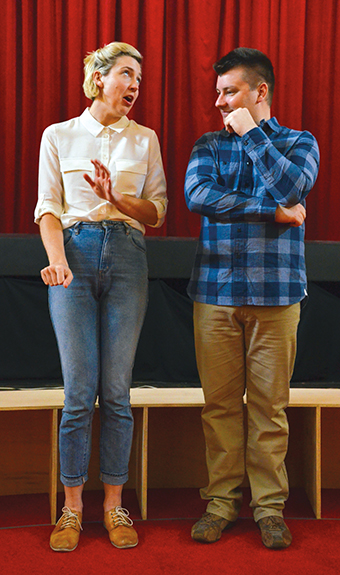
Ashton Malcolm and David Williams, Quiet Faith
photo Heath Britton
Ashton Malcolm and David Williams, Quiet Faith
A SELF-CONSCIOUS REJOINDER TO THE NOISINESS OF THE CHRISTIAN RIGHT ON THE ONE HAND AND THE SO-CALLED ‘NEW ATHEISTS’ ON THE OTHER, DAVID WILLIAMS’ QUIET FAITH WEAVES ITS MEEK PRESENCE FROM THE REAL LIFE THREADS OF THE FAITHFUL ORDINARY AND A BURGEONING CHRISTIAN ACTIVISM AS EMBLEMATISED BY THE ‘LOVE MAKES A WAY’ PROTEST MOVEMENT.
In his familiar manner, Williams recorded interviews with 20 Australian Christians of varying ages and denominations in preparation for the work and it’s their words, replicated verbatim down to every last, drawn-out “um” and “ah”, that constitute Quiet Faith’s text. The conversations Williams held with interviewees emerged from three questions: “How would you describe your journey of faith? How does faith manifest itself in your everyday life? And what do you think is, or should be, the relationship between religion and politics?”
Reviewing Williams’ program notes now, I’m put in mind of George Pell’s terse response to David Marr’s recent Quarterly Essay, The Prince: “Marr has no idea what motivates a believing Christian.” In that case, Pell was shutting the door on the possibility of a non-believer grasping such a thing; in Quiet Faith, it is Williams’ avowed intent to open it, to let a little light and air into the largely internalised beliefs of Christianity’s silent majority. It is, seemingly, a project that has been conceived with atheists and agnostics in mind, those who, like both Marr and myself, are more at home critiquing the Christian religion’s institutional failings and archly conservative social activist agenda than engaging with the views and lived experiences of everyday believers.
Williams is joined onstage by just one other performer, the significantly younger Ashton Malcolm, whose performance style provides a sometimes-jarring contrast with Williams whose approach is mimetic, soft-voiced and poker-faced, shot through with, no doubt, many of the same false starts and fillers he has detected in the responses of his interview subjects. Malcolm’s, conversely, is more embroidered, less attentive to the faltering rhythms of ordinary speech; a clear persona emerges that is warm, amused and defiantly daggy. Williams’ performance, moreso than Malcolm’s, seems calculated to drive home the dissimilarity between grassroots Christianity’s quiet emphasis on the pursuit of good works and the evangelistic social conservatism of high-profile Christian politicians like Cory Bernardi and Bob Day. Bernardi, Day and their ilk—and this, of course, is the point—seem worlds apart from the reflective, softly-spoken small-l liberals on whose words Quiet Faith is built.
“I would have said probably 10 years ago,” one of Williams’ interviewees told him, “it would have been unthinkable for a Christian in the conservative churches to not vote Liberal.” Now, such people are not only not voting Liberal in significant numbers, but are staging sit-ins at the offices of ministers on both sides of politics in protest at Australia’s continued, bipartisan policy of offshore detention of refugees.
In addition to providing a useful sketch of this shift in the relationship between religion and politics in Tony Abbott’s Australia, Quiet Faith also foregrounds the minutiae—the hymns and prayers, the church services and greetings of peace—with which the faithful daily ritualise their beliefs. Set designer Jonathan Oxlade’s rings of wooden pews, gorgeously lit by Chris Petridis’ suspended halo of lights, establish a tone halfway between intimacy and ethereality that is subtly redolent of places of worship. The performers move among, sit beside and address their dialogue directly to audience members as candles flicker here and there. At times we are called upon to stand and sing or recite—“Amazing Grace,” The Lord’s Prayer—while at other times Bob Scott’s immersive sound design, incorporating sacred organ and choir music and ringing bells, surges and then drains away. We hear, too, whispering voices: muted, indistinguishable waves of human speech that might be prayers or verses of scripture.
Finally, Malcolm and Williams embody two ministers as they debate the baptism of a stillborn baby, an act expressly forbidden by their doctrine. It is the only palpably dramatic moment of the evening and serves, inadvertently, to point up the insipidness of the preceding hour. There is no doubting the production’s elegant visual and aural design or the appeal of its careful, convincing restatement of progressive Christian values, but in its quest to achieve a meditative atmosphere Quiet Faith tends towards the simply soporific. More forgiving were the audience members who, judging by their post-performance responses, had had a Christian schooling or upbringing. Over them, at least, the work seemed to leave a pall of happy nostalgia—a mark of the successfulness of its verisimilitude, if not its ability to fully engage the uninitiated.
RealTime issue #124 Dec-Jan 2014 pg. 47
© Ben Brooker; for permission to reproduce apply to realtime@realtimearts.net
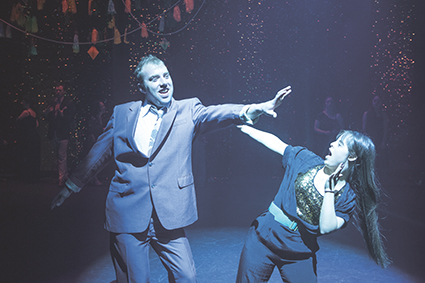
Jesse Rochow and Jianna Georgiou
photo Shane Reid
Jesse Rochow and Jianna Georgiou
IF THE DANCE FLOOR IS A DEMOCRACY THEN RESTLESS DANCE THEATRE’S IN THE BALANCE REMINDS US THAT ITS BORDERS ARE FRAUGHT WITH, IN THE WORDS DIRECTOR MICHELLE RYAN USED TO INITIATE THIS NEW WORK WITH THE COMPANY’S YOUTH ENSEMBLE, “FLIRTATION, REJECTION, INCLUSION AND EXCLUSION.” WHILE MEMBERS OF THE ENSEMBLE TAKE TO THE FLOOR IN CHOREOGRAPHIES OF ONES AND TWOS, THE REST HOVER ON THE PERIPHERY, HERE A FURTIVE EXCHANGE OF GLANCES, THERE AN INTRODUCTION MADE AWKWARD BY LOUD MUSIC OR A LACK OF CONFIDENCE.
The anxieties only dissipate, replaced by exhibitionism or exuberance or a muscular masculinity, as the performers in turn peel off from the throng and become the focus. Each brings with them a fiercely individualised energy informed by their physical capabilities, their dynamic within the group and their relationship with the space: at ease, listless, assertive. And the space itself? A glittering state of decay, designed by Gaelle Mellis and Meg Wilson that, with its fallen, shattered mirror ball and messy assemblages of hanging ropes, tinfoil and paper lanterns, recalls the apocalyptic/hedonistic bifurcation of Prince’s 1980s heyday: “Everybody’s got a bomb/ We could all die here today/ But before I’ll let that happen/ I’ll dance my life away.”
The breadth of the stylistic diversity between the vignettes and the vim with which they are performed maintains interest, even as the production’s conceptual slightness is revealed. Chris Dyke’s lurching, sexually charged athleticism provides a fine contrast, by way of an example, with Kathryn Evans’ tender, curiously touching solo routine with an exercise ball. Intermittent group work, such as when the performers chaotically transport two sets of chairs from one side of the stage to the other, provides an additional, if still inadequate, layer of complexity. The production ultimately circles round on itself, having travelled nowhere in particular, its constituent parts diverting but disconnected. There is an elusive metaphorical quality to Ryan’s direction that remains unresolved, and only tritely treated in the program notes: “We stumble, bounce and back flip on the awkward journeys we make to become who we are.” I would have been more convinced had Ryan managed to embed something of the shape of this transformation in the work’s overall contour.
More successful are Geoff Cobham’s characteristically sinuous lighting design and The Audrey’s rootsy soundtrack, equal parts alt-country languor and T Rex-ish stomp. The Adelaide band’s 2008 single “Paradise City” makes for a fitting, if unexpected, accompaniment to Dana Nance’s introspective, yearning solo: “In this town we all bear our own load,” moans singer Taasha Coates over Tristan Goodall’s plaintive guitar, “‘cause we know what’s waiting at the end of the road.” As though stirred into action by these ill-boding words, the Ensemble subsequently unites again and In the Balance concludes as it began, with a jubilant, freewheeling group choreography.
Ryan’s darker purpose, however, remains unexpressed as the audience enthusiastically applauds each member through a final, brief solo before they bounce from the stage. If only they had begun the journey that led them there from a deeper, darker place, I might have felt like I was clapping for more than just an ending already seen, a destination arrived at rather than one never left.
Restless Dance Theatre, In the Balance, director Michelle Ryan, performers Josh Compton, Darcy Carpenter, Felicity Doolette, Chris Dyke, Kathryn Evans, Jianna Georgiou, Michael Hodyl, Lorcan Hopper, Nigel Major-Henderson, Caitie Moloney, Dana Nance, Jesse Rochow, Tara Stewart, lighting designer Geoff Cobham, designer Gaelle Mellis, Meg Wilson, music the Audreys; Odeon Theatre, Adelaide, 16–25 Oct
RealTime issue #124 Dec-Jan 2014 pg. 36
© Ben Brooker; for permission to reproduce apply to realtime@realtimearts.net
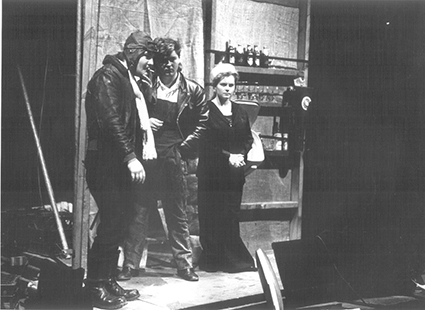
The Merry Wives of Windsor, Director George Mannix, PACT, 1988
JENNY NICHOLLS, FORMER PACT ACTOR, DIRECTOR AND BOARD MEMBER, HAS WORKED AS A TEACHER, THEATRE DIRECTOR AND CONSULTANT FOR THEATRE COMPANIES AND EDUCATIONAL INSTITUTIONS AND SAT ON THE DRAMA COMMITTEE OF THE AUSTRALIA COUNCIL IN THE LATE 80S. SHE’S A SENIOR LECTURER AT THE INSTITUTE OF EARLY CHILDHOOD AT MACQUARIE UNIVERSITY, SYDNEY. MORE THAN THAT, SHE GREW UP WITH PACT FROM THE AGE OF 13.
When, on the occasion of PACT’s 50th birthday, I interviewed Nicholls—who still recalls those early years with exuberance—it became clear that PACT had shaped her life and career, as it has doubtless done and still does for many others.
Originally housed on the edge of the Sydney CBD, near Darling Harbour, PACT was founded by a group led by Robert Allnutt, Jack Mannix and Patrick Milligan in response to the Federal Government’s Vincent Committee Report that “highlighted the dire state of Australia’s performing arts, film and television industries.” PACT (Producers, Authors, Composers and Talent, and later Producers, Artists, Curators, Technicians) aimed to develop a range of practitioners who would enrich Australian culture.
Central to Jenny’s experience of PACT was Jack Mannix, whose sense of community was shaped by the Depression and by the Catholic School Fellowship which encouraged young people to get involved in social activities in the 1930s. Thirty years later, when Jack teamed up with Patrick Milligan (Spike’s brother) and Bob Allnutt an ABC producer to form PACT, she says, “I think Jack’s mandate was to bring young people into the organisation and it was inherently about cultural leadership and access—and culture as a way to drive change as much as it was about an aesthetic. He felt there needed to be a way to be innovative.” There were PACT folk concerts, playreadings, a sub-group that called themselves The Leper Colony and a psychedelic theatre group, The Human Body, at a time in the late 60s when Australian playwriting was emerging.
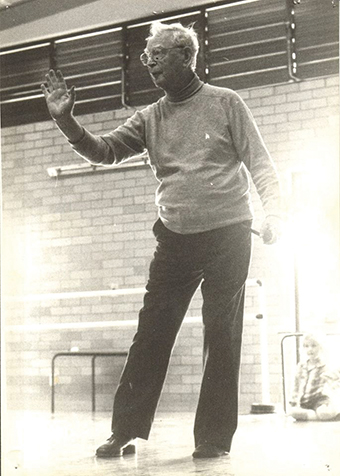
Jack Mannix
Nicholls joined PACT in 1974 when free drama workshops were offered to teenagers. “Jack was very keen to bring in kids who didn’t have much access to culture. Culture! I use the term very broadly. I grew up on the northern beaches and I didn’t have much more access to culture than a kid from Fairfield really. I had the beach. No drama in schools. Virtually no after-school creative activity or anything like that.” Nicholls and 200 teenagers were introduced to “the great Australian do-it-yourself pantomime.” Not the English model. “No script. It was all up and down improvising, ‘OK, you go next… OK, now you swap parts.’ We were divided into groups according to where we lived and participated in three-day workshops over the school holidays. Between August and Christmas the groups alternated on weekends to rehearse and then five productions went on simultaneously throughout Sydney in late December.”
As well as going to PACT on Saturdays each week, Nicholls found herself attending Wednesday night events, mixing with older participants, many of whom were studying at university, “experimenting with poetry, movement sequences, sound, lighting, somebody walking slowly up a ladder while somebody else was reading a poem…” Later these became events titled Abstractions.
“Even though I wasn’t particularly aware of it at the time, I understand now that it was so much about aesthetics.” She quotes George Mannix (Jack Mannix’s son) from a speech at the PACT 50th Birthday celebration on 11 October, “People in the room knew something extraordinary was being created. You could have been acting or waiting your turn or doing the lighting or the music but we were all thinking, ‘Wow,’ this is amazing.’”
“PACT shouldn’t necessarily be privileged here because I think ATYP (1963) and Shopfront (1977) were also emerging. What was interesting however was that PACT moved from being a venue for folk concerts and playwrights to ‘This is great but we need more, we’ve got to do things on a bigger scale, we’ve got to get out to the suburbs and get young people in.’
“In 1976 we took the pantomime to the Chapter House at St Andrews Cathedral for a four-week season as part of the Festival of Sydney. At other times PACT would say, ‘We’ve been invited to take the pantomime to Telopea in the September holidays; who wants to do it?’ So those who volunteered would be packed off in a truck with somebody who had a driver’s licence and we’d turn up at a school or hall or whatever, put plastic black-out on the windows with gaffer tape, set up the lighting box and the reel-to-reel music and off we’d go. What an introduction to theatre at 15-16!
“I was growing up with PACT,” says Nicholls, as the organisation itself was developing its vision. She remembers being in Mannix’s productions of A Midsummer Night’s Dream, describing it as “environmental theatre.” It too was performed in the Chapter House, “a beautiful space—making use of the stairs and the balcony above with the audience on the floor and actors moving in and around them. Before that we did Eros and Thanatos based on the writing of [Marxist philosopher Herbert] Marcuse. We performed that downstairs at the Seymour Centre.”
Nicholls had become more than a participant: “The way the pantomime worked was that whoever did it the year before taught the next group coming in. Very privileged for me when I look back. At 14 I learn it and at 15 I’m teaching others.” There was only a scenario for the pantomime: “It was about a schoolteacher who didn’t like children and who was informed by a goodwill spirit that he had to put on a pantomime so he could learn to appreciate children. On the way he meets a whole lot of funny characters. It was interactive so at any moment you would have anything from 50-100 children on the floor of a hall and during the performance the children would be up and doing things—pretending to play a game of football or dancing around Cinderella’s coach, or holding up Jack’s beanstalk. Not only was I learning about aspects of theatre i was learning about children.”
Nicholls spent her teenage years with PACT. “We toured to Byron Bay, Canberra Theatre Festival. Then we started going out west—Dunedoo, Condobolin, Deniliquin—doing pantomimes and other performances—The Hobbit, Under Milkwood. By Year 12 I had to step back—Jack didn’t want anyone in Year 12 performing.”
So what was life like post-PACT? “After the HSC I had to decide what I was going to do. Am I going to work in theatre or is this place my family? And it had been my family. When I started at PACT I don’t think I knew much about what university was really. But according to Jack, all of us kids were going off to university—it was the Whitlam years—and we did. Well, not everybody but it was expected.” Clearly PACT itself provided quite an education: “You can just imagine hearing all these poets being talked about and quoted in performances—like TS Eliot. At 15 I knew the entire script of Midsummer Night’s Dream. We all did. I played Helena one year and Puck another year.” Nicholls chose the University of New England in Armidale: “In 1979 there were few universities offering a drama course with a strong practical focus.”
Drama at university was quite different from PACT: “I loved it. It completely challenged me because suddenly I’m doing warm-ups in drama classes. We never had warm-ups at PACT. At PACT it’d be, ‘If you want to get to know each other, go into the office and have a coffee’ and ‘Now we’re rehearsing.’ At uni it was great, full-year drama courses, sometimes two a year from Ancient Greek classics right up to “read two Australian plays a week, discuss them and write our own!”
In her final year Nicholls re-connected with PACT: “George rang me to say that he couldn’t go down to Berrigan in the South-West Riverina with the PACT production this year, would I like to. By now I’d finished my degree and had my teaching diploma. So I went and did something similar where I created a show with young people over three weeks. This led to a 12-month teaching appointment as a drama consultant in the Riverina.” The following year Nicholls was accepted into the directors’ course at NIDA, even if short on some of the technical audition demands. “I tell this story to my students. I didn’t need to be an expert in everything. I needed to have a vision, which is in fact what Jack had and everybody came along with his vision. I don’t put myself in Jack’s category but I think I’m visionary and innovative in my work.
“So I went to NIDA for a year, was an Associate Director at STC for 12 months, did some work for Jigsaw Theatre Company, travelled overseas for 12 months and came back to be met at the airport by current PACT staff and friends who asked me to work as artistic co-ordinator. And so I did. It was half time, not even that. PACT received a tiny amount from the Australia Council. I supplemented that by doing casual teaching and I helped organise the transition from Sussex Street to Erskineville, when we got kicked out.”
IN 1989 Nicholls staged the first full-scale production in the new PACT home in Erskineville, Playing for Time, an Arthur Miller film script—based on the life of Fania Fénelon, a Jewish prisoner of war in Auschwitz who formed an orchestra in the camp. Beginning outside the theatre, Nicholls separated the audience from their partners and moved cast and audience around like inmates. This ‘environmental’ tradition continues to this day at PACT with the constant, inventive reconfiguring of the space and its outdoors.
By 1990, says Nicholls, “I really couldn’t survive any more on a part time salary. I completed a Masters Degree in Theatre Studies at UNSW and was offered the opportunity with Sydney College of Advanced Education, teaching drama courses—and I was getting paid well.” The SCAE was amalgamated with Macquarie University and Nicholls moved into the area of Early Education. She says her teaching over many years is still grounded within the artistic philosophies of her years in PACT. In 2008 she was awarded a citation for outstanding contributions to Student Learning by the Australian Learning and Teaching Council for her innovative work in student engagement in drama and online technology.
Nicholls was on the PACT Board when Jack Mannix died in 1989: “He had a heart attack and was on life support for a while. I can remember everyone was running in and out of his hospital room playing music and singing pantomime songs, combing his hair…He hated having messy hair.”
I ask Nicholls to describe Mannix. She responds thoughtfully, “I think he was a visionary. He had extraordinary patience and a great relationship with young people. We thought he was the opposite of a father or grandfather figure; he was just an amazing adult. I don’t think anybody thought that he was particularly old. He just was. He smoked a pipe. The way that he created shows with young people was extraordinary—the discipline he demanded, the self-confidence he developed in kids from all backgrounds; and the ideas he introduced us to—art, literature, music. It was about getting young people to rise and rise to the best of their ability. I think that for a lot of people who’ve left PACT and gone on to make their own creative work, that’s [something they took with them.]
“And it was also about making beauty. George and I were talking about this last night and he said, ‘It’s hard to talk about beauty now. We talk about truth when we go to the theatre.’
“Jack was caring and gentle and absolutely of the belief that culture should be accessible and people should be able to have the opportunity to participate in the making. He said it better: ‘instrumentation of creativity.’ He was also very inclusive; nobody was excluded; there were no auditions, no try-outs. It was just that gentle way he had of saying, ‘You try reading Helena or you do Bottom.’ He just intuitively knew.”
Jenny Nicholls completed her many years with PACT by becoming Chair of the PACT Board FROM 1988 to 1994. She reminds me at the end of our interview, that her story is only one of hundreds from young people who were introduced to theatre (and so much more) at PACT.
In RealTime 125 (Feb-March 2015) we’ll look at the years since and the artistic directors and teachers who have maintained the PACT vision in their distinctive ways.
RealTime issue #124 Dec-Jan 2014 pg. 37-38
© Keith Gallasch; for permission to reproduce apply to realtime@realtimearts.net
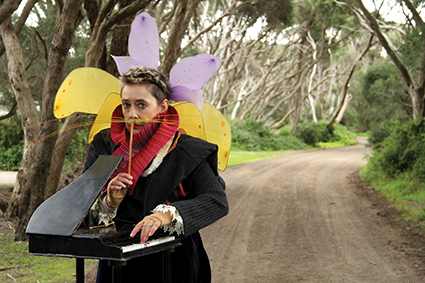
Margaret Cameron, Opera for a Small Mammal, Chamber Made Opera
photo Daisy Noyes
Margaret Cameron, Opera for a Small Mammal, Chamber Made Opera
UNFORGETTABLE, WHETHER WHEN WE FIRST SAW HER IN 1986 AT PERFORMANCE SPACE IN ULRIKE MEINHOF SINGS, DIRECTED BY NICO LATHOURIS, OR ON THE MAINSTAGE IN JENNY KEMP’S PRODUCTIONS OF CALL OF THE WILD (1989) AND JOANNA MURRAY-SMITH’S NIGHTFALL AT THE SYDNEY THEATRE COMPANY IN 2000 OR, ABOVE ALL, IN HER OWN THINGS CALYPSO WANTED TO SAY (1990) AND KNOWLEDGE AND MELANCHOLY: AN AUTOBIOGRAPHICAL FICTION IN 2004, AGAIN AT PERFORMANCE SPACE.
We wish we’d seen her later performances and more of her acclaimed directing, which we first glimpsed in Aphid’s 2003 puppet-play trilogy A Quarreling Pair and last witnessed in Chamber Made Opera’s Minotaur The Island, for which she also provided the text for David Young’s composition, in the Aurora Music Festival in 2012 in Sydney’s west.
Acting, directing, writing or just being, Margaret was a dynamic presence, at once authoritative and intimate. Her idiosyncratic weighting of words, the lateral lilt of her sentences and that distinctive tone, all at one with her art, will long be recalled and treasured.
Keith & Virginia
In the archive
The RealTime archive includes responses to Margaret’s work and an article by her, “Art & care: where life and death connect”, which she wrote for us in 2013 in RT117.
Margaret on acting
Virginia Baxter’s hithero un-archived 2000 interview, “The other side of Nightfall” (RT 37, p29), with Margaret and fellow actor Ian Scott, also appears in the November edition of Profiler. It’s a wonderfully incisive account of the nature and complexity of acting in general and in response to Joanna Murray-Smith’s play Nightfall, Jenny Kemp’s direction and Elizabeth Drake’s score.
In Nightfall, Margaret and Ian play a middle-class couple, Emily and Edward whose daughter Cora (Victoria Longley) disappeared when she was 16, assumed abducted. But seven years later a go-between, Kate, arrives to negotiate the return of Cora—who is revealed to have left home of her own accord. In most respects Nightfall is a conventional play, well crafted, suspenseful and morally complex, but Cameron, Scott and Kemp made it something more in the perturbing rhythms of the playing. Cameron’s approach brought the same kind of subtle attentiveness to a naturalistic play that she would to an experimental work with powerful results.
Here are two excerpts that tell you something about Margaret and her art.
“The approach to the play for me was a matter of the whole body physically listening. The listening body is like an animal: you can get caught, suspended; you’re hunting the sense and the emotional sense. Jenny Kemp is a very good director for me in that she loves to see that. If you get stranded halfway, held in space, Jenny’s in a state of delight because it’s dangerous. She credits the invisible world. She understands it as present.”
“[Emily’s] emotional/physical world is adrenalin, huge expectation and capping and locking a terrible fear that things might not be all right. It’s a paradox she starts with, an expectation equaled by massive fear. And they’re balancing each other. That’s her place. And she keeps working towards the belief that Cora will come in that door at any moment. She’s sincerely trying to help Kate. And the pressure will shift me around emotionally so that if on a particular evening there might be a point reached in the graph, which is a little bit unexpected or the intensity is less than last night, what happens is that it goes somewhere underneath. It’ll curve around and sort of push you in another sequence. So you’re playing the essentials every night but where they occur is moveable and very volatile. It’s quite frightening to perform.”
RealTime issue #124 Dec-Jan 2014 pg. 38
© Keith Gallasch & Virginia Baxter; for permission to reproduce apply to realtime@realtimearts.net
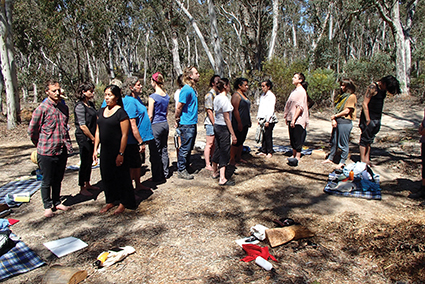
TimePlaceSpace
photo courtesy Performance Space
TimePlaceSpace
FROM 26 SEPTEMBER TO 12 OCTOBER, THE TIME_PLACE_SPACE LABORATORY TRAVELLED FROM SYDNEY TO KANDOS, GANGUDDY/DUNN’S SWAMP, CANBERRA, NARRANDERA AND BACK TO SYDNEY. EVERYONE INVOLVED, AND INDEED EVERYONE WHO CAME INTO CONTACT WITH THIS TRAVELING EXPERIMENTAL ART LABORATORY AROUND REGIONAL NSW WAS UNANIMOUS IN ADVOCATING THE WONDERFUL VALUE OF THE PROJECT.
Despite numerous debriefings with participating artists in the weeks since, however, there’s a difficulty in articulating what the experience means.
By virtue of the democratic structure and Open Space philosophy that governed our time together, the lab possessed a genuine responsiveness that allowed everything to be adaptable according to the desires of the 20 diverse artists present, as well as the facilitators and provocateurs. This included everything from how and where we lived together, to how we should work together, and on what exactly we should work. Working time (there was an incredibly vocational attitude taken by all involved) was split between collaborative making between artists within the specificity of the locale and situation, and artists running workshops.
Workshops were not about teaching per se, but about sharing and responding, about seeing how different practices and outlooks speak to your own, and how yours speak back. The true value of the trip can perhaps be located within this conviviality, in the self-reflexivity the time provoked in us as individuals and as a temporary community. Away from normality and everyday lives (including the internet, which was sadly a significant factor), we were away from a knowingness of our methodologies. In this space we were able to shine light on the unknown unknowns of our own and others’ practices.
These unknown unknowns began to become transparent in an exercise early in the laboratory with provocateur Karen Therese. Karen’s exercise was itself a throwback to the very first Time_Place_Space that she participated in as an artist in 2002. We shared with each other our individual artistic manifestos and then commenced quick-fire performed manifestations of these there in the bush with each other. How was the work we were making out here different and how was it the same? What does this work reveal and not reveal about us as artists, and about the world today? How do we decide what to do and what not to do?
What we were doing was symbolically epitomized a few nights later when artist Megan Cope undertook a “toponymic intervention,” projecting the Indigenous name for the land on a rockface of the Cudgegong River, Ganguddy. It was inspiring, not just in terms of reclaiming Australia’s geographical places, but also in terms of what this trip was about. We were not traveling to colonise, but to decolonise. We were decolonising our own practices. We were peeling back layers of methodology and understanding established over time.
Time_Place_Space: Nomad was about having a look at what it is we really do, with all known frameworks stripped away. We were decolonising time, place, space and the act of thinking for each other, and were doing so through our work. We were also doing this for the members of the public we encountered on the trip, through sharing and collaboration on what we were up to. A Xanadu Swamp processional-art-rave at Ganguddy/Dunn’s Swamp was followed by a number of events and exchanges in and around the Narrandera showgrounds the following week.
It feels fair to say that this process created a degree of doubt in all who participated—the sort of doubt that takes place before the self-examination that leads to transformation. A safe space to raise such doubts and such self-examination is certainly a good thing, even if it is a struggle to articulate what that good thing actually is. No wonder then that it has been difficult to articulate the outcomes, for the outcomes are incredibly personal and shifting revelations of personal traits and dispositions.
Performer and video, sound and installation artist Zoe Scoglio wrote of “a shifting of my axis, a broadening of my points of reference, an exciting newness that I’m eager to see unfold in my practice…re-affirming the importance of aligning one’s way of living with one’s artistic ideology.” Artist Mish Grigor (performer and member of post) found a similar fascination in “the way that the lines between art and life became increasingly blurry” across the laboratory, noting “by the end we were a nebulous cult society, where every meal had a conceptual framework.” These meals included Fluxus “Identical Lunches” by TPS provocateur Song-Ming Ang (a Singaporean live artist/ musician) and a dinner led by cross-disciplinary artist Tessa Zettel made entirely of food bartered for, foraged and found. Mish too wrote of an enthusiasm for the more concrete outcomes of the lab, without knowing what or when they might be: “[TPS] required serious consideration of every moment’s possibilities. It will be interesting to see what repercussions it has for the structures, communities and artworks that we operate within over the next couple of years.”
Weeds advocate, forager and artist Diego Bonetto offered a spirited provocation towards realising the outcomes of the lab: “Fuck manifestos! Fuck channelled visions, however well-meaning and educated they might be. Fuck defined, preconceived and goal-oriented efforts. Humanity needs to be much more fluid than that, adapting and fast moving, unpredictable and crafty, ever changing, finding communal visions and driven by constant questioning.”
It was this constant questioning that drove our decolonising. It drove our composting and sambal, our drones and rock sundials, our tyvek bubbleheads and twilight choreographies, our evacuation procedures and boguing, our hammock time and bird watching, our mobius spiralling and silent walks, our wombat poo necklaces and shadow play, our nature dying and heavy drinking. It was our constant questioning that drove more questions to arise—about climate change and how we live, as much as any about artistic practice.
A communal vision was found in Time_Place_Space: Nomad that exemplified the connections and culture that can be made in a relatively short amount of time when privileging process, which doesn’t happen this way in metropolitan contexts. We realized this decolonised vision together, as artists, researchers, zealots and playful children. Special mention must be made of co-curators Bec Dean and Angharad Wynne-Jones for making it happen. In the end, we all drank the kool aid together and returned to our respective versions of the ‘real world.’ Changed, somehow. Nascent projects and processes latent for action. The answers to most questions are still TBA, possibly forever. Not least for me: What do you really mean when you use the word ‘amazing’? And, how exactly do you find an ending?
http://time-place-space.tumblr.com
Time_Place_Space: Nomad is an Australia Council initiative to invigorate interdisciplinary and experimental arts practice in Australia, with an emphasis on collaborative performance-making, site-specificity and artistic resilience. The first six laboratories were managed by Performance Space, 2002-09.
Australia Council for the Arts, Time_Place_Space: Nomad, co-production Performance Space, Sydney, Arts House, Melbourne, participating artists Connie Anthes, Diego Bonetto, Megan Cope, Mish Grigor, Sophea Lerner, Jamie Lewis, Jessica Miley, Fee Plumley, Greg Pritchard, Bhenji Ra, Zoe Scoglio, Ria Soemardjo, Latai Taumoepeau, Nathan Thompson, Jade Dewi Tyas Tunggal, Malcolm Whittaker, Tessa Zettel, Julia Carr, Joshua Jackson, Helen Yung; provocateurs Song-Ming Ang, Lee-Ann Buckskin, Karen Therese, Lee Wilson; facilitators Bec Dean, Angharad Wynne-Jones, Richard Manner, Michael Petchkovsky, Sophie Kitson, Kate Brown, 26 Sept-12 Oct
RealTime issue #124 Dec-Jan 2014 pg. 39
© Malcolm Whittaker; for permission to reproduce apply to realtime@realtimearts.net
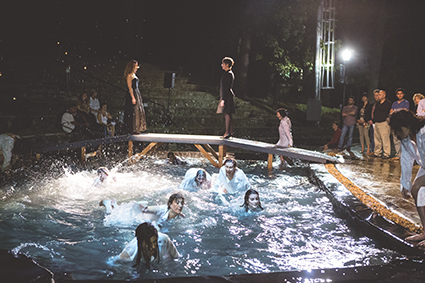
Imagining O
photo Marina Levitskava
Imagining O
THE MEETING POINT FOR REHEARSALS FOR RICHARD SCHECHNER’S PERFORMANCE WORK, IMAGINING O, BASED ON PAULINE RÉAGE’S CHARACTER O FROM HER CONTROVERSIAL 1954 NOVEL, STORY OF O (WHICH SCHECHNER DESCRIBES AS A LOVE POEM) AND HAMLET’S OPHELIA—WITH A FEW ADDITIONS FROM SOME OF SHAKESPEARE’S OTHER FEMALE CHARACTERS—WAS THE DIRECTOR’S OFFICE AT NEW YORK UNIVERSITY.
Adorned with ancient masks, photos and thousands of books from his many years as Founder and Professor of Performance Studies at Tisch School of the Arts, the office is the nerve centre of The Drama Review and the home of the brain behind the birth of the Wooster Group/Performance Group in the 1960s and is crammed with an eager cast from around the globe. Fourteen women and one man are all ready to dive into an intense six weeks (six days a week) working on Imagining O. All set for an investigation of sexuality, abjection and power and one of those ensemble experiences where people respect each other’s work and where you are given freedom to exercise your creative imagination. How often does that happen in life?
Richard greets me with a warm hug. We had last seen each other the previous year in Brisbane where my company, Tashmadada, had invited him to conduct a four-day Rasabox master class at the World Theatre Festival. Schechner devised the Rasabox training in the 1980s-90s, based on the Natyasastra, an ancient Indian text on stagecraft. It’s a training methodology to give performers concrete physical tools to access, control and communicate eight key emotions for performance. It was an essential part of the rehearsal process: when working on scenes, Richard would prompt us with a specific ‘rasa’ to explain an emotion he was searching for—or a phrase of dialogue. Some chunks of text had a different ‘rasa’ for each sentence—or even within one sentence.
I jumped right in—straight onto the floor and working physically. And straight into the transgressive subject matter of O—a character whose sexual fantasies involve unusual “alterations” of the body. No room for puritans in O’s cupboard. Not that this particular ensemble needed much prompting, everyone displayed great ease with their bodies. Richard, at the epicentre, created an environment in which trust, bravery and a feeling of ‘I can do anything’ existed. inhibitions dissolved quickly.
Each day for the next six weeks started with yoga—a specific form that Schechner has been practicing daily since the 1970s—and he is testament to its effectiveness. At age 80 the mind is sharp and the body still flexible—he often sits in lotus position. It’s a yoga series given to him by his Indian teacher and is invigorating without being too strenuous. As well as physical poses, the yoga includes vocal work and a very particular breathing series, which required tissues at hand.
After the daily trip to the Alexander Kasser Theater in Montclair, where the rehearsals took place (necessary for this site-specific promenade work) and the performances were to be staged and hosted by Peak Performance Festival, we were fuelled by caffeine and a passion for the new found material. Lunch was sporadic and dinner at 10 pm after coming back to Manhattan—who cared as the days were full of stimulation.
One of the daily theatre exercises included crossing from one side of a defined space to the other but infused with specific instructions. The exercise was a template for exploring all sorts of ideas—such as Schechner’s interest in slow motion as a tool to train the body, focus the mind and to create intense relationships between members of the ensemble. One variation saw us crossing the space as slowly as we possibly could (with Richard side coaching us to go even slower) and, on meeting each other, slowly swapping clothes. After the clothes swap we could continue our extremely slow walk. If not all clothes were swapped we had to be totally still until the exercise was over. It took at least an hour to cross the small space and it engaged every muscle in my Suzuki trained body, tested my focus and challenged my tenacity—all of which, until then, I had felt were strong.
United by the training regime and collective film shoots around Manhattan—including filming some of us performing movement sequences as we plunged into the waters off Coney Island, and on an early morning train in our ‘dressed to kill’ clothes—the ensemble forces grew stronger and the groundwork was laid for us to devise our own material. At one stage, in the final performance, the audience needs to perform tasks in a carnival scene before being allowed to progress to the next stage of the show. I ended up on my back on a specially made see-saw exhorting members of the public to feed me real flowers—they weren’t shy and I often had a number of them at once stuffing as many into my mouth as they possibly could (that image ended up accompanying the glowing reviewof the production in the New York Times, 12 September).
We were charged with devising solo pieces, our ‘dispersals,’ to explore whatever interested us in relation to the themes of Story of O. I was more than ready to abandon myself to whatever boundaries were to be transgressed. Thematically, I was particularly interested in the physical and emotional decomposition of both the O and Ophelia and their ultimate demises. My piece involved an atmospherically lit bathroom (thanks to lighting and set designer Chris Muller), hanging flowers, dripping liquid, a soundscape, a naked body (slightly faulty) and instructions for the audience to draw on my skin. I won’t say more as I am developing this into a durational piece.
Six weeks living and breathing with a power ensemble of gorgeous and talented women, of immersion in the art of Richard Schechner, one of the fathers of avant garde theatre (he is a grandfather now) with his lively, curious, razor sharp mind and endless energy, has breathed such life into my own being that I will treasure the experience for a long, long time to come. The sold-out shows for Imagining O have provided great external recognition but nothing compared to the internal emotions and sensations still resonating in my body.
Peak Performances: Imagining O, rehearsals commenced 4 Aug; season, Alexander Kasser Theater, Montclair State University, New Jersey, 10-14 Sept
RealTime issue #124 Dec-Jan 2014 pg. 40
© Deborah Lieser-Moore; for permission to reproduce apply to realtime@realtimearts.net
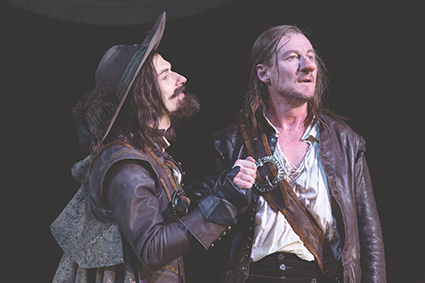
Yalin Ozucelik, Richard Roxburgh in Sydney Theatre Company’s production of Cyrano de Bergerac
photo © Brett Boardman 2014
Yalin Ozucelik, Richard Roxburgh in Sydney Theatre Company’s production of Cyrano de Bergerac
IN ONE WAY OR ANOTHER, THREE PRODUCTIONS IN SYDNEY IN RECENT WEEKS—TWO OF THEM OF NEW AUSTRALIAN PLAYS BY WOMEN ABOUT WOMEN AND ONE A CLASSIC BY A MALE ABOUT A MALE—SHARED A REVEALING FOCUS ON PERFORMANCE. CYRANO DE BERGERAC, A FEMALE STAND-UP COMEDIAN AND A FAMOUS NOVELIST, PATRICIA HIGHSMITH, ALL BECOME EMOTIONALLY UNSTUCK WHILE ATTEMPTING TO SUSTAIN PERSONAE THAT MASK VULNERABILITIES.
STC, Cyrano de Bergerac
A man of enormous pride and charisma, a popular poet and accomplished swordsman, Cyrano de Bergerac nonetheless dooms himself to misery in the belief that he is unloveably ugly. Richard Roxburgh as Cyrano delivers the requisite crowd-pleasing bravado with panache and deals his enemies just the right degree of cruelty, verbal and physical. But, deftly and incisively, Roxburgh reveals the cracks early on—a palpable fragility, sentences that come unstuck when Cyrano’s not on show—preparing us for a darker, less melodramatic demise than usually anticipated: a tragedy imbued with a touch of the manic depressive.
Eryn Jean Norvill’s Roxane appearing at first a delicate flower is soon shown to be intelligent, forthright and physically robust—an ideal partner for Cyrano, if only… Chris Ryan’s Christian is a charming innocent, played with a kind of engaging Ocker ease. Josh McConville’s Guiche is convincingly both scary and comic. The mobile 17th century stage within the Sydney Theatre’s large open space presents numerous opportunities for lively staging and amplifies the sense of performance that is Cyrano’s outer world; the inner one he cannot enact. Sharp-eyed, witty direction and economic adaptation (Andrew Upton), fine period design (Alice Babbage), an immersive sound world (Paul Charlier), characterful casting and a superb Roxburgh all made for a seriously memorable Cyrano de Bergerac.
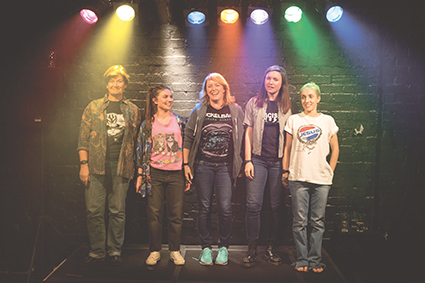
Cast: Fiona Press, Madeleine Benson, Susan Prior, Nat Randall, Genevieve Guiffre, Is this thing on?, Belvoir Downstairs
photo Brett Boardman
Cast: Fiona Press, Madeleine Benson, Susan Prior, Nat Randall, Genevieve Guiffre, Is this thing on?, Belvoir Downstairs
Belvoir, Is This Thing On?
The very title of Zoe Coombs Marr’s Is this Thing On?, a riotous depiction of the life of a female stand-up comedian, Brianna—played by five actors across her life—is telling. If the mike is not on, what next? Or what if you stand before it and you can’t speak—that’s the very first and very young Brianna (Madelaine Benson) we see. The stage is then seized by an MC (Susan Prior) who treats us as comedy club innocents, spitting out bad jokes, letting us know she also works the bar, gossiping about fellow comedians.
The script loops back to a younger Brianna, Genevieve Giuffre, finding her way in stand-up, studying veterinary science, and then another, Nat Randall, more confident, dropping out of university, coming out and unleashing a string of crudely funny, discomfiting fisting jokes. An older Brianna (Fiona Press), back in the business after a breakdown, is relaxed, cynical, the jokes grosser, still working the bar, prone to anger, violence even against a male comedian friend who left her show stranded.
It’s Susan Prior’s Brianna who cracks—she’s unstoppably frantic, barely leaving space for laughs in case there’s silence, bullying her audience, relentlessly on the move, no longer able to veil the anxieties breaking through an already unstable comic persona. It’s an unnerving performance, loud and rarely funny in a conventional sense.
Zoe Coombs Marr writes in her program note, “Since we first met, comedy has been like a charismatic but occasionally abusive lover that I haven’t quite been able to turn away from.” A member of post and a solo performer, Coombs Marr started out in stand-up when she was 15. Is This Thing On? is a grimly articulate account of engaging with your craft, its limits, dangers and a little of the joy of connecting with your audience, and it achieves this by doing it—making us witness how stand-up does and does not work and the pressures that build behind confident facades. There’s little detail in the show about life beyond stand-up, like family or love—save the charismatic abuser mentioned above, comedy itself—but fragile self-love and the courage to perform to make an audience love you, these are revealingly and depressingly on display.
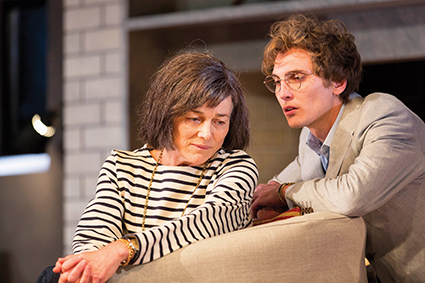
Sarah Peirse and Eamon Farren in Sydney Theatre Company’s production of Switzerland
photo © Brett Boardman
Sarah Peirse and Eamon Farren in Sydney Theatre Company’s production of Switzerland
STC, Switzerland
Actors and stand-up comedians are public performers, writers are deemed private if increasingly having to front their audiences at writers’ weeks and in the media to ensure book sales. The great American crime writer Patricia Highsmith, self-exiled to France and then Switzerland after having felt underappreciated at home and finding herself much admired in Europe, did her fair share of interviews, but not always agreeably. She was even less amicable socially as she grew older and irascible in private. For all her many friends, numerous female lovers and several sustained if fragile relationships, Highsmith seems to have been a loner of a kind with her racial prejudices and fetishes, including a love of snails, fascinated as she was with their sex lives, keeping them in a pocket or leaving them about her house. The oddities of her Texan upbringing, the eternal tensions between herself and her mother, her New York youth and early career (as a well-paid comic book writer during world War II), a promiscuous life in the lesbian community and the failure to break through into the pages of The New Yorker, all combined to create a distinctive personality, bristling with contradictions (Jewish good friends, flirtations with men) which yielded an acute alertness to moral ambiguity with insights into double lives, jealousy and criminal desire—principally realised in the form of her male characters.
Joanna Murray-Smith conjures up Highsmith’s final days in a Swiss mountain ‘bunker,’ alone, bitter and alcoholic, dealing with a young publisher’s representative determined to coax her into writing another Ripley novel. The previous envoy suffered a breakdown, believing that Highsmith had threatened him in his bed with a knife. The new arrival appears to be destined for the same, or worse (he wakes with a nick on his neck). For all his naivety—he can’t handle Highsmith’s caustic wit and relentless abuse—he is oddly determined, eventually finding his way to break through, largely through discovering a shared blokey interest in guns and then urging the writer to improvise the opening scenario for a new Ripley novel, which she does, but imposing on him the responsibility of deciding how the murder is committed—a decision she will regret since it will play some part in the young man’s transformation—a very Highsmith one.
Switzerland is an entertaining and suspenseful two-hander. Sarah Pierse is an ideal casting choice as Patricia, not only having something of the look of Highsmith about her, but with her slight drawl, her staggered walk and a pained stoop she conveys both old age and something predatory. It’s a shock when, alone, she dances falteringly to a beloved show tune (one of the real Highsmith’s pleasures). Eamon Farren’s young man, Edward, has the indeterminant demeanour of a Ripley, his persona mutating across the play’s three acts—innocent, then manipulatively probing and then… Like Ripley, he’s a performer. In Act One we believe him, his American clichés failing to cut though Patricia’s well-established obstinacies and prejudices. In Act Two, he’s a touch smarter, doubt creeps in.
The three-act structure is not perfect. Act Two, instead of following up on the cut the young man finds on his neck in the morning and entwining it suspensefully with what follows, moves rather expositionally on to everything we need to know about Highsmith, with a consequent slackening of pace and suspense if interesting in itself (her obsessions, paranoias, her objections to America etc) and providing some fuel for the young man’s machinations (guns, vulnerabilities). Act Three begins strikingly, some of the audience laughing with surprise at something as simple and so telling, plot-wise, as a costume change.
If you buy the conceit that Highsmith finds herself trapped in a plot very much like the ones she wrote, then you’ll be satisfied with Switzerland, but you wouldn’t want to think about it too much. A long-term Highsmith fan, I greatly enjoyed Switzerland, despite Act Two’s slackening and Act Three’s less than inventive ending; the performances are engrossing and there are moments when Murray Smith captures Highsmith’s creepily crystalline way of describing the world and her capacity to throw us into moral confusion.
Unfortunately, the inner-dramaturg on automatic, I thought too much about Switzerland and had to ask some difficult questions. Is Patricia Highsmith, who has told us so much about criminal minds and readers’ perverse desires (for Ripley to ‘get away with it,’ or “the complete corruption of the reader,” as Patricia puts it) and who was cruel but never herself a criminal, due the punishment Murray Smith deals her? What kind of wish fulfilment is going on here? Secondly, why run with the obvious Highsmith formula—why not replace Edward with a young woman who might re-ignite a spark of sexual desire in the dying Patricia and make more pivotal and more ambiguous the “You excite me!” passage in Act Three.
Highsmith kept her writing about women discrete from her crime writing in the non-crime novels and in Carol, her ‘lesbian’ novel, but here’s an opportunity to bring the two worlds together that co-habited the writer’s psyche. When Patricia, who obstinately lives in the past, asks Edward to speak to her of New York diners and the young women who lunch there, he informs her that there are very few diners anymore—and that young women have changed “Don’t do that!,” she snaps, upset. Patricia lives in the past—in my Switzerland she would be confronted by the present as it was in 1995, the year Highsmith died. Different play, different writer, but questions worth asking and which tell us something about the conservative nature of Murray Smith’s otherwise admirable venture.
Few crime novels are perfect, onstage crime plays even fewer, but fans, as with most genre writing, are forgiving. Also Switzerland is pleasantly not unlike seeing a movie in a cinema: it’s wisely interval-less, the soundtrack like a moody film score (initially a distant, piano and lush strings, later dramatic big guitar and continental mandolin) and it has a low ceilinged ‘widescreen’ ultra-real set—apparently a replication of Highsmith’s final home, replete with the loved portrait of her younger self, thumbs up, in red. Switzerland is a cosy, intelligent entertainment, blessed with an excellent performance partnership in Peirse and Farren directed by Sarah Goodes.
Sydney Theatre Company, Cyrano de Bergerac, writer Edmond Rostand, adaptation, director Andrew Upton, original translation Marion Potts, Sydney Theatre, 11 Nov-20 Dec; Belvoir, Is This Thing On, writer, director Zoe-Coombs Marr, co-director Kit Brookman, design Ralph Myers, Belvoir Downstairs, 2 Oct-2 Nov; Sydney Theatre Company, Switzerland, writer Joanna Murray-Smith, designer Michael Scott Mitchell, composer Steve Francis, Drama Theatre, Sydney Opera House, 3 Nov-20 Dec
RealTime issue #124 Dec-Jan 2014 pg. 41-42
© Keith Gallasch; for permission to reproduce apply to realtime@realtimearts.net
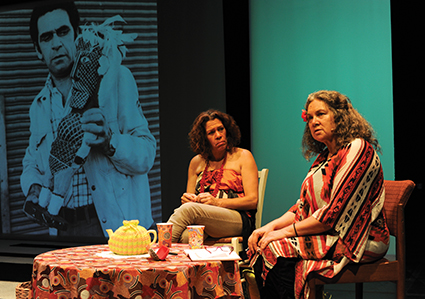
Nadeena Dixon, Rhonda Dixon-Grovenor, The Fox & The Freedom Fighters, Performance Space
photo Heidrun Löhr
Nadeena Dixon, Rhonda Dixon-Grovenor, The Fox & The Freedom Fighters, Performance Space
I’D LIKE ALL PERFORMANCES TO BEGIN WITH SOMETHING LIKE THE INDIGENOUS SMOKING CEREMONY. THE EFFECT IS CALMING AND PREPARES US TO ENTER ANOTHER REALM. SUCH WAS THE FEELING AS WE WERE WELCOMED INTO THE SPACE FOR THE FOX AND THE FREEDOM FIGHTERS BY UNCLE MAX (MAX DULUMUNMUN HARRISON), A YUIN MAN.
The ‘fox’ refers to Aboriginal activist and social pioneer Charles (Chicka) Dixon (1928-2010). Three years in development, this work has been conceived and co-created by Chicka’s daughter Rhonda Dixon-Grovenor and granddaughter Nadeena Dixon with a team of collaborators including co-writer and dramaturg Alan Valentine and director Liza-Mare Syron.
Three components of the design (Nadeena Dixon, Clare Britton) combine to reflect the work’s structure: a large central screen for film sequences (and doubling for an ASIO document); a small platform with a microphone for sung segments; and a spare living room set-up where mother and daughter casually exchange memories of the man who radically affected their lives. The spare design is enveloping and incorporates a set of striking woven sculptures by Nadeena Dixon, which grace the walls and cast enigmatic shadows. As they converse, Rhonda separates raffia threads while Nadeena weaves the circular forms of a new piece.
The performative style aims to be laidback but at times the demands of conventional theatrical dialogue appear to hinder the rapport we sense between mother and daughter. The powerful film segments (Amanda King, Fabio Cavadini) are more effective with the women appearing to be unscripted and more spontaneous. Generous archival footage provides insight into the important work of Chicka Dixon-—his involvement in historical events such as the 1967 Referendum, the establishment of the Aboriginal Tent Embassy, the Aboriginal Arts Board and a visit to China in 1972. All this is woven together with the quietly intense statements on the impact of this activism on family life delivered individually to camera by Rhonda and Nadeena.
Most engaging in this work is the opportunity it offers us to meet two very interesting women and to share with them the unravelling of an intimate and difficult truth. “Don’t you for a minute think that there isn’t a cost to every single moment of this fight for freedom,” says Rhonda. And we don’t. As they reveal with passion and humour the highs and lows of life with an admired patriarch—his many absences, the alcoholism, which he eventually overcame but which clearly affected their early lives and manifest in stress and abuse in subsequent relationships—we experience the recovery of intimacy with their father and grandfather along with their own unfolding activism, all woven into the complex issues of everyday life.
The Fox & The Freedom Fighters, concept, creation, performers Rhonda Dixon Grovenor, Nadeena Dixon; Performance Space, Carriageworks, Sydney, 13-22 Nov
RealTime issue #124 Dec-Jan 2014 pg. 43
© Virginia Baxter; for permission to reproduce apply to realtime@realtimearts.net
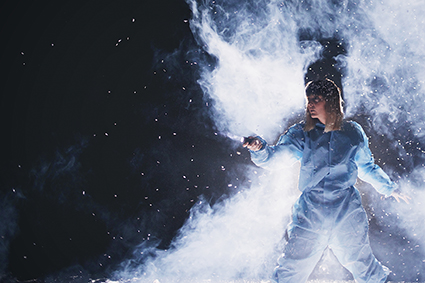
Adriane Daff in Falling Through Clouds
photo Jarrad Seng
Adriane Daff in Falling Through Clouds
SPECTACULAR PUPPETRY, INNOVATIVE VIDEO AND HAUNTING MUSIC IN THE LAST GREAT HUNT’S FALLING THROUGH CLOUDS CONVEY A TALE OF IMPOSSIBLE DREAMS. ONE HUNDRED YEARS AFTER BIRDS HAVE DISAPPEARED, DR MARY MILLER HAS FOUND A WAY TO BRING THEM BACK AND HAS BEEN GIVEN A YEAR TO HAVE THEM FLYING. FROM HER OPENING DREAM OF FLIGHT, THE DEVOTED DOCTOR’S DELIGHT GRADUALLY TURNS TO STRESS AND OBSESSION.
In a dream-infused narrative, a research facility is established, eggs are fertilised, incubated and hatched. Mary monitors the growth and development of Henry and Jenny as they grow into their long necks, bills and legs. Teaching them to fly is frustrating, but the joys of interacting with Henry’s mischief and Jenny’s affection seem worth the worry, until deadline day. In a nightmarish sequence, Jenny is taken to the top of a cliff and sent over the edge—she panics, twitches her wings and plummets to her death. Mary’s instructions to end the failed project include specific directions to destroy all biological specimens herself, leading to a memorable chase scene with Henry and a beautiful sequence leading to the titular notion of Falling Through Clouds.
Adriane Daff (Dr Mary Miller) is a joy to watch. Her face conveys emotion intensely, amplified by combined techniques of theatre and hand-held camera working to produce a sense of real-time documentary. She rises to the acting challenges presented by film and stage, simultaneously, particularly in her dream sequences and also at the magical moment featuring a bird’s eye view of her from the interior of an eggshell breaking open.
As with previous works by this team, truly wonderful puppetry emerges, even when using balls of shredded paper. From the first tiny hatchling wing shivers to the clack clack of the feet of growing birds and their inquisitive and mischievous head and neck movements, close behavioural observation and dedicated puppetry technique bring birds to life with as much excitement as if they really were the first avian life in a century.
The set constantly changes, a particular highlight being the creation of the research facility using sheets of paper. It features a micro set of the island on the dark expanse of the stage, with hot air balloons flying above, changing our perspective, and fans that create the winds also clearing the ‘set’ once done. This sequence epitomises the careful simplicity sustained through the performance.
Thoughtful technical work sees simple projection used with low-tech ‘screens’ to create dreams of flying birds and a beautiful night sky. Use of simultaneous projection with the hand-held camera is particularly effective in Jenny’s failed flight attempt and wonderful when tracking Henry’s curious roaming around the closing facility. Classic puppetry provides elegant presentations of flight and weightlessness, contrasting with the chillingly creepy use of a moulded mask of Daff’s sleeping face. Henry’s escape is a beautiful collection of visual techniques, smoothly transitioning from live video streaming to a theatrical depiction of overhead lights, a simple exterior shot and then a sweet animation clearly telling his tale without any text distracting from the scene’s magical whimsy.
Integral to the performance, the sparse use of text is made possible by Ash Gibson Greig’s sound design and song selection, featuring poignantly weighted lyrical timing.
A visually beautiful work, accompanied by beguiling sound design and a mesmerisingly sweet narrative, Falling Through Clouds celebrates the considerable talents and achievements of its creative partnership.
Falling Through Clouds features in the 2015 Sydney Festival’s About an Hour program; Seymour Centre 16-18 Jan
PICA & The Last Great Hunt, Falling Through Clouds, initiating artist, co-creator, performer Tim Watts, co-creator, performer Adriane Daff, co-creator, performer Arielle Gray, co-creator, performer Chris Isaacs, composition, sound design Ash Gibson Greig, PICA, Perth Cultural Centre 22 Sept–11 Oct
RealTime issue #124 Dec-Jan 2014 pg. 45
© Nerida Dickinson; for permission to reproduce apply to realtime@realtimearts.net
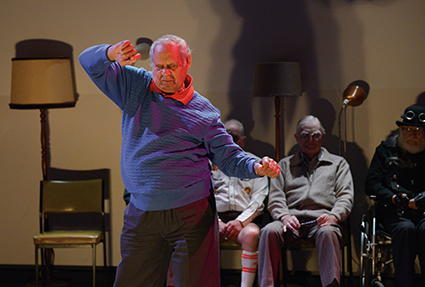
Uncle Murray Harrison
photo Liz Crothers
Uncle Murray Harrison
WITH THE SLASHING OF SENIOR CITIZEN ENTITLEMENTS AS PART OF THE BUDGET RELEASED EARLIER THIS YEAR AND SEVERE CHANGES TO ACCESSING UNEMPLOYMENT BENEFITS FOR YOUNG PEOPLE, REBEL ELDERS, A COMMUNITY-BASED ART PROJECT FOCUSING ON THE PAIRING OF ELDERLY PERFORMERS WITH YOUNG MUSICIANS COULD HAVE BEEN A DARK AND SOMBRE AFFAIR.
Instead, musician and community facilitator Rose Turtle Ertler conceived a work where the audience experienced a mischievous interruption to the looming social welfare cuts. Inspired by the Australian Human Rights Commission’s “Facts or Fiction: Stereotypes of Older Australians” (2013), Ertler gives us a refreshing and heart-warming celebration of diverse intergenerational storytelling through interview recordings, music and performance.
It’s fitting too, that this project takes place in Ballarat, known for its historical uprisings. In the theatre space of the Museum of Australian Democracy at Eureka, Rebel Elders takes a more personal road when addressing civil disobedience. Seated on a line of hard backed chairs, the elderly performers face the audience and listen intently to the introductory sound fragments of their newly remembered stories, then one by one move forward to elaborate physically. It’s a silent interaction—with each other, alone and occasionally engaging with props, adding dimension to the recordings we hear.
Ertler’s process is an inclusive one; eight Ballarat elders were interviewed about rebellion in their lives. These stories became the departure points for young local musicians to produce radically different works to accompany them. We hear hip hop, ballad and guitar rock soundtracks alongside micro stories of rodeo and radio, a soldier going AWOL, secrets being divulged, Violet Crumble thievery, youthful runaways and a boxer not wanting to be boxed. Always with gems of elderly wisdom attached: “There’s always an upstager wherever you go, there’s always a knocker.” The emotional significance of these connections between old and new holds weight. Rebel Elders lends us an empathetic ear, stitching up the tear in our society and reaffirming the similarities between generations.
The random pieces of the sound design mimic the way we retrieve events in our lives and how these change subtly with time and location. They’re also episodic, encoding both mind and body: the bold act of a 14-year-old girl to wear fashion not fit for the 50s and the dramatic parental response — to “cut the skirt up, break the heels of my shoes”—is the catalyst for a runaway. The surprising twist to this guitar riffing tale was that in the simple act of not giving her name to police the narrator was placed in a convent for bad girls for over five years. These stories speak to us about the double-sided nature of defiance, dislodging the usual stereotypes of the elderly while also highlighting the need to find a place in the world.
The music was as varied as the stories. An elderly man decked out in an old military jacket and flying goggles with which to navigate the stage, spins circles in his wheelchair and plays air guitar with unflinching bravado. His tale slows to describe siphoning petrol while the beatbox soundtrack uses mouth and guttural utterance to amplify our sense of the experience.
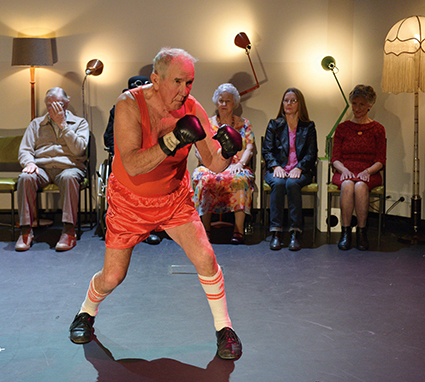
CJ Ellis
photo Liz Crothers
CJ Ellis
With direction and choreography by Michelle Heaven, there is an impressive renovation of memory. Contrasting and complementing the recorded dialogue between the ages, Heaven picks up these rebel yarns and knits us a curious fabric of embodiment: a meshwork of repetitive gestures, thumping hearts and chance happenings. She relocates our perception with a simple use of movement evocative of the honesty in the words we hear. The choreography generates a place where the storytellers re-enact their very own characters, as if co-starring with their younger selves.
There’s a constant shift between literal representation and movement cycles that are more ephemeral in nature. Lighting by Bluebottle delivered simplicity, with occasional moments of visual trickery—larger than life shadows thrown on the backstage wall, the flickering of mismatched lamps highlighting the range of characters emerging. The performers do well to create cohesion in their storytelling, the errors in their movement real and endearing, serving to express how the elderly are misrepresented in mainstream media. Then we drift into a ballroom sequence evoking love and it’s heart-wrenchingly beautiful.
Rebel Elders reveals the importance of voice, where mining the mind is a personal act of rebellion within itself, a quiet protest. When it’s filtered through a combined 635 years of life there is resonance in the air, signifying that small choices can create huge change. The performance itself was the most interesting act of rebellion and the incredible people within it defied all labelling. They were real.
Rebel Elders, concept, sound design Rose Turtle Ertler, director, choreographer Michelle Heaven, lighting Bluebottle, Elders: CJ Ellis, Helen Gower, Uncle Murray Harrison, Victor Linane, Sue Morse, Kath Morton, Tom Rush, Trevor Williams; Young Musicians: Beatboxbo, Joint Beatz, Jake Dunmill, Rhiannon Howard, Reece Kelly, Jessica Moller, Kate Moran, Tabitha Rickard, Tobi Sam-Morris, Jennifer Rose Smith; City of Ballarat and Victorian Seniors Festival; M.A.D.E. (Museum of Australian Democracy at Eureka), Ballarat, 31 Oct, 1 Nov
RealTime issue #124 Dec-Jan 2014 pg. 44
© Klare Larson; for permission to reproduce apply to realtime@realtimearts.net
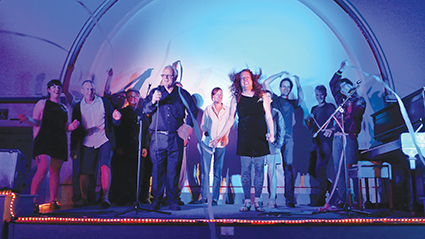
cast of The Dad Show
photo Megan Spencer
cast of The Dad Show
BRON BATTEN GETS AROUND. TESTING OUT NEW PERFORMANCE (MELBOURNE’S LAST TUESDAY SOCIETY), EMBODYING THE POWER OF HYPNOSIS (USE YOUR ILLUSION, RT123, P37), AND HERE SHE IS IN REGIONAL VICTORIA, WELCOMING US INTO THE BEAUTIFUL BLUESTONE OF ST MARY’S IN KYNETON—HALF WAY BETWEEN THE CULTURAL EPICENTRES OF MELBOURNE AND CASTLEMAINE—SEATING US WITH LOCAL FAMILIES KEEN TO SEE THEIR FATHERS’ FIGHT OR FLIGHT RESPONSES LIVE ON STAGE. AS SPEAKERS BLARE ROLLING STONES (TO INFURIATE PUNTERS AFTER THE BAND’S CANCELLATION AT NEARBY HANGING ROCK), WE’RE READY NOW FOR THE DAD SHOW.
Bron (this show calls for first names) introduces herself and her dad James via slide show and poorly executed jokes (hers and his). For a previous show Sweet Child of Mine (2011) she tells us having spent a number of years on stage dressed as a humpback whale, she went around with a video camera to her parents’ home to ask them, “What do you think I do for a living?” Soon realising they had no idea, she decided to help by bringing them on stage. Here, she continues the theme, asking various father-and-son/daughter combos to perform their roles, variety style.
After a ‘real live dad’ hands out hot, weak Milo (the taste of camping), Sarah and Robert read their relationship through email, exploring what memory looks like (plasticine), how hard it is to say you don’t believe in God (when your father does) and how excruciating it is sitting in the front row watching The Vagina Monologues (when your daughter’s starring in it). The dynamic between seasoned performer and novice is negotiated carefully (and this continues through all the acts): as Sarah projects, Robert reads shyly from his notes. It is his reticence that draws my attention. So too with Bob Snelling, who takes his son Wes on a sketchy fishing expedition—ritual for the modern male—a love/hate affair. As fish-out-of-water Wes turns the radio up loud and refuses to touch worms; Bob gently coaxes him into using the rod and pats his shoulder uncertainly when tears come; salt of the earth meets high camp.
Hal and Michael (guitarists and singer-songwriters, 20 years apart) play each other’s songs for the first time together. One hipster-shaggy, the other baby-boomer-cool, they share a stance and straight-legged jeans, and as their shadows merge into one behind them, their acoustics throw off awkwardness and find comfort in convergence. The son’s face becomes joy. Henry Vyhnal’s face becomes grief as he plays his father’s violin and revisits Antonin Dvorak’s “Humoresque,” a piece of music he played at his father’s funeral. While father and son may share the language of music and moody phrasing, this act explores what’s left when one of you is gone. Hannah and Bernie share a storytelling language too but their words don’t quite relate. As Hannah reads from her journal about slowly starving to death, her father sings “Your looks are laughable, un-photographable” and dances in the moonlight; a tug-of-war between who most wants to be centre-stage.
While a loose framework of variety-hour connects the acts, The Dad Show doesn’t quite hang together. Bron’s patter before and after each performance doesn’t add to the overall cohesion, but she does make you feel like you’re hanging out with that try-hard relative who makes you cringe and want to escape the kiddies’ table. A New-Faces-Frank-Sinatra duet with her dad, where he sings “Something Stupid” and she brings in contemporary dance, is a good place to end. But what’s missing, given the show’s family focus and the building we’re sitting in, is a sense of Kyneton. I wish Bron’s dad had done a snapshot history, a male-jokey narrative of the place and its people and how the dads of the show fit into it.
The most powerful dad moment of the night comes via video. Literally lost in translation, Christian is interviewing his father Barnabus and asks him to tell a joke. While father and son arrived from Hungary in 1980, Barnabus is now in a residential care facility with Parkinson’s disease. On camera and up in bed drinking with a straw that occasionally sneaks up his nose (not an intended joke but funny nonetheless), Barnabus tries with difficulty to pull words and concepts together — running priest, minister, nurse—sometimes in English, mostly Hungarian, while the humour (tears stream down my face) comes from our imagining what the joke might be and exquisite if unintended timing. The punchline is irrelevant. When Christian asks his dad, Do you love me?” he answers, “I love you and all the other kids too.” Off the side of the stage, Christian (tears stream down his face too) explains that before he made the video, he hadn’t seen his father smiling or laughing for seven years. It took a dad joke to do it.
The Dad Show was developed and presented as part of Punctum’s Seedpod Amplified extended residency program, encouraging performers to make new work in regional settings.
The Dad Show, Punctum Inc and The Last Tuesday Society, performer, curator Bron Batten, featuring Christian and Barnabus Bagin, James Batten, Hannah and Bernie Monagle, Hal and Michael Langley, Peter and Sarah Lockwood, Wes and Bob Snelling, Antonin and Henry Vynhal, St Mary’s Hall, Kyneton, Victoria, 7-8 November.
RealTime issue #124 Dec-Jan 2014 pg. 46
© Kirsten Krauth; for permission to reproduce apply to realtime@realtimearts.net
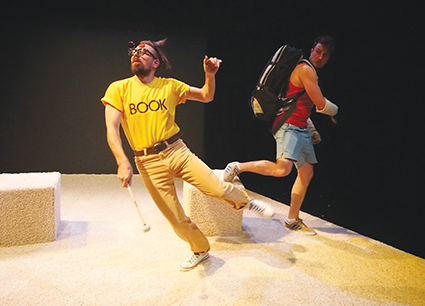
Lucas Stibbard and Tim Dashwood
photo Ben Eyles
Lucas Stibbard and Tim Dashwood
JUST AS TRAVEL CAN BE ENLIGHTENING AND TRANSFORMATIVE, SO TOO CAN THEATRE. BOTH HAVE POTENTIAL TO CHANGE THE WAY WE SEE THE WORLD, AND OURSELVES IN IT. PACKED, A CO-PRODUCTION STAGED IN ALBURY-WODONGA BETWEEN HOTHOUSE THEATRE, BRISBANE’S METRO ARTS AND THEATRE GROUP THE ESCAPISTS, PUTS TRAVEL AND TRAVELLERS UNDER THE MICROSCOPE IN A DYNAMIC PIECE OF THEATRE.
It was clear from the outset that Packed was going to do things differently. The B52’s classic travel anthem “Roam” played as the audience took their seats, while Timothy Dashwood—beer in hand—left the stage and wandered around the theatre striking up easy conversations with patrons about their travels.
Packed tells the story of two characters, simply referred to as He and She, who represent the extremes of travel personalities. He (Dashwood) in his beer logo singlet, is the likable, loutish Aussie bloke who has swapped his 9-5 responsibilities for a life of travel, ticking off his travel experiences with an equal love of drinking and selfies. She (Neridah Waters) in her sensible walking boots, cargo pants and scarf, is the hard-working anthropologist, writing about and observing the world at one remove. They collide, literally and hilariously, in an unnamed foreign land, where despite the vast gulf of their differences, they fall in love.
Lucas Stibbard (Book) cleverly plays both He’s travel guidebook and She’s anthropology manuscript. By personifying these two books, as vastly different as their owners, Stibbard’s character adds a whole other riotous dimension to the plot and themes.
He has his beer; She has her notebook. He unashamedly wants to suck the marrow out of his experiences, “I’m a tourist, we touch everything.” She is above the consumerist tourist mentality. Eventually though, She realises she is merely “hiding in a study of the world that doesn’t have me in it.”
The script (co-written by Matthew Ryan and Stibbard) is fast and tight; a hilarious swirl of anthropological theory, observation and travel stories. Even random German words are explained in formal lecture style. The cast give standout performances throughout the, at times, manic scenes—lots of climbing, running and leaping. A sense of movement is also conveyed with small, careful effects like She’s wiggling her ponytail on the back of a motorbike.
The deceptively simple set, consisting of a section of white carpet and three carpeted cubes, was used to maximum effect, creating everything from towers to planes and motorbikes. The large screen on stage added a more complex layer to the story constantly transforming the stage to keep pace with the busy script. Animations (by Pete Foley) were a clever addition to the text-heavy story, transporting the audience to a whimsical faraway land of flying ‘sky yaks.’
There were funny asides about Pluto no longer being a planet and cats having supernatural powers. The audience hit giant balloons around the theatre and the typed pages of the anthropology manuscript floated down on the stage. Like the very best travel adventures, Packed was full of laughter, wisdom and quirky, unexpected delights.
Hothouse Productions, Metro Arts & The Escapists: Packed, co-creators: Keith Clark, Jonathon Oxlade, Matthew Ryan, Lucas Stibbard, writers Matthew Ryan, Lucas Stibbard, design Jonathon Oxlade, lighting Keith Clark, composer Chris Perren, AV design Pete Foley, The Butter Factory Theatre, Wodonga, Oct 23-Nov 1
RealTime issue #124 Dec-Jan 2014 pg. 47
© Kate Rotherham; for permission to reproduce apply to realtime@realtimearts.net
TWO RECENT PERTH PRODUCTIONS HIGHLIGHT CONTRASTING WAYS IN WHICH DANCE CAN CROSS AND PROBLEMATISE THE BORDERS OF COMPREHENSION. AIMEE SMITH AND BEN TAAFE’S FORAY INTO BORDERLINE OUTLINES THE STARK CONTOURS OF COMMUNICATION THROUGH MOVEMENT AND SOUND, WHILE DANIELLE MICICH (DIRECTOR) AND SUZI MILLER’S (WRITER/CO-DEVISOR) CONCEPTION OF OVEREXPOSED, WITH DRAMATURGY BY KATE CHAMPION, SHATTERS THE CERTAINTY OF UNDERSTANDING. BOTH BRING INTO QUESTION THE LIMITS OF PERFORMANCE: NEITHER GIVES DEFINITIVE ANSWERS.
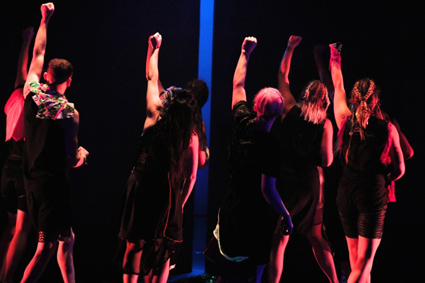
Borderline, Aimee Smith
photo Emma Fishwich
Borderline, Aimee Smith
Borderline
Aimee Smith is a wizard at constructing penetrating images whose barbed irony agitates and/or needles into matters of environmental concern. Borderline continues to explore this crafting although, on this occasion, the movement pictures and their reverberations are locked in a pervasive sense of doom. Even the dancers’ sometimes astounding wrestling with the demons of this age of herd obeisance, excessive waste and purported individualism bows to a bleak evaluation of human destiny. If the work is an anguished protest against the insanity of our behaviour in and for the planet, as I am sure it is, the cry is harsh and unremitting, seemingly devoid of any hope of rebirth. The gold glitter and hysteria-whipped bodies of the final image, indeed, act like incisive punctuation marking the withering of human imagination.
In three sections, the work begins with a weighty social organism lurching “Into the Fold.” Random impulses for freedom and/or escape conveyed through individual dancer’s unleashed limbs and torsos are crushed as the herd mentality re-ingests the errant body back within its turgid vortex. Choreographically impressive as it is, the tenacious grip of this community is born of containment not of support.
Hints of wasted social relationships become literal in “No Man’s Land” as Laura Boynes tentatively advances across an empty space only to be submitted to a barrage of fabricated rubbish and dumped bodies hurtling around her. The debris amasses, leaving her poised like the Statue of Liberty or the feminine symbol of justice garlanded in a glut of grime and senselessness. It’s a haunting image of silenced freedom and equity. The anti-visionary triptych concludes with “Trans Form,” flipping the herd anxiety of the opening into a cult of individuals blindly chasing the glowing capitalist shrine of fulfilment. Even given the tongue-in-cheek voice-over of Ben Taafe’s soundtrack, I couldn’t dismiss the association of a trail of ever-smiling and vaporous ‘selfies’ supplanting their human originators. Pointedly, perhaps, the dancers only showed their backs as they advanced and recircled towards the edge of the illuminated madness. Was Smith and Taafe’s message to turn around and face the terms of our own self-destruction?
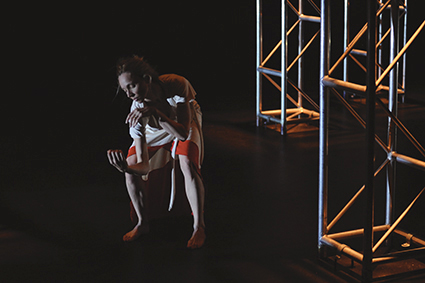
Overexposed, Danielle Micich
photo Ashley de Prazer
Overexposed, Danielle Micich
Overexposed
Surveillance in theatre enters into a double-bind or conundrum as the audiences of Overexposed watch, record and judge what transpires before them, for the most part, from the anonymity of darkness. However, if the topic of the performance is framed and bound to policing human behaviour, its secrecies, disorientations and lies are curiously turned back onto its audiences, who might find their normal privileged role eroded. Danielle Micich’s Overexposed does not take this approach directly but the nett effect of its structure unmoors spectators from familiar logic and lands them in an alien territory of evaporated rights.
The promotional material indicates that the protagonist, Marisa, is inexplicably detained on her arrival into the home airport after a trip. What happens after this Kafkaesque premise occurs in two rooms. Obviously, surveillance is involved, which is playfully reinforced by a security check on spectators’ arrival for the performance. For inexplicable reasons, some members are stamped red in this process, while others are given official clearance in spite of the tell-tale bleep signals at the metal detector archway. It turns out that the stamping is a lottery determining to which viewing room the spectator will be allocated, neither of which tells the complete story, if in fact a complete story is ever to be told.
With this strategy, Overexposed becomes underexposed. Whatever the source of the surveillance, you become aware that exposure to the work is but a semblance of truth, couched in fear and a weird logic which reduces the complexity of human behaviour to ciphers of blame. The filtered communication is further complicated by isolating the movement and text, commonly associated with a dance theatre format, into two halves, one to each viewing space. Text delivered by performer Humphrey Bower, so I later gathered, dominated one space, while movement permeated the near silence of my room, where performer Micich, chased by a roving spotlight, emerges from the audience and is led into the stage’s imprisoning landscape of metallic towers. Her body, initially compliant, is soon subjected to invasive and unexplained interrogation procedures. The physical disintegration is painful and, till this point, eloquent in its delivery.
Time then stretches like a taut membrane over meaning, where both Micich’s and my interpretation become wired into some sort of psychic realm in which her body appears to spin repressed dreams of agency. There were possible narrative hooks via projected text but from my vantage point—and corresponding with the production’s logic—sight was obstructed by the towers. Left to my own devices in the alien interpretative space, I had to trust in a corporeal storytelling, in the performer’s internal fantasies given some semblance of form. Pleasures of puzzling through Micich’s sudden switch to expansive almost abandoned movement mixed with tensions of mis-readings. Had her disorientation pushed her over the edge? Is insanity the ultimate objective that surveillance inflicts on both of us?
I was still floundering when Micich exited and Bower, full-voiced with accusations, entered. The act provoked a powerful bewilderment, exacerbated when the back wall opened to reveal the other room where Micich, but more so the other audience, watch the watching. Bower’s words, which now seem to admit guilt for accusations of infanticide fired at the accused, have less impact than being exposed to the watching of the watchers be they audiences, performers or the state. Inconclusive as this response may be, Overexposed conveyed a disquieting message, if always veiled and inconclusive, about surveillance’s propensity to unhinge identity.
Borderline, devisors Aimee Smith, Ben Taafe in collaboration with dancers Laura Boynes, Bernadette Lewis, Storme Helmore, Jenni Large, Tyrone Robinson, Tony Curie, Isabell Stone, Ella-Rose Trew, music Mental Powers, Phil Stroud, Beppu, costumes Holly Boyton, lighting Trent Suidgeest, State Theatre Centre, 1-4 Oct; Overexposed, director, performer, co-devisor Danielle Micich, performer Humphrey Bower, writer, co-devisor Suzi Miller, dramaturgy Kate Champion, sound Kinsley Reeve, lighting Chris Donnelly, costumes Colleen Sutherland, State Theatre Centre, Perth 22 Oct-Nov 1
RealTime issue #124 Dec-Jan 2014 pg. 34
© Maggi Phillips; for permission to reproduce apply to realtime@realtimearts.net
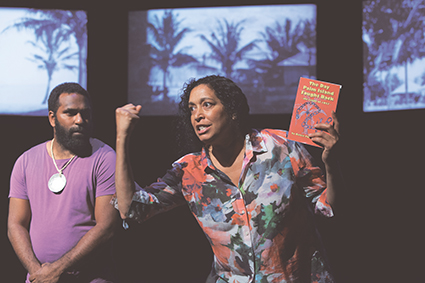
Harry Reuben, Rachael Maza, Beautiful One Day (2012)
photo Ponch Hawkes
Harry Reuben, Rachael Maza, Beautiful One Day (2012)
RACHAEL MAZA IS THE ARTISTIC DIRECTOR OF ILBIJERRI, VICTORIA’S ONLY PROFESSIONAL INDIGENOUS THEATRE COMPANY AND, TOGETHER WITH WESTERN AUSTRALIA’S YIRRA YAAKIN, ONE OF ONLY TWO SUCH COMPANIES IN AUSTRALIA. SHE HAS JUST RETURNED FROM DUBLIN WHERE THE COMPANY’S PRODUCTION OF JACK CHARLES V THE CROWN PLAYED AT THE SAMUEL BECKETT THEATRE AS PART OF THE DUBLIN THEATRE FESTIVAL. ASKED ABOUT THE EXPERIENCE SHE IS ECSTATIC, “OH MY GOD, JUST BRILLIANT. THE WORK ITSELF …IT STANDS UP AT AN INTERNATIONAL FESTIVAL.”
While not a woman’s story, Jack Charles’ was one that Rachael believed needed to be told and this remains her major consideration when selecting a work. “The thing that really fires me up is the politics…a carry-on from the generation before me and my forefathers.”
Rachael’s father Bob Maza founded, with Jack Charles, Australia’s first Aboriginal theatre company, Nindethana, in Melbourne in 1972 and produced a version of The Cherry Pickers by Kevin Gilbert, considered to be the first Aboriginal play. Later the same year Maza moved to Sydney where he was actively involved with Redfern’s National Black Theatre. Rachael remembers these as “high energy times” with “the men very loud and public,” so much so that they caught the eye of the media to the virtual exclusion of many incredible women.
Given this background it’s perhaps not surprising that Rachael became an actor, although there was a time when she was determined to find a different career. Her first love was music, playing bass guitar in bands. However, while working at a community school in Woolloomooloo she found herself thinking, “Maybe I’d like to do acting.” A work colleague mentioned a course in Lismore that offered acting and dancing classes and she decided to give it a try. Lyndon Terracini, now Artistic Director of Opera Australia, was her acting teacher and she credits him with influencing her to do a ‘proper’ acting course. This College of Advanced Education course had provided her with the stepping stone she needed to enable her to complete a three year acting degree at the Western Australian Academy of Performing Arts (WAAPA).
As Rachael explains, coming to acting via a circuitous route meant self doubt has always been an issue for her: “I’ve taken nudges, required people to bolster my confidence because it wasn’t there innately.” She has never seen herself as ambitious or driven and has tended to take a year-at-a-time outlook on her career: “It’s like I’ll see how it goes; if it’s going all right I’ll keep going…otherwise I’ll do something different.” In her current role she is aware that she often tends to step back, handing the credit to all the other creatives involved. “You know you’re good at what you do…but I grapple with this inbuilt uncertainty that kicks in at all points.” Asked how she deals with this her answer is simple, “I don’t know. I just power along.”
Rachael Maza’s way of working is intuitive and collaborative. “I listen from my gut and through that am able to navigate my way creatively through the space. Often I find myself sitting back in the room and letting the creatives put their input in and then tend to come in and feel like I’m steering it…that’s how I cope, that’s how I work best.” She also works best when she manages to strike a balance between work and family life—an ongoing struggle.
The challenges inherent in her current role are many and varied. One of the biggest is the shortage of Indigenous arts workers at every level of the creative process: actors, writers, directors, designers, production managers, producers, you name it. There is a mass of talent within the community but for some reason not many have gone on to pursue professional careers in the arts. llbijerri does its best to nurture and develop talent but no one theatre company can do everything. Indigenous artists need to have other opportunities to develop their skills and gain experience over the longer term, to have viable career paths.
Rachael does not believe there is a male/female imbalance within the Indigenous arts community, but she does find that the women tend to be less inclined to “talk themselves up.” In contrast men come across as far more confident in who they are, what they have to offer and where they see themselves in the future. “I am very aware of concerns from the community that we need more women’s stories.” This is probably why Ilbijerri has three women’s stories (by Katie Beckett, Tammy Anderson and Wilma Reading and Jane Bodie) currently in development.
The reality of limited funding is always challenging; development/rehearsal time is limited and “we have to be very vigilant to ensure Indigenous protocols are followed.” Without exception, when developing a new project at Ilbijerri, the protocols involved can mean a very lengthy process of talking to and working with everyone impacted by and involved in that story. The budget is never enough to research, develop and rehearse a work as much as one would like which puts added pressure on all concerned. “Jack Charles v The Crown was one of those blessed experiences, despite the limited budget, because we had the right team in the room and because that story was determined to be told—we got there! Four years later it’s still touring. Beautiful One Day [with version 1.0] was another exception to the rule because it was backed by Sydney’s Belvoir, giving us the luxury of five or six weeks’ development followed by five weeks’ rehearsal.“
Despite all the challenges Rachael Maza is optimistic about current opportunities for Indigenous arts and artists. “It’s a fantastic time to be in the arts; it’s a struggle, but there is massive room for growth…a real opening up for Indigenous story-telling. I think a crack’s happening in the veneer. There’s been a long history of not wanting to go there because it’s so ugly, painful, raw. I think something’s cracked, there’s a want to hear these stories…I think that some time in the future we’ll be able to celebrate because this is what makes us unique in this country, something really special, something we can all learn from.”
Rachael Maza’s fIlm and TV roles include the AFI award winner Radiance (1998), Cosi (1996), Lillian’s Story (1996) and My Year Without Sex (2009). She’s also worked as a TV presenter, narrator and Indigenous Liaison Advisor on films such as Rabbit Proof Fence (2002). In 2012, she worked as dramaturg on the production of Coranderrk: We Will Show the Country. As performer she’s appeared in the Belvoir production of The Sapphires (2005) and Bell Shakespeare’s The Tempest. She won a Sydney Theatre Critics Award for her role in Radiance (1994) and a Green Room Award for Holy Day (2002). Her directing credits include Stolen (1992) for Ilbijerri Theatre Company, Sisters of Gelam (2009), Jack Charles Vs The Crown (2010), Foley (2011) and Beautiful One Day (2012).
RealTime issue #124 Dec-Jan 2014 pg. 48
© Jan Chandler; for permission to reproduce apply to realtime@realtimearts.net
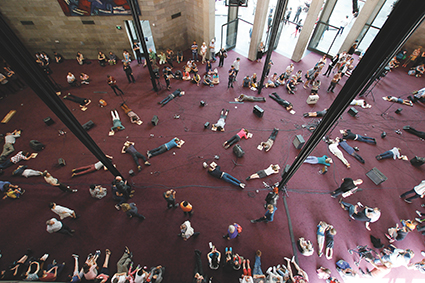
Hit Parade
photo Aksana Hugo Anastas
Hit Parade
OPENING THE LIQUID ARCHITECTURE 2014 FESTIVAL BOOKLET FOR THE FIRST TIME WAS A DISCONCERTING EXPERIENCE, AS LOOSE PAGES FELL TO THE UNSUSPECTING READER’S FEET. THE PAGES FEATURED ARTISTIC STATEMENTS, QUOTES FROM FRENCH THEORY, ROCK LYRICS, BUT NO PAGE NUMBERS. WHERE WERE THE FESTIVAL DATES? WHO WAS PLAYING WHERE? WHAT ORDER DID THE PAGES GO IN? THE FESTIVAL WEBSITE WAS SIMILARLY DISORIENTATING.
New festival Artistic Directors Joel Stern and Danni Zuvela had warned us that audiences this year would be confused, angry and divided. The festival booklet’s fluid hierarchy and lack of easy answers augured this challenge. With the theme “The Ear Is A Brain,” Liquid Architecture 2014 encouraged audiences to listen and think critically. They proved sturdy enough to accept the challenge with gusto, selling out the majority of events on the Melbourne leg of the festival and on more than one occasion becoming participants in performances (both voluntarily and unwittingly).
It was clear from the moment the audience entered the Meat Market for the opening night concert that things were not going to be made easy. As the crowd of 500-plus filed in, they gradually became aware of an irregular knocking coming from the PA. Melbourne artist, Helen Grogan, was crawling around the perimeter of the space, tracing its edges with a live microphone. Grogan’s Concrete Room, performed previously in much smaller gallery spaces, was executed with a single-minded intensity that emphasised the work’s ritualistic nature. Grogan’s microphone negotiated carpet, skirting boards, bluestone and at times the feet of audience members. The long microphone cord tailing behind her forced the audience to physically negotiate the performance by stepping over it.
Most of the capacity opening night crowd had come for Robin Fox’s headlining RGB Laser performance. This was expertly staged as a large partitioned wall opened to reveal a spacious extra wing of the venue, with Fox’s smoke, laser beams and jagged electronic tones spilling out. The crowd strode into the smoke like entranced cultists for a truly immersive sound and light experience, with Fox presiding over it all from a raised platform like a new Wizard of Oz.
Yet the most interesting performance of the night was Christof Migone’s Mixer. The first of several works by the Canadian artist on the festival program, Mixer was performed by a group of volunteers briefed shortly before the concert. The work took place on the main stage in between the more ‘official’ performances with the participants enacting a series of simple, repetitive actions, mostly involving microphones. These included repeating your age for an equal number of minutes, and giving other participants backrubs with a live microphone. These unheralded episodes were largely ignored by the large crowd, whose own sound world of reverberating pub chatter created a distinctly odd juxtaposition against Mixer. The audience’s dogged ignorance became part of the performance.
The following evening’s Stutterances program at the National Gallery of Victoria attracted a more attentive crowd. Most of it took place in a lecture theatre setting with speech/text-based performances from touring and local artists. Some artists ‘detourned’ various visual communications technologies: from overhead transparencies (Kusum Normoyle) to crappy PowerPoint presentations (New Waver). Johannes Kreidler’s taxonomy of heavy metal with short accompanying audio examples (black metal, power metal, poser metal, true metal…) was a highlight, as was Alessandro Bosetti’s circular spoken text and its interaction with a pre-recorded female voice that could have been that of a lover or a phantom ‘voice in my head.’ Local conceptual/parody project New Waver’s overdue return to live performance was a winner, coaxing the ponderous audience to sing and clap along to that ode to real estate and gentrification, “We Built This City on Indie Pop.”
Both the opening night and Stutterances event featured performances that, if not exactly spectacular, were provocative in the concepts they explored and the tropes challenged. Yet some acts struggled to rise above middling in their conceptual depth. The Friday night program in the Trench under Federation Square had its moments, but for the most part performances lacked a dynamic arc or failed to convey the complexity that artists such as Migone and Kriedler had done so elegantly. The Donkey’s Tail performance of noise ensemble with soprano was beautifully staged from a platform overlooking the audience situated below in the subterranean industrial cavity of the Trench, but other acts wavered between extreme obscurity and the plainly undergraduate.
The success of various lectures and workshops prior to and throughout the festival also varied, with James Parker’s “The Jurisprudence of Sonic Warfare” standing out as the most accomplished. The festival’s gamut was ambitious; the fact that not every act was a resounding success shouldn’t be construed as marks against it. Experimental arts practice needs room for failure, and opportunities for formal discussion of sound practice are all too rare in Australia and should be encouraged.
Migone’s mass participant piece, Hit Parade, was an undoubted success. The closing event of the Melbourne program, it pulled many of the festival’s ideas together through the primal act of banging a microphone on the ground. Migone gathered 50 volunteers of all ages to the National Gallery of Victoria’s Great Hall and armed each with a microphone and guitar amplifier. Fifty bodies lay face down bashing their microphone into the floor at their own chosen pace and intensity, one thousand times each. Sonically, Hit Parade differed depending on whether you walked around the prone performers in the hall itself (like being in a room with dozens of people knocking on the walls around you) or listening to the racket distantly from the nearby galleries. The visual aspect of the performance in concert with the sound was the most arresting aspect. Hit Parade looked like an act of mass civil disobedience; a peaceful yet doggedly single-minded protest where the only violence was sonic (and to the poor microphones). As each participant gradually reached their one thousand hits, Hit Parade lessened in density until fewer and fewer hits were sounded. All participants remained facedown; their action complete, silent but present.
The sublime bookending between Grogan’s ritualistic inauguration and Migone’s mass microphone action conceptually framed the festival’s various themes, including sound as power/violence, mass participation in performance and authorship, and voice/text as music. Liquid Architecture 2014 was always going to flirt with the danger of deconstructing until all that remained was a conceptual gruel of no real interest to anyone, but happily the festival managed to dance around this intellectual precipice without irrevocably stumbling in. Liquid Architecture pushed the boundaries of not only what could be considered music, but what constitutes sound performance. Many of us are looking forward to the challenges offered next by this reinvigorated Liquid Architecture.
RealTime issue #124 Dec-Jan 2014 pg. 49
© Clinton Green; for permission to reproduce apply to realtime@realtimearts.net
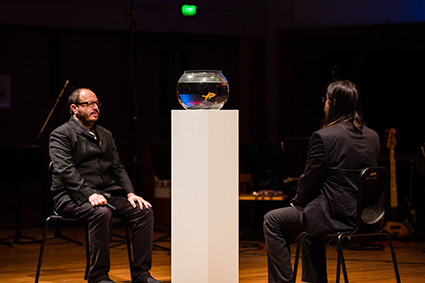
Members of Decibel perform Michaela Davies’ Goldfish Variation, After Julia concert
photo Lucy Parakhina
Members of Decibel perform Michaela Davies’ Goldfish Variation, After Julia concert
“THE REACTION TO MY BEING THE FIRST FEMALE PRIME MINISTER DOES NOT EXPLAIN EVERYTHING ABOUT MY PRIME MINISTERSHIP, NOR DOES IT EXPLAIN NOTHING.” JULIA GILLARD
Live concert events are theatrical, in that the kinetic presence of performers always invites some degree of visceral engagement from an audience. Whereas what we expect to see and hear from performance ensembles can be disrupted by the addition or subtraction of instruments, electronica per se also brings in invisible elements which can charge and redefine what we experience in new ways.
After Julia, works by women composers commissioned by the artistic director of the Decibel acoustic and electronica ensemble, Cat Hope, centres on the Prime Ministership of Julia Gillard and the discrimination to which she was subjected. Hope offered seven composers the opportunity to ‘give voice’ to their responses to this aspect of her term in office. Here, the parallels and interplay between visible and invisible, spoken and unspoken or muted forces at play, both politically and musically, were appropriately matched.
Gail Priest takes as starting point Gillard’s “everything and nothing” speech, turning the letters of her statement into a melodic line via simple MIDI transcription. Alto flute opens with a phrase of simple stepped notes, the piece becoming an imitative fugue first on clarinet, then strings. Cello and violin lengthen the first note of the phrase, allowing flute and clarinet to return—like some of Gillard’s detractors—with petty, trill undercuttings. The vibraphone builds turbulence until the overall melodic contour reaches a distressed high ‘b.’ The piece comes to a sudden stop: as in politics, endings can be short and sharp.
Thembi Soddell’s Your Sickness is Felt in my Body is inspired by studies published in 1995 on the physical and psychiatric effects of sexism on the female body. A scratchy ‘ill wind’ blows through flute and clarinet bores. Tonalities begin to widen between instruments; interventions from electronica prompt clarinet protests and squeals. A wire brush scrapes and irritates the bass drum; when assertive white mallets begin to strike, we finally see an overt source of pressure that builds and builds.
A crescendo peak falls back into a thin, tight, scraping. What caused this neurotic interlude? Who was responsible? It is perhaps in Soddell’s piece that the power of the ‘invisible forces’ of sexism—what Gillard calls “the small things that all add up”—is given strongest illustration.
Cat Hope’s Tough It Out begins in a sonic charting of the popularity ratings of national leaders over the past 20 years. String glissandi illustrate the rise and fall of polled ratings. Via headphones, the composer directs ‘interruptions’ inciting disruptions to the performance. The clarinettist coughs, splutters, shifts and stands; the violinist dislocates the cellist’s score; the clarinettist plays the back-end of his own bore. The piece ends with whispers ‘in a corridor.’ Who was in charge anyway? Gillard, a guest of the evening, quipped in a mid-concert interview, “I hope they are still talking to each other.”
Cathy Milliken’s Schifrorl opens with flute signalling a standard ‘homing cadence’ of V (dominant) rising to 1 (tonic) in a plaintive and slightly melancholic song. The flute fans open to a fugue with clarinet until a surprise mallet drops onto the kettle drum. Then, more ambiguous and disrupted cadences follow. Hammered piano chords are countered by slides on the cello. This is unstable ground.
Milliken’s piece is the least programmatic overall. Its textural contrasts—rattles, rolls, chips and gliss that thicken and thin—insinuate rather than illustrate a ‘court of intrigue.’ Which of the instruments—or who, or what—really holds power? Its closing stage brings a hint of ‘ill wind’ in its almost hurdy-gurdy sounds. Three harmonicas rasp and etch against a single piano bass note, and finish with an invisible yet audible and unnerving electronic thrum.
The presence of a goldfish in Michaela Davies’ Variation was a refreshing device but incompletely realised. Two musicians sit facing each other, a bowled goldfish placed on a plinth between them. What follows is an earnest, if timid, rendition-in-voice of the fish’s movement ‘score’. When the fish gets sleepy, vocalisations wane, until the whole is enlivened when a pinch of fish-food is dropped into the bowl.
While fish and bowl serve as a nice metaphor for the politician exposed to constant scrutiny of her every move, the piece would have benefited from more stringent dramaturgy. There is room for a much more dynamic engagement between fish, voice and singers’ bodies to amplify the absurdity of relentless scrutiny, small-minded commentary (small voices) and the hyperbole to which public lives are subject. The space per se, pared back to two + fish performers, cried out for this degree of theatricality. For instance I would have loved an extended extempore ‘melisma of the tail.’
Kate Moore provides an oracular poem to accompany her piece Oil Drums. Cross rhythms between piano and violin suggest tribal antagonisms. I picture battles in vast desert landscapes, shattered horizons, the incendiary threat to a vulnerable oil commodity. There is more than a hint of global economic, political and climactic pressures impinging on local concerns.
I’ve never heard a high ostinato before but the keyboards play it, high-flying sand blinding the air. This is a contemporary Apocalypse Now, both reminiscence and foreboding, wondering at the place of non-partisan decision-making that perhaps makes it Moore’s statement rather than one Gillard would have made.
The sound balance is unsatisfying, therefore it is quite hard to distinguish the interweaving of electronic against acoustic tonalities. It was an ‘I-could-have-heard-but-didn’t’ event. The final phrases, however, do seem to express the heroic in the career path of those ‘called to serve.’
Andree Greenwell’s Arrows I and II show the composer’s passionate belief in harnessing the expressive power of music to highlight both noble and mean-minded sentiments and reveal moral pressure points. Six young women, dressed in black, enter and line up behind microphones. There is a soloist and choir of three citing Gillard’s Prime Ministerial acceptance speech in a melodic sprechgesang, while the youngest two bark aggressive invectives such as those levelled at Gillard during her incumbency (‘bitch,’ ‘cow,’ ‘liar’). It is powerful to have the invectives delivered by the young. How conscious or unconscious is misogyny? Bowed vibes provide a high sharp note, leaving an ironic question hanging in the air: Why?
Arrows II is composed to a poem by playwright Hilary Bell. Greenwell provides sweet melodic anchors to counterpoint these sharp ethical questions, echoing Bell’s lyrics about ‘little arrows with poison tips,’ hinting at slow death by invisible forces. The ire and fire of politics. From the mouths of babes.
After Julia, Decibel New Music Ensemble [Cat Hope, Lindsey Vickery, Stuart James, Tristen Parr, Aaron Wyatt, Louise Devenish], vocals Helen Grimely, Sonya Holowell, Poppy Duwenbeck, Helen Hughson, Nicola James, Minna McLure; ABC Classic FM, Eugene Goossens Hall, ABC Ultimo Centre, Sydney, Nov 8
RealTime issue #124 Dec-Jan 2014 pg. 50
© Zsuzsanna Soboslay; for permission to reproduce apply to realtime@realtimearts.net
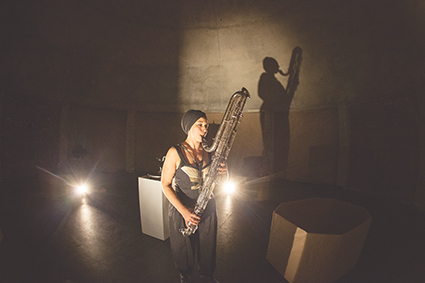
Aviva Endean in Half Light
photo Max Milne
Aviva Endean in Half Light
NO INSTRUMENT HAS BEEN WRENCHED FROM OBSCURITY AND THRUST INTO THE SPOTLIGHT BY CONTEMPORARY MUSIC LIKE THE BASS CLARINET. THE INSTRUMENT HAS INSPIRED AN IMMEDIATELY IDENTIFIABLE REPERTOIRE OF EXTENDED TECHNIQUES INCLUDING SHOCKINGLY-PERCUSSIVE TONGUE SLAPS, GUTTURAL GROANS AND FEROCIOUS, MULTIPHONIC ‘DINOSAUR NOISES.’
But the bass clarinet is also a gentle giant capable of enveloping the listener in a glowing aura of sound. It is this latter quality of the instrument that Australia’s most versatile clarinettist, Aviva Endean, explored in the resonant Norla Dome.
The dome is set inside Melbourne’s best kept secret, The Mission to Seafarers building. Built between 1916 and 1919, the Mission continues to provide lodging and services for seamen, as well as offering five different performance spaces ranging from the grandiose main hall to an enclosed courtyard. Most striking of all is the dome, which was once festooned with rigging for sailors to climb while on shore. It features a completely disorienting acoustic, with a focal point in the middle of the room where you can hear your words repeated back to you dozens of times. When the room was used as a boxing ring, being punched in that spot would have been a remarkable experience.
For In the Half Light, Aviva has teamed up with lighting designer Danny Pettingill and set designer Romanie Harper to create an immersive experience. The audience sits on cushions in cardboard pods around the space. On one side of the dome is a brooding pile of brown paper resembling a giant wasp nest. In the centre a pedestal displays a dish of water. A soft electronic tone (operated by Sam Dunscombe) emanates from the nest as light fades up inside. A clarinet begins to play against the tone, altering its tuning to produce strong beats. Endean emerges from the nest (through a side entrance; we are spared a ‘birthing’) and walks around the space, the mellow tone of the clarinet bending slightly as she moves.
The show is also full of charming site-specific details. From small holes in the nest, rays of light shoot onto the domed ceiling. Even the traffic on the nearby freeway and the crying of seagulls is somehow sublimated into something enchanted within the space. This effect is enhanced by Pettingill and Harper’s Gondry-esque crafted reproductions of the mundane, such as the small mobiles of mirrors that, when spun, shoot rays around the dome like passing car lights.
Within the frame of electroacoustic music, instruments are usually stationary sound-sources and speaker systems provide the means to diffuse the instruments’ sound throughout a space. In this work, Endean is mobile and the electronics are fixed. The dome, furthermore, throws Endean’s sound seemingly independently of her own movements. Sometimes it comes from behind you, or whispers in your ear. I cannot imagine a better space in which to explore this concert’s repertoire—including works by Endean, Sciarrino, Lucier, Grisey and Ambrosini—than the sound-microscope of the Norla Dome. But given the saturation of Australian contemporary music programs with whispering works on the very edge of hearing, I am beginning to look forward to the return of the dinosaurs.
Aviva Endean, In the Half Light, Norla Dome, Mission to Seafarers, Melbourne 14 Sept
RealTime issue #124 Dec-Jan 2014 pg. 51
© Matthew Lorenzon; for permission to reproduce apply to realtime@realtimearts.net
TO CELEBRATE ITS 15TH YEAR, THE MARAIS PROJECT—ITS AIM IS TO PLAY “ALL THE WORKS OF MARIN MARAIS (1656-1728) AND OTHER SIMILAR MUSIC FOR THE VIOLS”—MOUNTED AN INTRIGUING CONCERT TO PLACE THE MASTER’S FAVOURED INSTRUMENT, THE VIOLA DA GAMBA, IN A 21ST CENTURY CONTEXT.
First up was Marais un-re-imagined—a mellow E minor Suite from 1725 in which the viola de gamba seemed a little uneasy tonally and rhythmically, but after which the playing was immediately more confident. Three of four movements of saxophonist Paul Cutlan’s engaging Spinning Forth were presented, viola da gamba and harpsichord in dialogue, reaching atypically sweet heights and dark depths while retaining a Baroque feel, the viola da gamba at times harp- and even koto-like.
Pianist and composer Matt McMahon was looking for “an approach that takes the viola da gamba out of its traditional setting” (program note) in “At Carna,” an attractively melodic, folk-ish evocation of Ireland, for piano and a melancholy seven-string fretted electric version of the instrument, with its sometimes steely sound. Siebe Pogson’s “Dark Dreaming,” for bass and viola da gamba, both electric, and inspired by Jaco Pastorius, was song-like, layering the melody with a variety of techniques including plucked bass and seemingly extempore wordless vocals that headed in the direction of rock with nightmare intensity—the instruments becoming one disturbed voice.
McMahon’s “For Thomas Wyatt,” the 16th century innovative English lyrical poet, courtier and lover of Anne Boleyn, is eloquently elegiac, its melody Celtic, its tone dark; electric viola da gamba, piano and bass guitar in melancholy embrace. In jazz bassist Steve Hunter’s Three Rivers, as arranged by McMahon, viol and bass build the melody and are fluently joined by tenor saxophone (Cutlan) on its way to a full-bodied compelling solo, rising with feeling over the jazzy warmth of the ensemble. As ever, McMahon’s rich pianism produced beautiful, unexpected resonances. Finally, his arrangement of Guy Strazz’s Zawi (Ode to Joe Zawinul) paid tribute to the great Weather Report pianist in a performance that suggested both sadness and soaring liberation.
Re-Imaginings certainly conjured other ways of being for the viola da gamba, especially in its electric incarnation—releasing a greater range of sound: double bass and cello-like, firm but warm—in Jenny Eriksson’s more than able hands.
The Marais Project, Re-Imaginings, Sydney Conservatorium, 26 Oct
RealTime issue #124 Dec-Jan 2014 pg. 51
© Keith Gallasch; for permission to reproduce apply to realtime@realtimearts.net
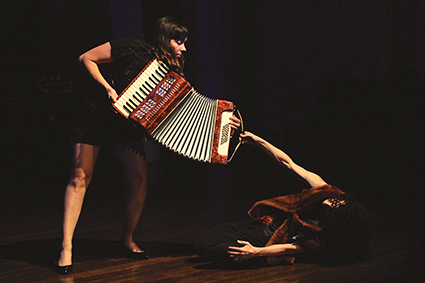
Bree van Reyk and Narelle Benjamin
photo Heidrun Löhr
Bree van Reyk and Narelle Benjamin
THE SECRET NOISE IS COMPOSER AND DEVISOR DAMIEN RICKETSON’S RESPONSE TO THE WAYS HIS CONSCIOUSNESS BECOMES HEIGHTENED WHEN HE PERCEIVES STRANGENESS IN SOUND OR SENSATION. IT’S A POETIC NUDGE AT THE SECRECY STILL ENTRENCHED IN STAGED ART MUSIC—WHERE PERFORMERS USUALLY WEAR BLACK, ACTING AS DEPERSONALISED TRANSMITTERS OF OTHERS’ GENIUS, WHERE THEIR EXPERIENCE IS NOT THE SUBJECT OF PERFORMANCE.
This collaborative music/dance/theatre work communicates not only the sound of music but also the experience of musical process as reception, memory and fantasy. It’s a critical commentary on our understanding as concert-goers of interpersonal musical exchange. What if ‘classical music’ were individually tailored and responsive at all times?
Ricketson was curious (his company/website is Curious Noise) about how to present those elements of music that are personal, undisclosed or mysterious. His exposure to private musical encounters that happen in public space, like ours, are frequent and often unworthy of mindful note. But those moments on the fringes of public experience inspire this collection of musical scenes which, coupled with dance from Kathy Cogill and Narelle Benjamin, and theatrical moments from Katia Molino, stage a world of absurd yet anything-but-hokey utterances. Ricketson, Ensemble Offspring and stage director Carlos Gomes have struck the right balance of exploration-to-permissible action here with the subtle coercion of parents, highly attuned to the rebellious habits of those they lead. Their psychology is always a step ahead of ours, guiding us to come to their realisations about the diversity of public and private musical sensations.
Our tickets are A4 and graphic scores that we can colour in or otherwise mark. As we enter a very gruff door-bitch (Molino) inks them violently with a Secret Noise stamp before ceremonially snapping a CD in two as a passing ritual. We are lead into the giant, low-ceilinged room below Sydney’s Town Hall in which five large seemingly fire-lit tents glow invitingly. From each sounds emerge, but there are no instructions, we must follow our noses and snoop. Each tent allows three curious folk in at a time and our tickets become the musical instructions for the performers inside. In one Claire Edwardes rings hand bells; in another Jason Noble has an assortment of whistles and a lyre; in another dancer Narelle Benjamin contorts into pretzel shapes with Indian hand-cymbals dangling from her toes while staring intently into the eyes of the few lucky entrants. Do bells sound better when your lower limb is perched on your shoulder? How about when they’re so close you can smell the metal?
Before we’ve had time to explore every tent we’re ushered towards seats that frame a long and narrow stage. The ‘real music’ begins. Dancers slink into the central space, spinning objects attached to strings over their heads. On close inspection we agree the objects are (brand-new minty-fresh) toilet brushes. One whirling brush makes a whizzing sound. In combination, two sound like currawongs. Three make for an R&B synth solo. This spinning gesture returns with other objects attached; later Molino flings a thicker one that sounds like a far-away traffic jam or distant train. Meanwhile clarinettist, Noble, lies down, gliding across the floor on his back while contributing a steady tone. Together they create the drone of the dreaded mozzie that keeps you up all night.
A more conventionally musical moment, where seated players staring at music stands made sounds, seemed the kernel of the work. The dancers couldn’t contain their curiosity and buzzed around the musicians, responding to the secretive sounds. Some interrupted the players with movements and exaggerated faces; their interference produced the energy that the musicians then encoded in sound. One dancer became a stole that slipped down the back of the seat behind a player. A chaotic tango arose —polyphonic in the extreme—in that each player emoted and swayed, performing with exceptional lyricism, in absolute ignorance of the ‘musical genius’ around them: every one a soloist. This scene captured the sensation of playing in an ensemble of battling egos—the music sounding as that circumstance feels. This tango grew legs, slipped to centre stage, abandoning the mass-ensemble. It tripped and drowned purposefully between Bree van Reyk on a fully unfolded accordion that became one with a sinuous Benjamin.
There were loud hailers, tubular bells, decks (turntables) and two saws played with violin bows, vibraphone, drum kit, black gowns and skulking chairs in which the dancer-actors slid towards the music. Under Carlos Gomes’ direction, the mediums for the performers became equally musical, theatrical and choreographic—it didn’t matter whether sound emanated from the action or energy was transferred. They communicated something else, something formless that belongs to all of us.
Throughout The Secret Noise, Ensemble Offspring and friends created an exploratory space that really worked (where many similar collaborations fall short): it felt natural, feasible and, at times, familiarly facile, as when we find ourselves alone, listening to the chatter of the air-conditioner or the hiss of our own nervous system.
Audience participation in The Secret Noise felt comfortable—no awkward, self-conscious delays—those displays of learnt humility—upon invitation to join in. The creative team fashioned an environment and culture that invited inquisitiveness. Towards the end cushions were delicately laid about the stage. Again, no instructions were given, but somehow we knew that we were invited to inhabit the stage, to lie on the floor and perhaps glide as the performers had earlier. So we too experienced the music on a horizontal plane, while locomoting backwards, navigating space and strangers.
As Saturday nighters bustled above the venue, dance music and drunken antics often bled into the space. Given the eclecticism of The Secret Noise’s aesthetic, this ‘noise’ was not unwelcome. It situated the work in the city and layered our attention on multiple simultaneous scales. No sound ever exists in isolation and yet many expect perfect art music performance to happen in a coughless, car horn-less vacuum. The partiers had no idea what we were listening to, seeing or feeling—it was our little underground. They showed us, in their obliviousness, how special these secret noises and moments were that we shared.
The Secret Noise, Ensemble Offspring, concept, composer Damien Ricketson, director Carlos Gomes, devising performers Bree van Reyk, Claire Edwardes, Jason Noble, Kathy Cogill, Katia Molino, Narelle Benjamin, lighting design Fausto Brusamolino, Lower Sydney Town Hall, 20-22 Nov
RealTime issue #124 Dec-Jan 2014 pg. 52
© Felicity Clark; for permission to reproduce apply to realtime@realtimearts.net
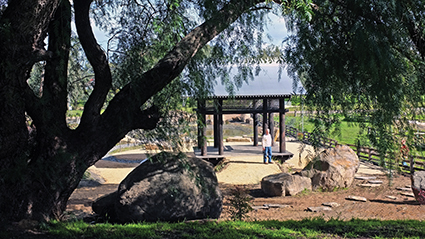
Chinese Gardens
photo Lyndall Jones
Chinese Gardens
ABOUT HALF AN HOUR OUT OF AVOCA ON THE ROAD FROM BALLARAT YOU ENCOUNTER A PARTICULAR TREE-LINED STRETCH SUBTLY DIFFERENT FROM THE USUAL AUSTRALIAN COUNTRY ROAD. DIFFICULT TO IDENTIFY AT FIRST. WHAT MAKES IT SEEM UNCANNY IS THE REGULARITY OF THE TREES, PLANTED CAREFULLY TO MOMENTARILY HEIGHTEN THE PERSPECTIVE OF ROAD TRAVEL. THEY REMINDED ME OF NORTHERN ITALY.
Like the wineries and tiny steep-roofed chapel along the roadside, this intervention marks the agricultural enterprises and aesthetic expectation that continental European settlers brought here. Australian cities celebrate their multicultural heritage, yet too often the diverse cultural influences of rural Australia, of the various populations that have cultivated and re-imagined this land over the years, are subsumed into the homogenising voice of a predominantly English colonial history. There is a history of intertwining landscape aesthetics written into these surroundings that remains under-explored.
Almost entirely absent from Avoca and the surrounding landscape are obvious traces of the tens of thousands of Chinese miners who travelled to Victoria to create a future for themselves in the Gold Rush of the 1850s. Largely shunned by European populations at the time, the Chinese miners had a difficult experience on the gold fields and many returned to China, even posthumously, after the gold rush had run its course. Issues of singular and exploitative economies such as mining, along with the immigration, cultural exchange and xenophobia that accompany them, become questions that are historically specific for Avoca, yet still contentious for many parts of Australia.
Towns of the Victorian goldfields give us a glimpse beyond those heady days of dynamic economic possibility. Avoca was one of five very small towns in Victoria (with populations under 1500) awarded funding under the Small Town Transformations project instigated by Regional Arts Victoria (RAV), funded to commence in May 2013 and to be completed in October 2014. “This project is all about the creative power of art to make place. It invites you to be ambitious in imagining what transformation might mean for your town—now, and into the future” (http://smalltowns.rav.net.au). This project opens up space for an important dialogue about how communities struggling with the after-effects of structural economic change and the dwindling populations that accompany it might imagine their own transformation through art. The provocation by RAV is specifically to explore how art-as-infrastructure might contribute to creating resilience and longevity. In doing so it offers an alternative, and potentially a challenge, to more familiar forms of cultural intervention in rural Australia, such as travelling shows and/or transient or event-based community development projects.
The Garden of Fire and Water is Avoca’s response to this question of transformation. A garden is an interesting spatial model to explore: artistic gardens have a unique historical position as places of pleasure that exist external to requirements of function, embodying opportunities for events and durational inhabitation as well as aesthetic and internal contemplation. “For the garden is both spectacle and stage, existing simultaneously as an artwork in itself and as the site of the representation, conjunction and synthesis of all the other arts.” (Allen S. Weiss “Unnatural Horizons: Paradox and Contradiction in Landscape Architecture”, Princeton Architectural Press, Jan 1998).
For Avoca, the opportunity for evolving curation, such as for Chinese New Year, will be an important aspect of its transformative impact. Due to a garden’s unfinished qualities, requiring constant cultivation and attentiveness, the collaboration with the community also necessarily unfolds into the future. Within the space of the garden itself, the project therefore also invites the community to co-create its future unfolding. In deciding on a Chinese garden, the project throws out a further interesting challenge: to consider questions of identity, aesthetics, belonging and land in Victoria. Lindy Lee, a celebrated contemporary Australian artist, whose work explores questions of identity and authenticity, including her own Chinese-Australian heritage, led the project.
Lee worked on the project with Lyndal Jones (artistic director for the garden and associated events), Mel Ogden (designer and project manager) and Martin Wynne (soil expert) as well as a local residents’ committee led by Jane Howe. Jones, who is Professor of Contemporary Art in the School of Media and Communications at RMIT University, bought the neighbouring Watford House around 10 years ago to create a durational art work The Avoca Project (http://www.avocaproject.org/). As she describes it, the prefabricated house imported from Hamburg in 1850, as were many structures during the Gold Rush, is itself an immigrant. Layer upon layer of intermeshed meaning and reference, as a deliberate blurring of situation and art, characterises her curation of the house; and now the Chinese Garden.
Alongside the launch of the garden, the Avoca Project hosts an exhibition exploring ideas of ‘China’ by a number of Australian artists, as well as serving as a sort of index to the garden project in its inclusion of drawings by Ogden and Jones’ own work inspired by a journey to China in the 1980s. An ongoing collaborator, Ogden has designed courtyard spaces and verdant platforms around Jones’ house that are also anticipated as spaces of unexpected performance and celebration. Wynne has also previously been involved with Jones at the Avoca Project, creating soil cocktails for a project called “XSpecies: Soiree of Earthly Delights.” The entire team seem to share an attitude of duration and careful attention in their own practices: from Lee’s Zen Buddhism, Wynne’s soil cultivation, Ogden’s landscape gardening to Jones’ long term and inhabitable artwork.
The result of their collaboration occupies a simple rectangle of earth on a gentle slope tucked behind the main street and facing the Avoca River. The remnant frames of the old timber sale yard fences enclose it. A small public space along this section of the street connecting the pub down to the river flats was also created in the project. Monthly farmers’ markets are held at this corner, spreading out along the riverside. Trees planted along the edge of Cambridge Street, once they grow taller, will contain the garden visually and provide much needed shade for the public space. Through circular metal garden gates, clear paths lead to a central pavilion: a shaded space to stop and contemplate, as well as framing a view that borrows from the bucolic river flood plain.
Lindy Lee’s scorched metal sheets, that continue her long-term engagement with ideas of the element of fire, provide simple ornamentation to the pavilion structure that is also clearly influenced by the Australian shed. “I think what we’re creating in this garden is a really beautiful and particular kind of Chinese-Australian vernacular” (http://vimeo.com/106165131). The garden’s vegetation too is a combination of borrowed species, such as bamboo and cherry blossom, brought together with natives. Downhill from the pavilion you pass a small pond with water lilies and reeds. In keeping with the frugal sensibilities of a region used to making the most of scarce resources, the pond and tanks perform the double purpose of capturing and filtering storm water from Avoca’s main street. At the very bottom is a stone garden, for which most of the rocks came from local farms. Nestled among them is another of Lee’s contributions—a polished-metal scholar stone. Through its framing and borrowed referents this garden contributes a new layer to the complex and ongoing aesthetic dialogue written into this local context.
Yet the Chinese Garden in Avoca is not as exotic as it may at first appear. Architects and artists who travelled to China at the end of the 17th century returned home to Europe richly inspired by the irregular beauty of Chinese garden design. This exotic influence led to a shift away from the regularity of traditional European gardens marking a larger paradigm shift in the development of European landscape aesthetics, a process at its height when Australia was being first settled. This aesthetic arguably acted as a transformative filter, reflecting the cultural and economic desires of the settlers and inscribing them on the landscape. With their eyes looking for the picturesque interest of the European landscape, Paul Miller identifies regular references to monotony in settlers’ written account of this unfamiliar land. “An utterly monotonous landscape bears no relation to the travellers’ world, to their history or their culture, and that is to say that for a particular landscape to be or not to be a part of culture depends on whether that land is a priori part of the mind that experiences it” (Paul Millar, “Monotony and the Picturesque: Landscape in Three Australian Travel Narratives of the 1830s,” Journal of the Association for the Study of Australian Literature, 1997).
It is worth pondering how Chinese garden aesthetics, or a straight row of trees along the side of a road, are more familiar to my narrowly trained eye than any signs of Indigenous culture and guardianship of the land. Looking across the river flat, where the new pavilion sits as a garden folly, Lyndal Jones remarks how unexpectedly the Chinese Garden sits far more comfortably in Avoca than at first anticipated.
Regional Arts Victoria, Small Town Transformations, Avoca Chinese Garden, Avoca, Victoria, opened 11 Oct; other projects are The Quarry Ephitheatre, Dookie; The Verj, Natimuk; Neerim Bower: Inspired by Birds, Neerim South; Mallee Up In Lights, Ouyen.
RealTime issue #124 Dec-Jan 2014 pg. 53
© Anna Tweeddale; for permission to reproduce apply to realtime@realtimearts.net
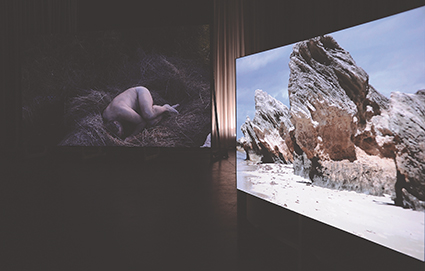
Kate McMillan, from Moment of Disappearance installation
photo Heidrun Löhr
Kate McMillan, from Moment of Disappearance installation
PERFORMANCE SPACE’S BURUWAN SEASON, FOCUSED ON CULTURAL FORGETTING AND RECALL, INCLUDES MAJOR WORKS BY LONDON-BASED WEST AUSTRALIAN KATE MCMILLAN AND CAIRNS-BASED TORRES STRAIT ISLANDER KEN THAIDAY. INTERVIEWS WITH THESE ARTISTS AND IMAGES OF THEIR WORKS CAN BE SEEN ONLINE IN REALTIME PROFILER 7.
Kate McMillan’s The Moment of Disappearance elegiacally conjures islands on multiple screens and cardboard rocks in an installation funereally draped with veil-like curtains. These places are ‘isles of the dead,’ where Aboriginal Australians were imprisoned, perished and forgotten—Rottnest Island (Wadjemup) and Tasmania (Lutruwita), Port Arthur in particular. McMillan also invokes a third island, Pontikonisi, alleged to be the Isle of the Dead featured in Arnold Bocklin’s famous 1880s paintings of that name. Here she stages one man’s representative flight into madness, his isolation, his ferocious grappling with nature and his ghostly fading. In her interview, McMillan describes the making of the work and her feelings about these islands and their forgotten or repressed histories.
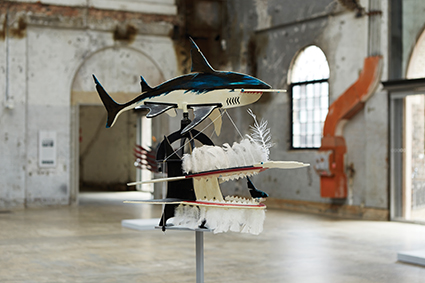
Ken Thaiday Snr. Hammerhead shark (beizam) headdress 2001
photo Zan Wimberley
Ken Thaiday Snr. Hammerhead shark (beizam) headdress 2001
Ken Thaiday’s impressive array of Dhari headdresses—his “dance machines”—are exhibited in the Carriageworks’ foyer. Meant to be worn for ritual dancing, they embody the power of Torres Strait Island totem animals—the shark and the frigate bird. Thaiday, a keen innovator, has integrated modern materials (including recycled waste) into their construction, which include moving parts—wire, fishing line, clips and hinges. A giant, three-metre tall Dhari, designed to frame a performance, dominates the space.
Thaiday sustains Torres Strait Island culture with his Dhari and other sculptural works (which include a magnificent, meticulously crafted lobster). In our interview, Thaiday speaks of the purpose of his work, his materials and his fervent commitment to Jesus, who provides him with the inspiration to preserve his traditional culture.
These two shows bring home the power of art as active remembering and reinvention and politics as denial or calculated forgetting.
Interviews, Profiler 7
Carriageworks & Performance Space, Ken Thaiday; Performance Space, Buruwan: Kate McMillan, Moment of Disappearance, curator Bec Dean; Carriageworks, Sydney, 2 Oct-23 Nov
RealTime issue #124 Dec-Jan 2014 pg. 54
© Keith Gallasch; for permission to reproduce apply to realtime@realtimearts.net
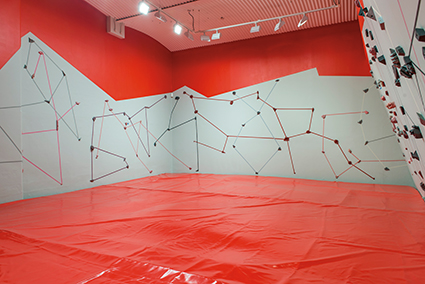
Kinesphere
photo Alessandro Bianchetti
Kinesphere
OVER THE LAST FEW YEARS, ERIN COATES AND HER TEAM HAVE BEEN CLIMBING THE PUBLIC ART AROUND PERTH AS WELL AS APARTMENT BLOCKS, HIGHWAY RETAINING WALLS AND SUPERMARKET BUILDINGS. HER EXHIBITION KINESPHERE IS THE CULMINATION OF ALL THIS EFFORT, SHOWING OFF BODIES AS THEY LUNGE AND TENSE FROM ONE HOLD TO ANOTHER. A VIDEO OF THEIR CLIMBS, AND SOME PARKOUR TOO, IS PLACED INSIDE A SEVEN-METRE BLACK MONOLITH THAT RISES IN THE CENTRE OF THE GALLERY. IT IS A MONUMENT TO THOSE MONUMENTS AROUND THE CITY THAT COATES HAS REPURPOSED.
The best video footage is of the climber at risk, when Coates herself is suspended underneath a ridiculously ugly public sculpture, swinging from side to side, hanging precariously for our viewing pleasure. At such transcendent moments the point of Kinesphere comes to the fore, as physical performance confronts the legacies of modern art, the ecstatic affects of the body in motion bringing the dead spaces of our civilization to life. In watching performances like this our neurones enact the same pathways as the climbers themselves, and their pleasure becomes our own.
There is another video here too, a brilliant little film called The last climber alive must keep herself fit and ready, in which a pint-sized performer climbs walls and exercises high on the rooftops of a miniature model city. She lives in a world without people, a single body lost amid the concrete. The last climber… is an intimate contrast to the massive ambition of the central installation, with its towering geometries and bodies at their limit.
The most innovative part of the show, in which art and climbing comes together most evocatively, is in a series of bouldering walls tucked into one of the gallery spaces. The room is decorated with colourful handholds and lines drawn between them, geometries of colour and line tying the body and the eye together. Here the art really is climbable, and during the exhibition many children clambered over each other in a wonderful array of splayed little bodies. At last, I thought, PICA have coincided their exhibition program with Perth’s Awesome Arts festival for children, which always lives up to its name with a packed program of quality installations and performances that impress kids and adults alike.
Alas, the young invigilators were unhappy with this proliferation of fun and joy in the gallery, and prevented the youngest from climbing, telling their parents the installation was not for children! Coates’ installation proved once more that art galleries are failing to do what they are designed for, to affirm what we all share as human beings, to poke and prod at the ways in which we have been embodied in the world, to celebrate life and its vicissitudes. Such aims are better achieved outside the gallery, aloft and clinging with a climber’s nimble hands, or even on the internet, where videos of such performances abound.
Erin Coates, Kinesphere, Perth Institute of Contemporary Art, Perth, 13 Sep-2 Nov
RealTime issue #124 Dec-Jan 2014 pg. 55
© Darren Jorgensen; for permission to reproduce apply to realtime@realtimearts.net
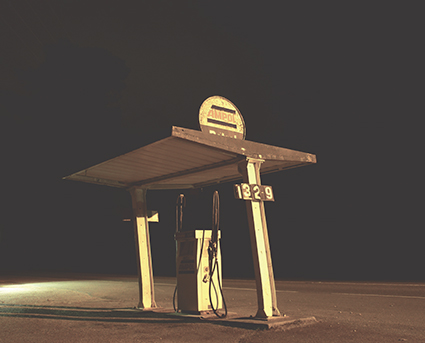
Book: Alex Frayne, Adelaide Noir
From Adelaide’s stylish Wakefield Press comes Adelaide Noir, an evocative large-format photographic account of the city by local artist Alex Frayne. Filmmaker Matthew Bate writes in his introduction, “[Alex has] found a portal into our sleep. He’s able to take snapshots that he can bring back and show us. It sounds like the plot of a bad 80s sci-fi film but these one-frame narratives are cinematically compelling. Long exposures reveal the shimmer of events just missed or about to happen.”
3 copies courtesy of Wakefield Press
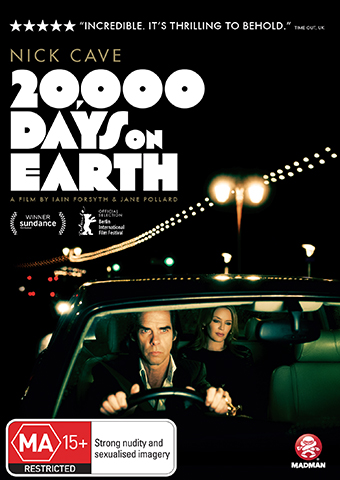
DVD: Nick Cave—20,000 Days on Earth
Inventively directed by Iain Forsyth and Jane Pollard, this fictionalised documentary about a day in the life of the musician and writer offers us a Nick Cave persona to ponder. Get out of bed with him, deal with the kids, go to therapy, to a recording session, perform in a concert and bump into friends, like Kylie Minogue. The UK Guardian described it as “[l]ess of a biography than a widescreen installation with script and music (Cave’s co-writing credit confirms the artifice), this flits between handsome neo-noir pastiche and ripe psychological melodrama” (21 Sept, 2014).
5 copies courtesy of Madman Entertainment.
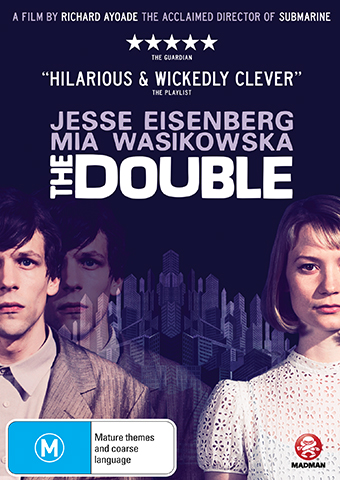
DVD: The Double
Directed by UK actor Richard Ayoade (The IT Crowd, Gadget Man), who also made the acclaimed Submarine, The Double is about a young man who is faced with the frightening arrival of a more confident, identical version of himself at work—no one else notices. Based on Dostoyevsky’s The Double with a touch of Cyrano de Bergerac, this is an intelligent dark comedy with Jesse Eisenberg playing self and other, with Mia Wasikowska as the object of their joint desire.
5 copies courtesy of Madman Entertainment
Please note you can nominate for ONLY ONE GIVEAWAY.
Email us at giveaways@realtimearts.net with your name, postal address and phone number.
Include ‘Giveaway’ and the name of the item in the subject line.
RealTime issue #124 Dec-Jan 2014 pg. 56
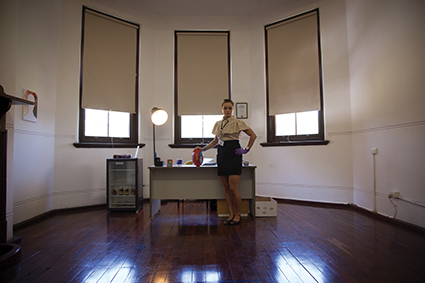
Tarryn Ruukel, The Queue
photo Peter Cheng
Tarryn Ruukel, The Queue
HELD AT THE FREMANTLE ARTS CENTRE, THE WARREN-LIKE STRUCTURE OF SANDSTONE, COURTYARDS AND GARDENS OF A RE-PURPOSED MENTAL ASYLUM, THIS YEAR’S PROXIMITY FESTIVAL MICRO-PERFORMANCES TAKE FULL ADVANTAGE OF THE VENUE’S HISTORY, QUIRKS AND HIDDEN CORNERS. PERFORMANCES HAVE BEEN THEMATICALLY CURATED INTO GROUPS OF FOUR EACH FOR PROGRAMS A, B AND C, EASILY FOUND WITH THE AID OF THE UNIQUE GUIDING PROGRAM FOR EACH PARTICIPANT, COMPLETE WITH A MARKED VENUE MAP, AND THE STRATEGICALLY LOCATED, HELPFUL USHERS. TIMEKEEPING IS ENFORCED BY A SYSTEM OF HANDBELLS, RUNG PRECISELY ACROSS THE SITE TO SIGNAL THE START AND END TIMES OF EACH PIECE.
Program A is the top pick for anyone unfamiliar with one-on-one performance. It’s full of new experiences, providing plenty of interesting moments to share afterwards—learning to twerk, teaching someone to drive, crafting a clitoris out of sweets and undergoing an interview for the right to stay in Australia. Each of these presentations delivers more than its basic premise, but the standout work is Toyi-Toyi Theatre’s The Queue where you are reduced to just another item on the list of tasks for the presenter to process, the emotional challenge amplified by its contrast with the friendly interactions with other presenters in the program.
By the door is a stack of clipboards, with pens. On the bell, I obediently fill in a government-style form, only to be interrupted by the door opening and an impatient Tarryn Runkel telling me to skip through it but to pay attention to the last page and sign my acceptance of the condition that to fail this Right to Stay interview will result in deportation to my “home country” without the right to see my friends or family here again. I sign. I am tested on my knowledge of Australian history, slang and how to pass in Aussie Rules football. Physical tests include arbitrary complexion and hair inspection, the piece climaxing with a modern version of the notorious dictation test before the inevitable stamping with “DEPORTED” and brisk removal out the door. The personal and political merge, my sensation of helplessness and outraged reaction exacerbated when I realised that the relief I felt at having failed stemmed from racist assumptions.
Program B is the choice for the thoughtful participant, open to new ideas and challenges to engage in mindful activities. Experiences encompass a workout session completed while sharing a specially designed suit with the trainer, an invitation to embark on an emotional fast, a dialogue in the language of flowers and an intimate experiment in generating oxytocin. Each piece requires full engagement to be effective, and each continues to provide food for thought long after the final bell.
Of this program, Tetherweight (for Adrian Howells) stands out as the most challenging work, an antithesis of traditional performance in its demands for an introspective response from each audience member, and yet perfectly executed in this celebration of one-on-one performance. The initial knocking at the door, the soothing music selection, James Berlyn’s gentle voice in the darkness and a heaped pile of clocks all create a waking dream. The carefully scripted text, with its references to “the swing,” makes it natural to move onto the tilted gym equipment, which is set in motion in pitch blackness. The swing, unobtrusively evoking emotional states with its movement, creates a sensation of weightlessness while simultaneously combining the comfort of a cradle and the thrill of a rollercoaster. Moving to a quiet space to write, I accept the invitation to record what triggers strong positive and negative emotions in me and to place it in an envelope as a gift to my future self. Accepting Berlyn’s proposal to commence an emotional fast, I leave with an anklet gently offered to mark its beginning. I am feeling incredibly refreshed and a little dream-laden, as after deep meditation.
Program C has most to offer to those accustomed to one-on-one performance, happy to dive deep into its potential for surrealism. All pieces play on sensation and perception, with a bar offering tastings of air from different eras, a physical challenge to attempt tasks while deprived of selected evolutionary advantages, wafts of scent unfolding an unsolved mystery and a bombardment of words travelling through time before the entry of a surprise dance partner.
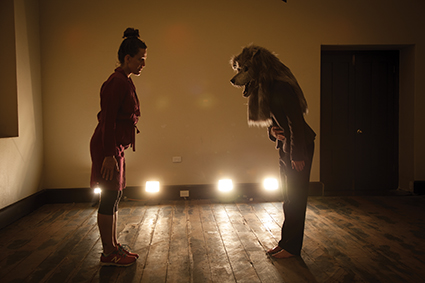
Dance with Me
photo Peter Cheng
Dance with Me
Each of Program C’s presenters show mastery of the intimacy and mind manipulation possible with a single audience member, but Dance with Me amazes on two fronts. Sylvia Rimat creates an intimate experience without being physically present, and then shocks me by introducing a dancing wolf.
I enter a sparsely furnished room, dismissing the disembodied voice that greets me on entry as a recording, until it describes my physical appearance. Following the voice’s instructions, I find myself performing innocuous tasks such as sitting at a table, adjusting a light and pouring water. Pressing ‘play’ on a cassette recorder introduces overlapping voices: instructions together with descriptions of people from bygone times in an increasingly dense and hallucinatory auditory experience. As I obediently feel the texture of a wall and read a note about hot shrimp from a pile of crumpled pages, suddenly the measured voice of a man is twinned with the order to pick up a glass and break it over his head. More voices crowd in, filling the empty room lit only by a table lamp, before a blast of music and flare of light from hitherto unnoticed stage lights. A side door opens and a slim figure, bearing the head and neck of a wolf, lightly dances its way in front of the lights before standing by me, inviting me to dance. We take simple steps, gradually moving into an old fashioned waltz, the bulging plastic eyes of the mask looking deeply into my eyes with an odd sense of intimacy.
The music ends, the wolf bows and leaves, the lights fade and a bell rings… I leave the room and its whispers to return to the calm ushers and excited participants mingling in the corridors.
–
Proximity Festival 2014, co-curator, producer Sarah Rowbottam, co-curator Kelli Mccluskey, artists James Berlyn, Caroline Garcia, Jen Jamieson, Cat Jones, Loren Kronemyer, Tanya Lee, Emily Parsons-Lord, Sylvia Rimat, Hallie Shellam, Ian Sinclair, Alina Tang and Toyi-Toyi Theatre; Fremantle Arts Centre, Fremantle, 22 Oct-2 Nov
RealTime issue #124 Dec-Jan 2014 pg. 20
© Nerida Dickinson; for permission to reproduce apply to realtime@realtimearts.net
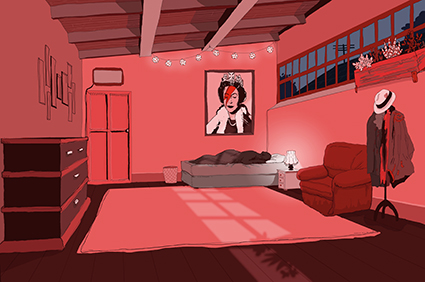
Christy Dena, Magister Ludi, 2014, in collaboration with Marigold Barlett, Trevor Dikes, Cameron Owen
JONATHAN PARSONS, ARTISTIC DIRECTOR OF THE HIGHLY SUCCESSFUL ISEA2013, WAS SUBSEQUENTLY APPOINTED TO THE SAME ROLE FOR MELBOURNE-BASED EXPERIMENTA. DARREN TOFTS SPOKE WITH PARSONS ABOUT HIS PROGRAM FOR THE ORGANISATION’S 2014-15 BIENNIAL, RECHARGE.
Experimenta’s last biennial Speak to Me was topical in terms of its theme of intimacy. This year’s Recharge seems much more reflective about Experimenta itself, media art and the notion of a bienniale: what’s your thinking on these issues?
It’s both. The theme emerged in response to researching current and recent work from media artists here and internationally. This investigation process coincided with having just joined the Experimenta team in the newly created role of Artistic Director. It’s perhaps not surprising that the 6th International Biennial reflects some broader thinking about the meaning of the organisation’s name and the role of biennials in general.
What do you mean?
Biennials by their very nature, in repeating presentation formats, are always in part a survey of current practice. As a curator of these types of visual arts ‘festivals’ you have an opportunity to not only document what’s happening in the present but to also act as a catalyst to foment future developments and directions within the artistic community. Through the presentation of the works and their associated public programs you hope to stimulate conversations and networks that act as a ‘recharge,’ inspiring artists to take the next steps in their practice, find new collaborative partners and for audiences to become more curious and adventurous.
This will be my first biennial since I took on the position, so it’s timely to reflect on where Experimenta has been and where it may go, particularly as it approaches its 30th year of operation in 2016. Not only have I been thinking a lot about what it means to be working in one of Australia’s key media arts organisations, but also the name ‘Experimenta’ itself. While the exhibition title refers to some of the great work happening now it also looks forward to consider what role experimentation plays in culture as it can transform the way we look at the world and recharge our views.
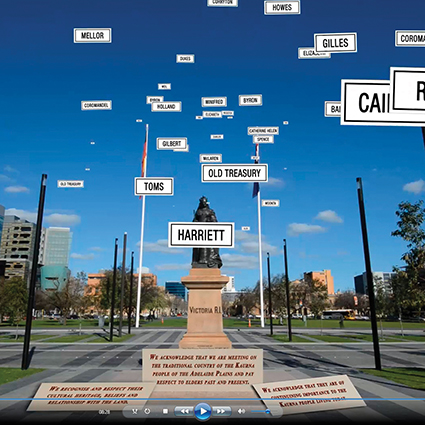
Raymond Zada, Acknowledged (2014) video
courtesy the artist
Raymond Zada, Acknowledged (2014) video
In thinking about this biennial’s theme, along with my associate curators, Elise Routledge and Lubi Thomas, we wanted to focus attention on artists whose work is inspired by and entangled with the past. Arguably all artists look to the past in creating their work but we were particularly interested in asking the questions: does knowledge change when it is presented in different technological forms and cultural contexts? Through processes of experimentation and by producing unconventional perspectives, can artists illuminate existing knowledge for new generations? The artists in the biennial are alert to both the intimate and the broader cultural contexts through which they move and live. By listening, watching, thinking and making, they recharge knowledge and meaning systems, reinvigorating these systems or radically transforming them.
Experimenta has really broadened the scope of the Biennial in that the exhibition’s touring component has become such a strong part of getting the work to a broader public. Where is it touring after its Melbourne installation?
Experimenta produces the only biennial in Australia that travels nationally. It was very clear as we set up the tour after the exhibition opens in Melbourne that we could have continued touring it well beyond the middle of 2016 from the number of requests we have had to present the exhibition elsewhere. This is a real testament to the work of my predecessors who established this model in 2003 and have toured every biennial since then. Through this Experimenta has been instrumental in developing audiences for media artwork across Australia. We plan to tour Experimenta Recharge throughout 2015 until the middle of 2016 and will visit Mildura, Newcastle, Brisbane, Cairns, Warrnambool, Albury and Morwell.
Tell me about the EMARE initiative. This is really exciting in that it consolidates the profile of the biennial as an event involving international partnerships.
The EMARE initiative is a clear indication of Experimenta’s standing internationally. When the European Media Art Network was looking to follow on from their successful residency exchange program with Mexico in 2011-12, they decided they would like to broaden the exchange to involve two countries outside of Europe, choosing Canada and Australia. Having decided on Australia as one of the participating countries it was Peter Zorn, from the Werkleitz Centre for Media Arts in Halle, Germany, who came to Australia to research potential partners and led the application to the European Union. Experimenta was already on his list before he came because of its profile internationally.
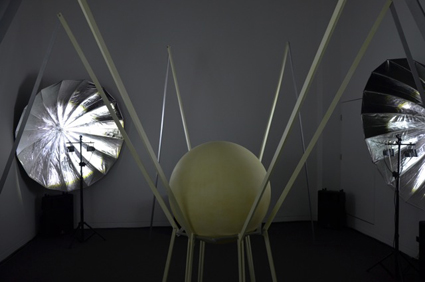
Multi-channel sound installation by Abel Korinsky, Experimenta: Recharge
photo courtesy Korinsky Brothers
Multi-channel sound installation by Abel Korinsky, Experimenta: Recharge
The two other Australian partners in this two-year residency exchange program are The Cube at Queensland University of Technology led by Senior Curator of Digital Media Lubi Thomas and Andrew Johnson, Co-Director of the Creativity and Cognition Studios at the University of Technology Sydney. Two of the European artists participating in this exchange program will be featured in the Biennial. Experimenta is hosting Abel Korinsky as part of the three-member artist group Korinsky, who are all brothers, in Melbourne with support from RMIT’s International Artist in Residence Program and the Goethe Institute. He will create a new work for the Biennial entitled Big Bang, an immersive sound installation inspired by the recent announcement by researchers at the Harvard-Smithsonian Centre that they have documented soundwaves from soon after the birth of the universe. Korinsky’s work asks, ‘What would it sound like to hear all the sounds of the past and present? How would it change our perceptions of time and of death?’
The other artist to feature in the Biennial through the EMARE initiative is Anaisa Franco, a German/Brazilian artist currently in residence at UTS. Three of her interactive sculptures will be presented from her Psychosomatic series, two existing works and a newly created piece. These works will react to the presence of audiences and embody different human emotions. This will be the first time these artists have been presented in Australia and indeed, with the exception of Maitha Demithan from the United Arab Emirates (see cover image), the four other international artists represented in the Biennial will be introduced to Australian audiences for the first time. The culmination of the EMARE initiative will be a group exhibition of all of the participating artists in Halle, Germany in October 2015. This will feature four Australian artists including Matthew Gingold who has previously exhibited with Experimenta.
There are many critical views about the end of media art, or assertions that it should simply be part of the art world generally. What’s your response to this, especially in relation to the work in this year’s Biennial?
I certainly think that it is maturing. Gone are the days when the incorporation of digital media into an artwork automatically made it cutting edge or experimental. With that a certain youthful energy and dynamism has dissipated. This is felt primarily by those who remember the heady days of the 80s and 90s when we saw the invention and proliferation of the personal computer that gave birth to the sector. At the same time, audiences for this work have greatly expanded. I’d say there are larger audiences who on average are having richer experiences. You had to be a pretty dedicated audience member for this work in the early days—so often you would see exhibits not actually working, so by default the work often had to be viewed as conceptual art. As the artists and presenters in this field became more familiar with the technological tools the works have become less about the wow factor of new technology and arguably for audiences the engagement has become richer.
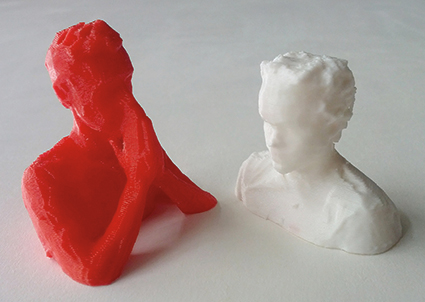
Cake Industries, (Jesse Stevens and Dean Paterson) Simulacrum (detail) 2014-2016, 3D modeled plastic portraits, installation, performance.
photo courtesy the artists
Cake Industries, (Jesse Stevens and Dean Paterson) Simulacrum (detail) 2014-2016, 3D modeled plastic portraits, installation, performance.
Having said that technology is still rapidly evolving. There is a new generation of technologies that, as they become more affordable, are being picked up by artists as the early adopters. Such examples in the Biennial include Cake Industries’ Simulacrum, a re-invention of classical portraiture through the use of 3D printing. So it’s not that the ‘new’ has completely disappeared from media arts, it’s simply that now we have a richer and more diverse range of tools and practices. I expect in the next few years we will see more artists using lightweight virtual reality headsets such as Oculus Rift that have been made for immersive gaming.
And perhaps a few spoilers…
In this year’s Biennial you see all of these forces at work. There are exhibits drawing on photography, sculpture and installation, electronic sculpture, sound art, robotics, live art, biotechnology, film and video. There are artists who have come from computer programming while others are from traditional art schools; artists engaged in gaming, who sit on the edges of current definitions of art, such as Christy Dena. Her interactive game Magister Ludi, was especially commissioned for the Biennial. TeamLab’s 100 Years Sea refreshes traditional Japanese screen painting through animation and explores the impact of rising sea levels predicted in 2009 by the World Wildlife Fund for Nature. Commenced in the same year, this animation will run for a period of 100 years. So media art now occupies both the mainstream and the edges of aesthetic practices engaged with technology. I hope the diversity of artists participating in this year’s Biennial is a reflection of the thriving and dynamic culture that is media art.
Featured on our cover this issue is the 24-year old Emirati artist Maitha Demithan. Demithan takes photographs of her family in everyday traditional dress and uses a small flatbed A4 scanner to fragment and recompose the images in order to digitally enhance them, especially the colours, as well as playing with two-dimensionality. She writes “the pose, body language and particular scan quality also include an emotional moment.” (sarasist.org). Demithan’s scenographies feature in RECHARGE: Experimenta 6th Biennal of Media Art.
Recharge, 6th International Biennial of Media Art, RMIT Gallery, Melbourne, 28 Nov, 2014-21 Feb, 2015; touring to 2016; http://experimenta.org/recharge/
RealTime issue #124 Dec-Jan 2014 pg. 5
© Darren Tofts; for permission to reproduce apply to realtime@realtimearts.net
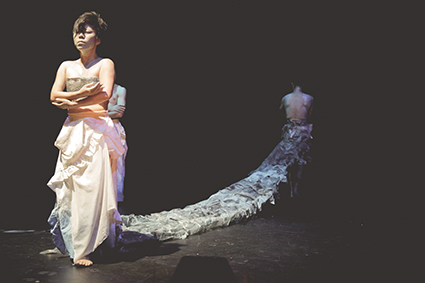
Deluge
photo Gery Davies
Deluge
MARTIN AMIS SAYS THAT EXPERIENCE IS THE CURRENCY OF OUR AGE AND THIS APPETITE FOR BIOGRAPHY AND LIVED EXPERIENCES WAS BORNE OUT ONSTAGE IN THE PROGRAMMING OF THE 2014 BRISBANE FESTIVAL. BUILT AROUND PHILLIP GLASS’ LATEST ‘PORTRAIT’ OPERA THE PERFECT AMERICAN, ABOUT WALT DISNEY, THE PROGRAM INCLUDED INTIMATE WORKS LIKE TODD MACDONALD’S HEART-WRENCHING ACCOUNT OF HIS DAUGHTER’S ILLNESS IN THE BUTTON EFFECT AT QTC AND THE ELLIPTICAL AND STATELY PHYSICAL THEATRE WORK ABOUT THE BRISBANE FLOODS, DELUGE, BY MOTHERBOARD PRODUCTIONS.
The Perfect American
This was outgoing Artistic Director Noel Staunton’s last hurrah and The Perfect American was a tour-de-force collaboration between local companies Opera Queensland, Queensland Symphony Orchestra, QPAC and Expressions Dance Theatre to bring the work commissioned by the English National Opera (ENO) with the impossibly stellar creative team of Glass composing, Phelim McDermott from Improbable Theatre directing and Dan Potra designing, for an exclusive Australian season in Brisbane.
The work retains most of the debut cast, with the thunderous bass baritone of Christopher Purves as Disney anchoring the opera, his voice soaring and vibrating in each of the 12 self-contained episodes that chart the final days of Disney and confabulate fact with fiction, action with hallucination.
The loose structure is held together largely by Don Potra’s design. A giant gantry looms over the stage with two vast revolving arms that spin constantly like a death star, releasing delicate paper screens filled with moving animations, monochromous and ominous, which flutter to the ground like burnt moths. Even the rectilinear aesthetic of Glass’s most celebrated visual collaborator, Robert Wilson, still holds to the 19th century aesthetic of stage backdrop. Potra brings the heavy industrialism of contemporary performance spectacle into opera with undeniable bravery. Indeed, while the work has met with mixed reviews in London and Madrid, Potra’s design has been praised. For a Brisbane audience, unaccustomed to regular debuts of this scale and calibre it was breathtaking to watch the singers and dancers duck and weave as the gantry spun and shed like a living image machine.
Below the gantry was a simple circular revolve, which signified train tracks, a hospital room, a film set and Disney’s office and home. This circularity was not just functional, but echoed Potra’s whirling gantry and was mirrored by Glass’ score, which, although built around his trademark minimalism was a pulsating, driving and addictive experience. Imagine the sound of an old fashioned train on a circular track, the click of castanets and the surge of horns with the sweetness of a classical chorus that somehow sounds like Lou Reed in 1979. The score is marked by sudden shifts, abrupt changes of instruments and long, heavy drone-like sequences. Indeed, the score was criticised overseas for not having more romantic and operatic sequences, like the opening and closing scenes set in Disney’s hometown of Marceline. However, this seemed to me to embody the politic of the work: the mid-Western, right wing America of Disney being simultaneously feted and exorcised by the liberal New York avante-garde; pop culture and high culture colliding in a sometimes uncomfortable mix.
The libretto had a similar mashing of almost bruisingly trite language and what Potra described as “restrained poetry.” “You were only a moderately successful CEO” sings Disney’s imagined nemesis, the disgruntled employee Dantine, an immigrant worker fired for attempting to start a union. “Everything belongs to me,” sings Disney plaintively as his life is slipping from his grasp. Sadly, despite these genuinely bold and arresting elements, The Perfect American did not lift into that total theatre experience that Glass is renowned for making with Wilson: you could feel the audience resisting journeying into the rabbit hole of meditative reception. Somehow it all existed too much in a literal world, filled with sad and agonised characters, the industrial ghosts of Disney’s pencil drawings. Neither fish nor flesh, the opera refused the lures of sentimentality and melodrama but also the pleasures of abstraction.
Deluge
What was both flesh and fish was Motherboard Production’s Deluge, born out of the agony of the floods in Brisbane in 2011 and the follow-up to the Brisbane Festival smash Underground. Motherboard is a vibrant local company, one of a handful that carry the Brisbane traditions of physical theatre, ensemble training and engagement with Asian theatre forms into the next generation. Deluge sits in that canon very clearly, with large-cast spectacle, slow durational form and a mix of Korean and Australian performers. The show opens with an elaborately casual tea ceremony, with performers in civvies handing the audience the warming beverage on a napkin printed with a Judith Wright poem translated into Korean. Who could ask for more?
While many looked bored, I relished the off-handed pageantry of graceful performers inviting their audience slowly into the dripping cave stage world of Deluge. The often cavernous Visy was shortened by an acoustic wall behind most of the seating bank, which gave Dane Alexander’s mesmerising score added power, particularly when it lifted into throbbing techno at key moments in the show. The work built slowly, as delicate glass containers were lifted into and then out of the space, clinking like seagull cries. Classic Suzuki motifs ensued, like slow walls of bodies moving forward. their tiny gestures charged with intensity. The stately bodies grew slowly more and more fevered, as the imagined water came closer; suddenly, an explosion, with bodies running across stage, hitting each other, falling and running again and the impending doom of the ticking clock. The whole stage was rent with green laser light and bodies rippled and drowned. The delicate set was swept away in the deluge till all that remained was the harsh and beautiful cement wall at the back of the theatre.
Time passed with a mournful traditional Korean song, then the show climaxed with the majestic arrival of Niedeck, the director/choreographer and central performer, slowly gliding into the theatre bare-chested with a train of rubbish behind him. A garbage water god, a symbol of wreckage and renewal all at once. There were long sequences that felt extraneous, or lacked tightness or unison—these physical performance forms are unforgiving, they demand such precision and simplicity—but the intensity of Deluge was undeniable, particularly in the final sections.
The Button Event
The Button Event is an intimate one-man piece about devisor and performer Todd MacDonald’s daughter Lola and her struggles with a rare and debilitating form of childhood epilepsy, Tuberous Sclerosis. However, it shares with Deluge a similar delicacy of form and requirement to navigate the work through the frame of personal experience.
The Button Event begins with an almost empty stage, a tennis ball machine and MacDonald reading us a letter he had written, just in case God existed, to thank Mary MacKillop for the novenas that had been offered up to her to try and help his daughter during the pivotal surgery that would eventually save her life. Indeed, this is the organising principle of the show, the before and afters of Lola’s illness—MacDonald’s life and work and marriage before Lola’s illness and then the chaos and struggle to survive after.
MacDonald is a consummate performer, he has that quality of likeability; you always wish him well and because the story is unashamedly personal, in many respects watching it is like hearing a story at a party from a friend. The various tasks undertaken onstage, many of them connected to the tennis balls, only underscore this sense of ordinary exchange, of being told a story over a garden fence. As Lola’s situation deteriorates and Todd’s anxiety rises the design becomes more and more complex: ladders and boxes and strings have to be arranged, the disclosures sail closer and closer to intimate confessions of weakness or despair. A children’s book is read about a grumpy turtle losing its temper and being abandoned. A sweeping train of tennis balls transforms into a whirling cape, the hunchback Richard in agony. There is such deftness in the choices made here by MacDonald and his director and co-deviser Bagryana Popov and designers Kevin O’Brien and Sam Paxton: the ubiquitous tennis ball, so ordinary, but also capable of such luminous beauty when arranged in constellation or when released from the ceiling to fall like redemptive rain.
I think my only sense of unease about the work came from this very success. The world presented was so relatable, so much ours that I did not question any of it—the authenticity of the personal account left no room to challenge or to even interpret. I suspect this is the danger of lived experience as theatre, that you impose on it the polite protocols of a dinner party exchange. Yet both The Perfect American and Deluge demonstrate some of the difficulties in the opposite approach, where confabulation or aestheticisation does not quite do justice to the experience of problematic genius or the ruinous transcendence of natural disaster.
–
2014 Brisbane Festival: The Perfect American, composer Phillip Glass, librettist Rudolph Wurlitzer, Concert Hall, QPAC, 15-20 Sept; Deluge, director Jeremy Neideck, sound Dane Alexander, designer Sarah Winter, producer Dave Sleswick/Motherboard Productions, devisor-performers Hoyoung Tak, Younghee Park, Youngho Kwon, Katrina Cornwell, Sammie Williams, Jeremy Neideck, Amy Wollstein, Visy Theatre, Brisbane Powerhouse,18-20 Sept; QTC, The Button Event, devisor Todd MacDonald with director Bagryana Popov, design Kevin O’Brien, Sam Paxton, lighting Ben Hughes, composer Guy Webster, QTC, Brisbane, 18-27 Sept
RealTime issue #124 Dec-Jan 2014 pg. 6
© Kathryn Kelly; for permission to reproduce apply to realtime@realtimearts.net
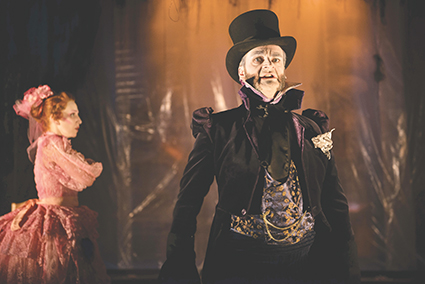
Helen Christinson and Hugh Parker, A Doll’s House
photo Dylan Evans
Helen Christinson and Hugh Parker, A Doll’s House
THERE CAN BE LITTLE DEBATING THE ASSERTION THAT AUSTRALIAN THEATRE IS CURRENTLY IN AN ADAPTO-MANIA BOOM CYCLE—ARGUABLY NOW JUST ON THE OTHER SIDE OF THE CREST OF A WAVE THAT PEAKED IN SYDNEY THIS YEAR WITH RALPH MYERS’ BELVOIR SEASON WHERE SEVEN OUT OF THE 11 SHOWS, BY MY RECKONING, WERE RESTAGED EUROPEAN CLASSICS OR ADAPTATIONS OF CANONICAL UR TEXTS.
The current surge in activity seems to have had its genesis in Melbourne’s independent theatre sector over the past decade or so, with the centre of gravity occurring at the Malthouse Theatre under Michael Kantor’s stewardship (2003-2010). Indeed, this year’s Brisbane Festival—Noel Staunton’s last—sees a new version of King Lear (The Shadow King) co-created and directed by Kantor. It is joined by Melbourne playwright Lally Katz’ new version of Ibsen’s A Doll’s House, and Melbourne-based indie company The Rabble’s reimagined stage version of Virginia Woolf’s novel Orlando. Interestingly, none of these three productions’ presenters use the word ‘adaptation’ in their programs or on festival websites. Indeed, in the case of The Shadow King neither Shakespeare nor Lear is mentioned at all; Katz’ text is named as a “new version” of the Ibsen original; and The Rabble’s take on Orlando is described as “a hallucinatory reworking of Virginia Woolf’s classic gender-bending parable.”
A Doll’s House
Of the three adaptions, in some ways Katz’ version of A Doll’s House is the most reverent to the parent text. The playwright’s voice is subtle—and Katz’ voice can quite literally intrude into the text of her plays. There are no overt attempts to Australianise the dialogue, for example, or to place the mise en scène in an idiosyncratic local setting. The most radical intervention the audience witnesses here is with Steven Mitchell Wright’s directorial signature, which sees Nora and the other characters (an excellent ensemble cast led by Helena Christenson as Nora, with Chris Beckey, Damien Cassidy, Cienda McNamara and Hugh Parker as Krogstad, Dr Rank, Kristine and Torvald, respectively) animated as clockwork dummies or music box figurines.
For all but the final moments of the three-act play, the actors avoid eye contact with each other and move in rigid, mechanical trajectories across the stage. We are invited to read the characters as wind-up toys trapped in the eponymous doll’s house that sees wives as properties of convention and their husbands’ estates and reputations. There was a risk the performative trope would become irritating over the play’s three hour running time, but in fact it worked well. The tension was meted out expertly and married beautifully to colour-coded period costume design (by Nathalie Ryner) and musical score (Dane Alexander) that combined to put me in mind of the Vulgarian palace scenes in the children’s film Chitty Chitty Bang Bang (and I say that as a good thing!). This was the most disciplined directorial hand I have seen from Wright. He did an excellent job to marry themes and aesthetics together in a rich, compelling interpretation of Katz’ text. As Nora peels herself out of period dress in the play’s famous climax, she transforms into the ‘modern woman’ before our eyes—having sung key moments of subtext that express her psychological entrapment up until now—and the famous door that slams shut on the institution of 19th century marriage re-echoes so loudly here that audience members around me actually screamed as Nora exited.
The Shadow King
Tom E Lewis and Michael Kantor localise Lear dramatically in The Shadow King, resituating the parent text so that it speaks directly to an Australian Aboriginal political constituency, alluding strongly to the fraught issue in Northern Australia of private Indigenous home ownership in communal lands. As in the original text, an ageing, ailing Lear (Lewis) is deciding to which of his three daughters he should leave his property. Firebrand Cordelia (Rarriwuy Hick) doesn’t want anything to do with the ‘blood money’—private ownership of community lands acquired through mining company royalties—so Lear gives the property to Goneral (Jada Alberts) and Regan (Natasha Wanganeen), whose greed and self-interest see them destroy each other. It is left for the Fool (Kamahi Djordon King) to announce at play’s end that “You can’t divide up the land…This land is you.”
It’s a daring, dynamic and delightfully aggressive reinterpretation of King Lear. The politics are raw and piercingly insightful. I could write a page on Paul Jackson, David Miller and Kantor’s set design—a gigantic earthmoving piece of mining equipment that converts into both elevated tropical houses and rusty prison cell. And Natasha Gadd, Rhys Graham and Murray Lui’s videography evokes such wonderful domestic detail of North Australian bush households—rusty fridges on the back patio, dirty eskies, wandering camp dogs. It was a brilliant night’s theatre for me on so many levels, and as close to a game changer in contemporary Indigenous theatrical collaboration and revisionism (of the European canon) as I can think of.
Orlando
The Rabble’s stage adaptation of Woolf’s most challenging of novels is another bold theatrical experiment, and one which reviewers in this magazine have lauded (see RT112, p15). It is a looser, more episodic reinterpretation of its European parent text than the other two plays discussed here. Woolf’s novel itself is, of course, a modernist experiment in structure and form and her spirit of radical gender play is honoured here.
Certain scenes were more theatrically compelling than others for me, with some stock post-dramatic techniques (the reading of lists as text, in this case synonyms for vaginas, for example) more effective for the audience member that hasn’t seen them rendered similarly elsewhere before. But the daring performances in this stark white, sterile set (Kate Davis designs) succeed in transporting us to the Great Frost of 1709 as effectively as to the anachronistic domestic interior of Orlando’s bored housefrau watching an electric jug boil. Its residence in the festival’s curated Theatre Republic ‘sideshow’ season was a fitting showcase for this interesting independent company’s introduction to Brisbane audiences.
A capital city’s arts festival is designed to bring the best of local, national and international work together and place it in regional conversation, and as a trifecta, these three stage adaptations are examples of best practice in many ways. But has the glut of adaptomania reached its zenith, and is it tipping into surfeit? Four out of six mainstage plays in La Boite incoming Artistic Director Chris Kohn’s inaugural 2015 season are restaged classics (of beloved children’s novels, Shakespeare and Euripides) so, in Brisbane at least, the Melbournesque surge continues for a while longer.
2014 Brisbane Festival: La Boite, A Doll’s House, writer Henrik Ibsen, new version by Lally Katz, director Steven Mitchell Wright, La Boite, Roundhouse Theatre, 6-27 Sept; Malthouse, The Shadow King, creators Michael Kantor, Tom E. Lewis, director Michael Kantor; Orlando, creators Emma Valente, Kate Davis, QUT The Loft, Brisbane, 16-20 Sept
RealTime issue #124 Dec-Jan 2014 pg. 8
© Stephen Carleton; for permission to reproduce apply to realtime@realtimearts.net
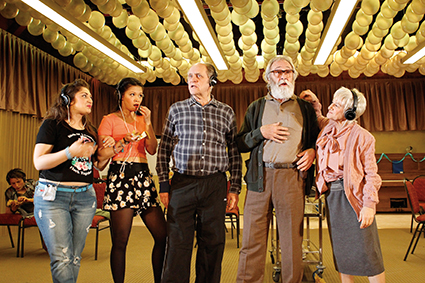
Roslyn Oades Hello, Goodbye and Happy Birthday
photo Jeff Busby
Roslyn Oades Hello, Goodbye and Happy Birthday
WE BORROW ON NERVOUS TERMS. EVEN BEYOND THE LEGAL AND MORAL IMPLICATIONS OF ARTISTIC QUOTATION, THE VERY UTILITY OR FUTILITY OF PASTICHE, HOMAGE, PARODY AND REVISION HAS BEEN ENDLESSLY DEBATED AND THE POLITICAL AND PHILOSOPHICAL COMPLEXITIES CONTINUE TO ANIMATE BRITTLE AND APPREHENSIVE DISCUSSIONS.
It’s the kind of situation that leads to the limp toing-and-froing about ‘adaptations versus originals’ that regularly crops up in Australia, or that causes brows to furrow when a work is described as ‘after’ so-and-so. It was hugely rewarding, then, to see a suite of new works at this year’s Melbourne Festival taking on the specific problem of translation between forms with great confidence and sophistication.
These included a poem transformed into a nightmarish multimedia landscape, audio documentary rendered as magnificent ‘verbatim theatre,’ a Shakespeare play as nomadic live art and true crime tale reimagined in a lyrical, almost musical manner.
The Trouble With Harry
The Trouble With Harry is the only one of these to even gesture to the problematic status of artistic debt, through the occasional moment that recognises the epistemological impossibility of ever faithfully recreating a ‘true’ story on stage. The work is inspired by the life of Harry Crawford, a woman whose life as a man in early 20th century Sydney included marriage and parenthood. She came to national attention after a murder that resulted in her eventual outing, and playwright Lachlan Philpott and director Alyson Campbell rightly acknowledge that there are questions that must be faced regarding their responsibilities in addressing such a complex subject. But, just as interestingly, they acknowledge that these are far from the only questions that deserve asking here.
The work is stylistically daring in subtle ways. It employs two narrators dressed in understated contemporary garb, as opposed to the diegetic characters in period costume. Dialogue and narration overlap and at times the lyrical language employed and the tight choreography of movement almost transform the work into a kind of music theatre. At odds with music theatre’s sense of grand community however is the oddly disconnected viewing experience of The Trouble With Harry where audience members are fitted with chunky headphones that afford them access to the intimate discussions of the folk on stage along with an accomplished sound design by Chris Wenn. It’s easy to lose the sense of being in a crowd, given these circumstances, and the work rather lends itself to a kind of voyeuristic sense that is all the more interesting given the events that unfold.
The Trouble With Harry never dips into sensationalism, though it does play with the way its subject was met with prurient or lurid fascination across history. The fear of being discovered forms the background to the piece, rarely made explicit but always simmering beneath scenes. The roles of Crawford’s children are a little overplayed in the way that most kid roles for adults often are, but the performances of Maude Davey as the titular Harry and Caroline Lee as his wife Annie are so finely detailed as to provide one of the most credible on stage relationships I can recall. The play itself doesn’t pathologise anyone involved—rather, there is a wealth that is unspoken here but gently conveyed by these two actors, allowing audiences only the briefest of access to the untold business that exists between lovers.
My Lover’s Bones
Brown Cab Productions’ My Lover’s Bones takes a more explicitly horrifying look at the vicissitudes of the heart. It follows an unnamed Aboriginal man’s quest to track and slay a bunyip in the hope it will win him his love, but the hunt itself becomes a metaphor for his own descent into obsessive madness. The monster may be in his head; this ‘lover’ may be a rapist and murderer; or perhaps he is the victim of a larger system that has entrapped him. If all of this sounds ambiguous, the production is not. It fuses a hard, physical and at times hypnotic performance by Kirk Page, thoughtful design including striking set pieces, well-executed projection and arresting sound design, and text that produces evocative imagery without detracting from the concrete aspects of the work.
At the performance’s end the person next to me sighed, “it was like a poem,” and this was exactly the thought I’d had myself. It’s some marker of success that the work is adapted from a poem by Cameron Costello, but is far more than a presentation of the original with some extra trimmings. Rather, it makes material the spirit of Costello’s text, which is an eerie fusion of Quandamooka legend and Poe-like gothicism. It’s a short, sharp and memorable work.
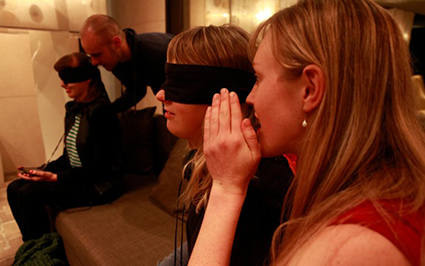
Since I Suppose
photo courtesy Melbourne International Arts Festival
Since I Suppose
Since I Suppose
I wouldn’t describe Since I Suppose as short nor sharp, but it certainly featured several sequences that left a lasting impression. Live art collective, one step at a time like this’ last work was en route, a city-roaming audio tour in which urban flanerie was complemented by fragments of spoken word drawing upon thinkers and poets as sources. It has travelled the world extensively and successfully, so it’s easy to see why the group has expanded upon the model with this new outing. It’s a two-to-three hour experience for two people traversing a city, mostly unaccompanied and directed by a mobile device that provides video and audio. Unlike en route, it injects the additional element of narrative.
In this case it’s Shakespeare’s notorious ‘problem play’ Measure for Measure. The original’s concerns afford a neat excuse to take participants to the seats of political and religious power as well as less salubrious sites of intrigue. There’s sometimes a sense of the ghost-hunt to it, as scenes from the past play out on the mobile screen in the same location as the participants now stand. There’s also the chance to put yourself in potentially uncomfortable situations, though it’s by no means a necessarily confronting work.
If it lacks something that en route had, it’s likely simply the aspect of novelty that can’t be repeated. Newcomers to the company’s work will probably find that here in spades. A politically problematic narrative is a tough replacement for the sense of wonder I found in the earlier work, however, and it was only after the work had ended that I felt it held together as a translation of Shakespeare’s play that conveyed both its story and internal tensions without being beholden to form or structure.
Hello, Goodbye and Happy Birthday
On paper, Roslyn Oades’ Hello, Goodbye and Happy Birthday might seem the least ambitious of these translations—even closer to mimicry than anything else. It consists of a style of practice she has been developing for some years in which audio interviews are played live in the ears of actors who then incarnate these speakers in real time (see The Power of Listening, Caroline Wake’s interview with Oades in our Women + Performance series, RT123, p33). So, impressions, basically? The result is anything but.
The raw material here is drawn from the words of a disparate group of 18-year-olds and people in their 80s or older. The sheer number of interview hours Oades must have conducted is staggering, given how much of this is rich with character and anecdotal originality. Then again, perhaps it is the constantly engaging energy produced when the live audio feed allows every stutter or hiccup or stumble or giggle to be rendered in a way that would seem artificial in regular theatre but has an absolute authenticity here.
Also key is the way the actors, whose ages must surely span at least 40 or more years themselves, are given the opportunity to play across generations as well as gender and race. Performers with greying hair produce impeccable portraits of awkward adolescents, while those barely out of their teens themselves seem perfectly cast as people whose bodies or minds are beginning to fade. That these are stories without a conventional sense of the dramatic to them doesn’t matter. They are infused with a terrific sense of life rarely felt in a theatre.
2014 Melbourne International Arts Festival: MKA Theatre of New Writing and Darebin Arts Speakeasy, The Trouble With Harry, writer Lachlan Philpott, director Alyson Campbell, design Eugyeene Teh, lighting Rob Sowinski, sound Chris Wenn, Northcote Town Hall, 17 Oct-9 Nov; Brown Cab Productions, My Lover’s Bones, producer John Harvey, design Alison Ross, lighting Lisa Mibus, composer, performer, projection Anna Liebzeit, choreographer, performer Kirk Page, choreographer Alexandra Harrison, video Ainsley Kerr, Footscray Community Arts Centre, 14-18 Oct; one step at a time like this, Since I Suppose, creators Suzanne Kersten, Clair Korobacz, Paul Moir, Julian Rickert, developed through Arts House CultureLAB, 15-26 Oct; Hello, Goodbye and Happy Birthday, director Roslyn Oades, movement Nat Cursio, sound Bob Scott, Russell Goldsmith, lighting Paul Jackson, design Christina Hayes, audio-script editing Roslyn Oades, script dramaturg Raimondo Cortese, Malthouse, Melbourne, 9-26 Oct
RealTime issue #124 Dec-Jan 2014 pg. 10-11
© John Bailey; for permission to reproduce apply to realtime@realtimearts.net
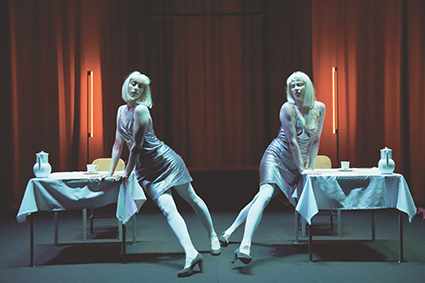
Mossoux-Bonte, The Coffee Drinkers
photo Laurent Philippe
Mossoux-Bonte, The Coffee Drinkers
IN THE LAST MOMENTS OF LINDA LUKE’S STILL POINT TURNING, LUKE, LIKE A PENDULUM FINALLY ARRESTED, HOLDS HERSELF MOTIONLESS BEFORE THE AUDIENCE. FOR WHAT SEEMS LIKES MINUTES SHE WATCHES US, SWEAT TRICKLING DOWN HER CHEEKS WHILE A TERMINALLY SLOWING HEARTBEAT FORESHADOWS THE INEVITABLE LIGHTS-OUT.
The closing work in Melbourne Festival’s curated dance season, Dance Territories, Still Point Turning’s end-point set up a reverberating final resonance within two double-bill programs that rippled and shimmered together in a remarkable interplay of difference and harmony, touching, as their titles suggest, upon the sacred, the profane, rituals and the notion of ‘now.’
Tony Yap, Yumi Umiumare and Matthew Gingold’s Zero Zero and Belgian company Mossoux-Bonté’s The Coffee Drinkers comprised Program One, The Sacred and the Profane. But while Zero Zero has its sacred elements and The Coffee Drinkers its profane, the pairing was anything but ‘one of each.’
In Zero Zero, Yap and Umiumare perform in apparent opposition, at either end of a long, white strip; by the end they are both lying on the floor, united, ‘sole to sole.’ They are each ‘channels’ of a kind: Yap seems to draw from the chthonic, at times uttering strained half-words or curled foetally on the floor, while Umiumare pays close attention to the everyday—a bowl of water, then a clock radio with chopping, changing stations. Yap’s dance strongly echoes traditional Asian forms; at one point he rises on the balls of his feet in a delicate, ritualised walk, hands tilted upward, watching his arms as pulses of life tremble through them. Sometimes he twists inhumanly, fingers spasmed. He seems to both absorb spiritual forces and control them, like a shaman both undergoing and understanding his possession.
Umiumare, in her quotidian world, seems fascinated by the radio blurting out its banal communications. She tilts her head like an animal, thinking but not-quite-thinking. She mimes cleaning her teeth; the gesture morphs into a controlled frenzy of shoulder-tensing, near-robotic movement. The feeling of ‘possession’ escalates—a possession by forces cultural, technological and other-worldly alike. In a sequence hinting at everything from butoh to ballet she moves like a crazed praying mantis, arms paddling the air; then caught in some invisible wind she begins to saw and flail, breaking into impossibly flowing flings, supplicant one second and dervish the next, ballerina and automaton at once. Throughout the piece, Matthew Gingold’s sound design unites the two dancers like a third body that breathes, gasps and sighs with them, incorporating natural and synthetic sounds from rippling water to tinnitis-inducing high tones or pummelling rumblings. Like the dance, the sound binds the profane and the sacred, which merge and are parsed by turns.
Like Zero Zero, Mossoux-Bonté’s The Coffee Drinkers (Belgium; concept, direction Patrick Bonté, choreography Nicole Mossoux and Patrick Bonté) evinces an uncanny leakage of the chthonic into the banal, though in a quite bizarre setting. Two (eventually three) identically dressed and bewigged women make, pour and consume their coffee at café tables, in gradually unravelling symmetry. To a part-melodic, part-robotic soundtrack befitting their doll-like characters, they pour, stir and sip, discarding pieces of clothing over time in exaggerated, burlesque moves, comically seductive. Their salacious routine increasingly hints at chaos—a serviette wipes a thick brown smear from an armpit, like menstrual discharge; coffee spills and spreads slowly on a table. As the piece evolves, a third dancer joins them, coming to life in a Frankenstein-like creation scene and initiated into the cloned world of the others. The narrative takes odd turnings: at one point the performers pose curiously in half-naked tableaux vivants redolent of cheap lesbian soft-porn, like three strange ‘Graces,’ or (who knows?) ‘Furies.’ Not only does The Coffee Drinkers conjure the ‘other side’—uncanny, dark, disruptive and sexual—it could also be read as either a feminism-inspired refusal of gendered stereotyping or a troubling conflation of woman/nature.
Opening Program Two, Rituals of Now, French choreographer Eléonore Didier’s Solides, Lisboa is an attempt “to stop dance” (program notes). It almost excruciatingly achieves its aim, creating a potent space for emotional affect. Once again ‘the everyday’ provides the work’s jumping-off point: Didier, attired in corporate skirt and jacket, like Mossoux-Bonté’s coffee drinkers, crawls and crab-walks around a bare stage to a soundtrack of city traffic and passing trams, seemingly trapped by her occupation. She appears to cope with the mundane through her deliberate movements; though at times, too, to be pushed and pulled by invisible hands.
In a second scene Didier moves around two props: a large table and a man, passive, who mostly sits at the table with his back to the audience. The light is bright. Didier is naked. She seems to try things out for their own sake: she slowly balls herself up on a chair, moves into a headstand, tilts her legs sideways to rest on the table, and suspends herself beneath it, gripping with hands and feet. Her face shows the stress of repeated attempt, but there’s a chasm between her emotiveness and her body, which she controls like an object, positioned seemingly without meaning. Eventually she places herself on the man’s lap. He gets up and walks as she clings to his upper torso until, unable to keep hanging on, she slides off.
Minimal and painfully paced, Didier’s choreography seems at times almost Dada; uninterpretable. And yet it intensifies something, creating a sequence of ‘stuck’ emotions in one’s own body which resist definition. Not an enjoyable work to watch, but it left a lingering ‘felt’ experience that became comprehensible as an emotional poetics of attempt, vulnerability, diligence and tenacity.
Finally, Linda Luke’s Still Point Turning: a series of collaged scenes, lyrical and strung together by suggestions of both mundane time and the grand cycles of life and death. Luke totters in rocky, uneven shoes like chunks of meteorite, cable-tied to her feet stepping back and forth mechanically to the sound of a voice reflecting on time and stillness. Her costume is part-Baroque and part steam-punk, coat tails and knickerbockers, elegantly ragged. A large pendulum swings back and forth across the stage, its continuity juxtaposed with Luke’s ever-changing movement. Over time, a rear screen delivers moving black bars, lushly opening buds and dying blooms or fuzzy, static ‘snow.’ Shoes discarded, Luke becomes freer, sometimes reminiscent of a curious insect, flower or animal. She turns her coattails out to become bright red petals. Frog-like sounds suggest primordial swamp and seem to subsume her; the pendulum continues to swing.
Ultimately Luke seems to be played by the sounds, natural and unnatural, ticking and spoken alike; she’s strangely expressionistic, jerking like a silent film character. Still Point Turning is theatrical, romantic, full of both play and decay—“for tomorrow we die”? It’s a lush response to the relentless tick of the clock and, equally, to the finite heart beating—the final minutes stunning, as Linda Luke watches us and sweats; reduced to one living body whose time is slowed right down to nil.
Melbourne International Arts Festival & Dancehouse, Dance Territories: The Sacred and the Profane: Zero, Zero, Yumi Umiumare, Tony Yap; Mossoux-Bonté, The Coffee Drinkers (Belgium), 14-15 Oct; Rituals of Now: Eléonore Didier (France), Solides, Lisboa; Linda Luke, Still Point Turning, choreographer, performer Linda Luke, composer Vic McEwan, video Martin Fox, lighting Clytie Smith, costume Justine Shih Pearson, Dancehouse, Melbourne, 17–18 October
RealTime issue #124 Dec-Jan 2014 pg. 12
© Urszula Dawkins; for permission to reproduce apply to realtime@realtimearts.net
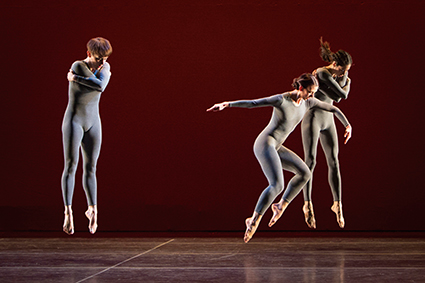
Trisha Brown Dance Company, Newark (Pure Dance Program)
photo Yi Chun Wu
Trisha Brown Dance Company, Newark (Pure Dance Program)
A FIELD OF DANCE, SUCH AS POSTMODERN DANCE, IS AN ECOSYSTEM. IT EXISTS IN THE EVERYDAY LIVES OF ITS DANCERS, IN THE BODY OF THE CHOREOGRAPHER, IN THE STUDIO SPACES IN WHICH IT IS ARTICULATED AND KEPT ALIVE, AND IN THE CULTURAL AND SOCIAL MILIEU IN WHICH IT THRIVES. IT IS NOT SOMETHING THAT CAN SIMPLY BE PRESERVED BY FIAT. THIS IS A DIFFERENCE BETWEEN DANCE AND THE VISUAL ARTS. DANCE STAYS ALIVE IN THE BODY OF THE DANCER. THIS MAKES THE HISTORICAL RECONSTRUCTION OF WORK A KIND OF PROBLEM, FOR THE DANCER AND FOR THE AUDIENCE, ESPECIALLY IF THERE HAS BEEN A BREAK IN THE CONTINUITY OF ITS TRANSMISSION.
The Trisha Brown Dance Company has been making and showing work since the 1970s. Although Brown has herself recently retired, the company continues to show work and maintain its repertoire. A certain lineage has been preserved from Brown, the choreographer, through her key dancers and towards the current company line-up. The question of transmission, from body to body, is a rich and complex process however. It’s not just a question of learning the steps. Something also changes in the passage of time. This was quite evident in the performance of Trisha Brown’s signature solo, Watermotor (1978). Although we must rely on archival footage of early performances by Brown, there was a looseness in her hips and a fluidity in her spine that was not so palpable in Neal Beasley’s dancing. Perhaps it was there but didn’t translate in the proscenium arch context of the Victorian Arts Centre, as distinct from its earlier studio incarnations. The performative intimacy of early postmodern dance fosters a greater kinaesthetic empathy on the part of the spectator.
Early Works
This was presumably why the company chose to show its Early Works program in the North Melbourne Meat Market. This was a good idea. There were no fixed seats. The audience was free to roam. We could stand close by, organise our own bodies in relation to the work and find our own solution to the shifting location of the pieces. Many of these short works were puzzles, calling for corporeal solutions. For example, a number of dances involved long sticks which formed an inflexible meeting point and contrast with the body’s softness and mobility. Dancers had to mould their bodies, maintain contact through the wood, balance and transport the sticks. They had to keep their bodies in play, utterly mobile according to the changing demands of the situation. One of the features of these stick dances was the possibility of failure; through loss of contact with the wood or dropping the stick. The visibility of failure, explicitly acknowledged by the performers, opened up a sense of the real time task of the dancing, of the task itself as producing a new kind of virtuosity and visibility. We see the thinking, the puzzle-solving decisions made in the flux of time, new modes of (kin)aesthetic value that emerged from this period of experimentation and innovation.
Pure Movement
The Pure Movement program, performed at the Victorian Arts Centre, was a different kind of animal: visceral, sensual, rhythmically complex, physically demanding though equally gratifying. The Melbourne audience loved these works and rightly so. The dancing was strong and soft in turns, requiring the force to raise a leg, yet also to achieve softness in the torso. The qualitative shift between muscularity and release requires a certain kind of virtuosity, one which can manage differences in the body in quick succession.
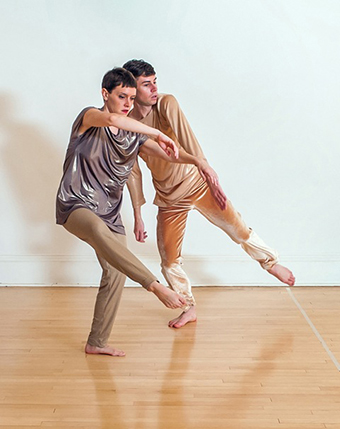
Trisha Brown Dance Company, Son of Gone Fishin’ (Pure Movement program)
photo Stephanie Berger
Trisha Brown Dance Company, Son of Gone Fishin’ (Pure Movement program)
Brown also has a distinctive way of crossing space, without any show of effort, eating space in the blink of an eye, yielding to fall with gravity, pick up the fall and reorient it. Son of Gone Fishin’ (1981) had all these qualities. The Grecian folds of its Lurex costumes harmonised with pulsating waves running through the spine. Brown seems to have worked out when to use strength and when to release, how to access muscles and bones so as to play with gravitational force, building on that to create movement sequences embodying a wide range of kinaesthetic qualities.
Her work is relationally complex, playing with time, space, rhythm and the group itself. She also works the perceptual gestalt of the whole space of the stage, including its edges. Newark (1987) implies movement on and offstage. Action is never fully contained within the space; it flickers on the edges, is initiated offstage, producing entrances already in full flight. Les Yeux et l’âme (2011) was surprisingly lyrical, a partner to Jean-Philippe Rameau’s mythic opera. Although romantic and flowing, its rolling, counter-balances, swings, falls and lifts gave an untimely inflexion to the Baroque tenor of the music. The collective transformations of the group produced a range of life forms, inhuman collectivities, at odds with the aristocratic social order of the time, yet somehow harmonious, working new aesthetic configurations out of the old.
Trisha Brown Company has been in existence for over 40 years. Brown has been making work throughout this period, experimenting, creating, collaborating and, above all, dancing. The transmission of her rich legacy is maintained by her key dancers, Carolyn Lucas and Dianne Madden (Associate Artistic Directors), who understand her work through their bodies. The Trisha Brown Company dancers are young. They hail from a different kinaesthetic milieu than existed when Brown created many of these works. This makes for a certain kind of shift in the quality of the dancing, inevitably so. Perhaps this is why theorist Peggy Phelan claims that performance is ephemeral. The performative nature of choreography means that what we see varies according to the dancers whose bodies are themselves the work of time and place. Yet the history of the body is that which gives depth to the work. Trisha Brown created history through finding new ways to elicit movement qualities, to play and produce, compose and deconstruct. It was a great pleasure to see, at last, so many works from such a significant and beautiful choreographer.
Melbourne International Arts Festival: Trisha Brown Dance Company, Trisha Brown, From All Angles: Early Works, North Melbourne Meat Market, 22, 26 Oct; Pure Movement, Melbourne Arts Centre, 23, 25, 26 Oct
RealTime issue #124 Dec-Jan 2014 pg. 14
© Philipa Rothfield; for permission to reproduce apply to realtime@realtimearts.net
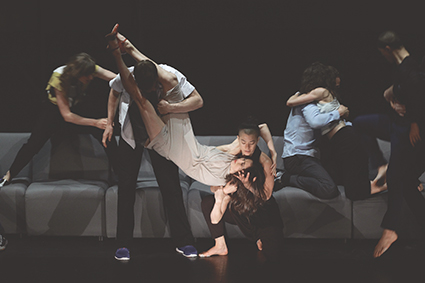
Chunky Move, Complexity Of Belonging
photo Jeff Busby
Chunky Move, Complexity Of Belonging
VISUAL AND CHOREOGRAPHIC WIT PLAY OFF AGAINST VERBAL EFFUSION IN THE COMPLEXITY OF BELONGING, A VISION OF FRUSTRATED INTIMACY IN A DIGITAL WORLD. THIS IS THE FIFTH COLLABORATION BETWEEN GERMAN PLAYWRIGHT AND DIRECTOR FALK RICHTER AND DUTCH CHOREOGRAPHER ANOUK VAN DIJK, ARTISTIC DIRECTOR OF CHUNKY MOVE.
A panoramic horizon of dappled grey clouds over outback scrub spans the back of the stage. Onstage are a blank billboard, cameras and microphones, a desk, whiteboard and a scattering of airport chairs. The ‘story’ begins in an international transit lounge, where daily allegiances and coordinates of identity are dissolved. A young woman (Eloise Mignon) observes in these conditions of globalisation a crisis of identity and intimacy. So she launches an investigation, propelling us through a storm of encounters among nine performers: these are enabled by mobile phones and Skype, often projected live onto the billboard. They are also interspersed with, accompanied by and sometimes embodied in, a volatile dance language.
Using their actual names, the five dancers and four actors perform a fiction woven together by Richter from personal stories they offered him. That we cannot trace these seams doesn’t matter; boundaries are fluid (actors dance and dancers act), in favour of a collective maelstrom, a mood of confession, restlessness and stress.
We see the struggles of a romance conducted long distance: its crisis peaks in a meltdown that is lost in a scrambled Skype connection. One dancer (Joel Bray) is probed about his Aboriginality and finds himself either falling short or feeling fake. Another two (and Tara Soh) reflect on their Asian-ness in Australia. And a same-sex couple (Josh Price and Joel Bray) meets all the milestones of romance by phone, leading to a parenting proposal that is delivered (with anxious tenderness) as a Power Point presentation.
There is a shadow to all this, of a zoo-like, United Colours of Benneton effect, of voyeurism or a sentimental notion of the global or urban tribe. But we are referred back to a profusion of particulars, often back to the body. “I need to feel your body,” someone bawls at their lover at one point on Skype. With sometimes grotesque intensity, the confessional rants propel themselves, building to shrillness, then are severed with a trivial quip and dropped, unresolved, into bathos.
Romantic themes recur above all (the question becoming, to whom do I belong?). Lauren Langlois’ monologue on the ‘perfect man’ shows the obscene demands we thrust on the single figure of partner-as-saviour-and-soulmate. As it crescendos, doll-like manipulations are enacted on her by another dancer, turning to drollery. These ironic, playful moments abound throughout. But the enveloping movement in the work as a whole reflects transience, with its temporary clusters that fracture and dissipate, the dancers breaking away as free fragments again and again. (The set and props undergo parallel treatment.)
These ailments of globalisation are in the end addressed with a level gaze, with a suggestion of freedom and reinvention prevailing over stress. And as for digital media, in all its stage presence it exudes paradox, as both a cause and a remedy, an uneasy medium for modern intimacy in itself.
Melbourne International Arts Festival: Melbourne Theatre Company and Chunky Move, Complexity of Belonging, script, direction Falk Richter, choreography, direction Anouk Van Dijk, Southbank Theatre, Melbourne, 6-25 Oct
RealTime issue #124 Dec-Jan 2014 pg. 16
© Jessica Sabatini; for permission to reproduce apply to realtime@realtimearts.net
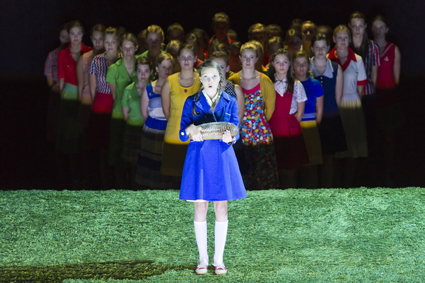
When the Mountain Changed Its Clothing, Heiner Goebbels, Melbourne International Arts Festival
photo Wonge Bergmann for the Ruhrtriennale.
When the Mountain Changed Its Clothing, Heiner Goebbels, Melbourne International Arts Festival
“WHAT DO LITTLE GIRLS DREAM OF?” “KNIVES, AND BLOOD,” INTONES CARMINA SLOVENICA, A SLOVENIAN CHOIR COMPRISING 40 YOUNG WOMEN AGED 10 TO 18, UNDER THE DIRECTION OF HEINER GOEBBELS.
This blend of innocence and darkness infuses all of When the Mountain Changed its Clothing, a work devised in 2012 that continues to tour the international festival circuit.
There are the vocal textures of the choir, so often in minor keys, droning, warping, sometimes with a hint of horror. Yet these sounds are generated by seeming ingénues in pastel 50s-style skirts and blouses, holding fluffy toys.
Then there is the set, with its square of bright, fake lawn centre-stage, backed by painted nature scenes successively unveiled throughout: a kind of three-dimensional storybook completed by tableaux vivants. But the texts delivered here (ranging from Adelbert Stifter to Ian McEwan to Gertrude Stein) are probing, absurdist dialogues, often interrogations as the choir crowds around a girl or two to examine mortality and lay bare the passage of time.
Despite their surreal and luminous look, many scenes have an earthy, old world feel. A girl visits a neighbour bearing a loaf of bread. Two others sit by a campfire with a small roast on a spit. Two others sit and sew while discussing poverty. At least, at a glance they seem to be sewing, with innate grace and efficiency. But in fact one is eviscerating her teddy bear and the other is bundling the white stuffing into clouds on strings, which they then drift across the lawn while the rest of the choir sings. The loss of innocence is implied in all of this. But so too is the role of youth as the voice of wisdom.
Still another facet of innocence shines in the exuberance of the girls’ physicality. They bustle round the stage like worker bees, rearranging the set between scenes. At one point all 40 gather on the lawn to chant and clap and yelp in vigorous syncopation; and they bring full-throated verve to choral works by Slovenian composers along with Brahms, Sarah Hopkins and Yugoslavian propagandists. Even when a chthonic chill hangs around the fake lawn, their vivacity remains intact. There is vitality, without naivety, in their dramatic presence.
They’re not ingénues after all, I think to myself in those moments. More like sibyls. Poised on the threshold of womanhood, as future mothers they stare beyond the threshold of death. Into history too: “Do you remember when your mother was a little girl?” they ask. This ‘tracking’ and flexing of represented time is the most haunting aspect of the work.
Visually, time’s changes trickle early in the piece, through costuming. Appearing first in contemporary dress, the ensemble gradually and seamlessly rolls back generations, with just a few performers changing at a time. In a group this size, there’s no way to notice individual changes. Instead we witness this mass effect as an unveiling of years, a slow emergence—wonder, an allusion to the title?
When the Mountain Changed its Clothing has no narrative or sense of linearity. Rather, its unfolding feels kaleidoscopic. And in its shifting scenes we watch the play of colour, light and darkness that is present in life’s mysteries and elemental changes.
Melbourne International Arts Festival, Heiner Goebbels and Vocal Theatre Carmina Slovenica, State Theatre, Arts Centre Melbourne, 23-26 Oct
RealTime issue #124 Dec-Jan 2014 pg. 16
© Jessica Sabatini; for permission to reproduce apply to realtime@realtimearts.net
IT’S BECOME INCREASINGLY COMMON TO CATCH BRAVURA PERFORMANCES DURING MELBOURNE FRINGE THAT ARE AS IMPRESSIVE AS ANYTHING ON OFFER ELSEWHERE DURING THE YEAR. THE REASONS FOR THIS MUST BE MANY, AND MIGHT INCLUDE INCREASING OPPORTUNITIES FOR TRAINING AND PRACTICAL EXPERIENCE FOR PERFORMERS AS WELL AS THE INTEREST SEASONED PROFESSIONALS HAVE IN USING THE FRINGE TO TEST OUT MORE EXPERIMENTAL IDEAS.
I think it’s also to do with an increased cultural literacy among performers, who are able to expose themselves to a breadth and depth of work throughout the year that may not have been available to previous generations.
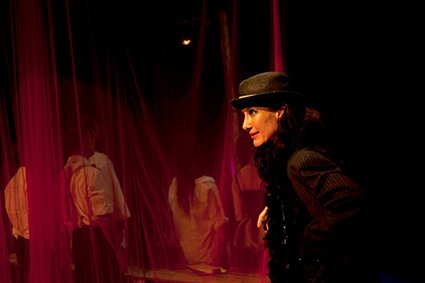
Maude Davey as Everyman, Everyman and the Pole Dancers, Auto Da Fe Theatre
photo Oscar Socias
Maude Davey as Everyman, Everyman and the Pole Dancers, Auto Da Fe Theatre
Everyman and the Pole Dancers
Auto Da Fe Theatre’s Everyman and the Pole Dancers was an example of the tensions between new and old. A confusing excess that highlighted the importance of a sorting principle in any attempt to process centuries of theatrical convention, its own kitchen-sink approach was also part of its anarchic pleasure.
Drawing on the Morality Plays of 15th century England, the work presents a gloriously grotesque family beset on all sides by a fiendish figure who variously assumes roles such as cop, sex worker, psychoanalyst, umpire and others. The family members themselves are just as labile, with mother deciding she is a gay man, grandpa at times apparently channelling a dog spirit, grandma romantically attached to a seven-year-old who also seems a kind of priest, and even the ashes of a deceased grandparent continuing to display the same abilities of reinvention as everyone else.
This carnivalesque spirit can be overwhelming, as is so often the case, and it is Maude Davey who provides almost the only anchor on offer here. Her performance confirms her as a national treasure, both assured and playful enough to allow the rest of the work to stray as much as it does.
Nick: An Accidental Hero
Another Fringe performance with a stellar impact was found in Renee Lyons’ solo show Nick: An Accidental Hero. A recent trend at Melbourne Fringe seems to be the annual inclusion of a solo work from New Zealand that is exquisitely crafted and performed and Lyons is an outstanding example. The work was created around the true story of Nick Chisholm, an Auckland man who suffered a stroke during a rugby match and became afflicted with locked-in syndrome. The narrative here follows the impact this has on a number of people in his life, including the recovering alcoholic who appoints himself carer and a woman from the other side of the world who begins a relationship with Nick over the internet.
Lyons’ accomplishments here are many. She produces uncannily detailed character work that is alternately hilarious and moving, and employs simple theatrical devices to convey urgent medical procedures, the passing of time and the changes in an entire community. She also manages to produce great sympathy for several characters who would essentially be reduced to boofhead roles in many works, but who are indeed central to this narrative. Nick himself is never bestowed with any heroic status, and in fact one of the boldest moves here is in Lyons’ choice never to actually incarnate the work’s central character until a brilliant coup-de-theatre in the production’s final seconds.
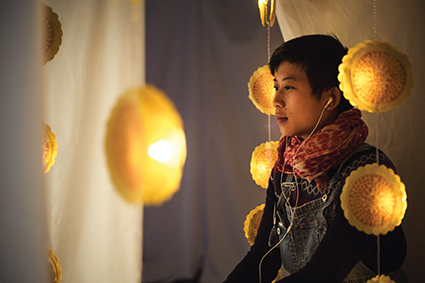
Chinese Whispers
photo Daniela Rodriguez
Chinese Whispers
Chinese Whispers
The live art work Chinese Whispers also featured a surprise ending that both complemented and went well beyond what preceded it. The bulk of the experience involves a single audience member navigating an installation of billowing white fabric studded at intervals with small vignettes. An accompanying audio track weaves together interviews with survivors of the May 1998 riots in Indonesia, during which ethnic tensions saw the mass rape and murder of many Chinese-Indonesians.
Creator Rani Pramesti’s audio work here is first-class, producing a provocative and heartbreaking tapestry with little unneeded editorialising. The initial presentation was marred by sound-bleed issues, and it’s the kind of overall production that could sorely use funding support to reach the level of excellence it could attain. Its ending, however, was a delight—exiting the maze, each traveller finds themself alone with a performer of ethnic Chinese-Indonesian descent surrounded by Indonesian snacks and treats and invited to partake. What followed, for me at least, was a chat about racism in both Indonesia and Australia that was unexpectedly illuminating and which provided both of its participants with a number of “wait, really???” moments.
Dr Professor Neal Portenza Performs his Own Autopsy Live on Stage…one night only (Obviously)
Such moments are also a starting point for the bizarro comedy of Josh Ladgrove’s alter ego Dr Professor Neal Portenza. Portenza fits somewhat into the already unstable category of art comedy that has swollen in the last decade in Australia and includes performers such as post’s Zoe Coombs-Marr and the former members of Pig Island. Ladgrove’s is a unique entry in the class, bringing a deconstructed type of clowning to the mix and working less with ideas of anti-comedy, deliberate failure and flatness and more with audience dynamics to provide the punchlines.
His Dr Professor Neal Portenza Performs his Own Autopsy Live On Stage… is a masterclass in the form. Its rough structure is a short series of acts he will attempt, but these are merely a hook upon which to hang astonishingly quick-witted moments of audience engagement that build and build until the crowd itself feels emboldened enough to get in on the act. Ladgrove handles his audience so deftly that he is able to dress one member as the good Dr Professor and have them ad lib their own unscripted comedy. On the occasion I visited, this random punter’s routine was as funny as the ‘real’ show that framed it. It’s one thing to produce your own bravura performance, but to evoke one from an onlooker is a kind of magic.
Melbourne Fringe Festival: Auto Da Fe Theatre/Shinjuku Ryozanpaku, Everyman and the Pole Dancers, writer, director Lech Mackiewicz, Installation Naomi Ota, Mechanics Institute, 1-11 Oct; Nick: An Accidental Hero, creator, performer Renee Lyons, Arts House, North Melbourne Town Hall, 19-26 Sept; Chinese Whispers, creator Rani Pramesti, design Shane Thompson, Bluestone Church Arts Space 3, 23-28 Sept; Dr Professor Neal Portenza Performs his Own Autopsy Live on Stage. One Night Only. (Obviously), creator-performer Josh Ladgrove, Tuxedo Cat, Melbourne, 22-8 Sept
RealTime issue #124 Dec-Jan 2014 pg. 18
© John Bailey; for permission to reproduce apply to realtime@realtimearts.net
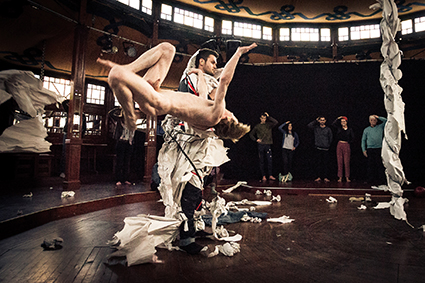
Snow, performer Skye Gellmann
photo Vincent van Berkel
Snow, performer Skye Gellmann
A GLIMPSE OF THREE OF THE MORE CROSS-ARTFORM SHOWS AT THIS YEAR’S MELBOURNE FRINGE REVEALED BOTH CHALLENGES AND SUCCESSES IN MERGING GENRES AND TECHNOLOGIES, IMMERSING AUDIENCES AND ATTAINING COHERENCE AT THE EDGES OF CONVENTIONAL DRAMATURGY. OSTENSIBLY DEALING WITH SNOW, FIRE AND SOMETHING CALLED THE “CHRONO-SYNCLASTIC INFUNDIBULUM,” ALL EXPLORED TO DIFFERENT DEGREES THE INTERPLAY OF HUMAN SENSES AND THE AGENCY OF BOTH PERFORMERS AND AUDIENCE.
Infundibular
At the high-tech end, the collaborative work Infundibular brought together three dancers with a team of creators including interactive media artist Mark Pedersen, and a curious inflatable set by Stanislav Roudavski. Developed as a series of scenes during a Fringe residency at Dancehouse, Infundibular, according to Pedersen, was loosely ‘retrofitted’ to the narrative of Kurt Vonnegut’s 1959 sci-fi novel The Sirens of Titan. The work moves from an Earth in revolutionary chaos to the imposed control of a Martian Army; explores symbiotic harmony on Mercury; and ultimately plunges into the all-encompassing world of the “infundibulum,” where time, space and destiny mysteriously coalesce.
At the core of Infundibular is Pedersen’s interactive design, a system in which the movement of dancers triggers light or sound, which in turn the dancers respond to, creating human-technological feedback loops (for more on the technology see RealTime’s review of SoundLabyrinth at ISEA 2013: www.realtimearts.net/feature/ISEA2013/11176). Strong image-and-sound impressions are formed on Earth when a dancer attempts to escape an invisible circle, her movements synaesthetically ‘becoming’ the roar of a rioting crowd; and on Mars when advancing dancers are repelled by harsh, audience-triggered static.
Most successful is the Mercury scene, in which a solo dancer attracts diamond-shaped scraps of light on the floor around her—like Vonnegut’s vibration-attracted beings, called “harmoniums” in the novel. As the dancer moves, the lights follow her like sharp, bright creatures, multiplying as the dance progresses, until finally she backs away and leaves them, a swimming gathering of life left behind on the floor.
The infundibulum itself is a giant, translucent worm, inflating slowly for the final scene, like billowing cloud. Once it’s fully inflated, the dancers are able to play inside and outside of it amid shifting light and darkness; it’s an extended, elating moment in which the physical interaction of bodies with the skin of the worm, the light and the moving air become primary. If only we as audience could play too.
Symphony of Strange
Gareth Hart’s Symphony of Strange took a low-tech approach to body/sound interaction, fusing Hart’s improvised choreography with the clamour, song, crunch and howl of some 50 “non-musical instruments,” played by five musicians. Hart’s intention was, he says, “to create an immersive experience that teetered between the decrepit and the delicate.” The result feels subtly synaesthetic, as sounds like crumbling leaves, tearing fabric, escaping air, drummed gas bottles or a scraping hacksaw seem to both set his body into trembling, recoiling or flailing motion, or to be triggered by the motion itself.
Yet Symphony of Strange doesn’t feel like flowing fusion so much as a ritual of sorts. The cavernous Substation venue, lit peripherally by tea-light candles, is set up with ‘stations’ where different interactions take place—a circle of leaves and twigs; an altar-like central platform; and the “junkyard orchestra” at one end of the space—with the audience free to move from station to station. Composer Edward Willoughby’s jagged layering of sounds evokes the arrhythmic patterning of everyday life, feeling strangely ‘natural’ despite the plastic, metal and glass of many of the ‘instruments.’ At one point, well into the work, the musicians smash light globes into a box, the sound of glass shards shifting the mood suddenly into one of beautiful destruction. On the night I attend, a strong wind brilliantly augments the ‘orchestra,’ adding the metallic clamour of the roof iron to the cacophony of human-played instruments.
Snow—a quiet circus
Skye Gellmann is building a reputation with his stripped-back, participatory circus shows—his previous work Blindside (with Kieran Law) had audience members fumbling in the dark with smartphones, seeking out sounds in gloomy corners in between watching Chinese pole tricks. His new work, Snow—a quiet circus, eschews technology in favour of large quantities of butchers’ paper, more pole tricks and, for much of the show, silence. The audience wears earplugs; not to suppress a loud soundtrack (nor the slash of metal-guitar from the nearby rock venue), but because, as Gellmann tells us at the start, if we pause first and adjust to the silence “the ringing in your ears becomes the soundtrack.”
Snow proceeds with a mix of audience games and circus tricks, focused around a central pole covered in taped layers of paper that are torn down over time. Gellmann, ever keen to get his gear off, it seems, performs naked for much of the show, as in Blindside—though what draws our gaze is his physical power and control, especially in managing to perform on the paper-clad pole, with that inkling of ‘calm fear’ in his focus. In one entrancing sequence, Gellmann repeatedly pirouettes and slips from a rolling ball. A moving Grecian statue, all torque and form and marble skin, he displays playfulness, virtuosity, attempt and failure all at once. From the ‘live-art’ participatory perspective, Snow’s high point is the ‘snowball fight’ that Gellmann orchestrates: the audience balls up paper into rounded clumps and goes for it with the abandon of several dozen primary school kids let loose in their thermals and mittens. Faint giggles, ripping paper and the thud of feet on the polished floor seep through the earplugs.
Infundibular, Snow and Symphony of Strange are all ambitious in their merging of technologies and artforms, opening up sensual, cross-genre and synaesthetic territories that firmly invite further exploration. All three shows might have been stronger with concentrated direction (none credits a director, as such); as an audience member there were moments of wanting to be more involved, or feeling involved but somehow distant, ‘invited in’ and yet still separate. It will be great to see how these artform and body/tech crossings crystallise, either in further iterations of these shows or in the future works by these creators.
2014 Melbourne Fringe Festival: Infundibular, choreography Rachael Heller-Wagner, Ashlee Bye, Moriya Rosenberg, interaction design Mark Pedersen, music Jess Keefe, Camille Robinson, Roger Alsop, visual projection Travis Cox; Dancehouse, 25-28 Sept; Gareth Hart, Symphony of Strange, choreographer, performer Gareth Hart, composer, performer Edward Willoughby, performers Alex Elbery, Alex Gates, Justine Walsh, Stephen Weir; The Substation, 30 Sept-4 Oct;Skye Gellmann, Snow—a quiet circus, artist Skye Gellman; The Melba Spiegeltent, Melbourne, 1–5 October
RealTime issue #124 Dec-Jan 2014 pg. 19
© Urszula Dawkins; for permission to reproduce apply to realtime@realtimearts.net
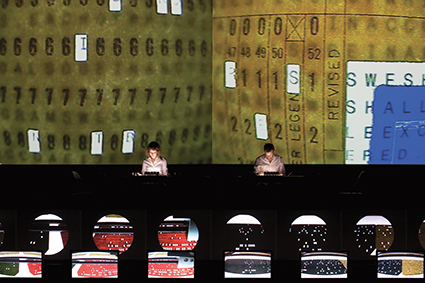
Ryoji Ikeda, Superposition, courtesy Kyoto Experiment
Kazuo Fukunaga
Ryoji Ikeda, Superposition, courtesy Kyoto Experiment
Great to see media art playing centrestage on its own terms and in a host of interdisciplinary manifestations in exhibitions and festivals across Australia.
Already underway and showing until 22 Feb is Experimenta’s Recharge, an opportunity to re-estimate your relationship with media art at Melbourne’s RMIT before the biennial show goes on tour 2015-16, admission free. Artistic director Jonathan Parsons tells Darren Tofts that gaming, 3D-printed sculpture and animation—including a rising sea levels work from Japan, aptly designed to run for 100 years—are just a few of the attractions.
Adelaide Festival’s Blinc features free access to 22 international media artworks on the banks of the River Torrens, ranging from intimate interactives to large-scale wonders. As well, there’s a three-venue showing of major works by Bill Viola, who’ll be in town for the festival.
Sydney Festival’s Sound/Unsound program includes Mira Calix’s Inside There Falls in which you enter an immersive world of paper, text, voice and dance (again, free). Also in the festival program is media artist Lynette Wallworth’s collaboration with French organist Bernard Froccoulle, Darkness and Light, and WA company The Last Great Hunt’s Falling Through Clouds (reviewed in this edition), a synthesis of puppetry, animation, music and live video.
Now open and playing to 1 March is QUT Art Museum’s Performance Now, 20 intriguing videos featuring prominent artists and curated by a leading expert on performance art, New Yorker RoseLee Goldberg. The videos aren’t simply documentation; they reveal visual and performance artists inventively engaging with the camera. Only showing in Brisbane, Performance Now will be an obligatory holiday hotspot for performers, artists and lovers of the provocative and the ineffable.
Carriageworks’ 2015 program includes the welcome return of Ryoji Ikeda, this time with a 90-minute large screen work mixed live by two performers, and 24 Frames per Second, a three-month exhibition of commissioned screen works focused around dance and surprising cross-artform collaborations.
Thanks to our readers, writers and clients for your wonderful support in 2015. Have a great art time over the summer. But to our friends at the ABC, including those who produce New Music Up Late, you are victims of ideological assault. We send our condolences. Artists will need to be brave in 2015.
RealTime issue #124 Dec-Jan 2014 pg. 3
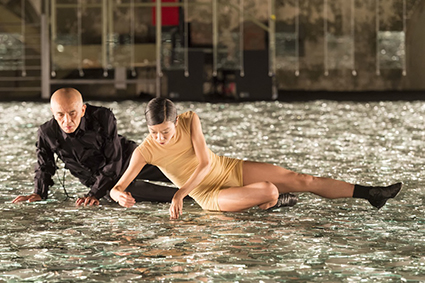
Saburo Teshigawara, Rihoko Sato, Broken Lights
photo Wonge Bergmann
Saburo Teshigawara, Rihoko Sato, Broken Lights
CARRIAGEWORKS GROWS AND GROWS, VERY EFFECTIVELY INHABITING THE ADDITIONAL SPACE IT’S BOLDLY TAKEN ON AND ENLARGING ITS PROGRAM ANNUALLY INTO WHAT INCREASINGLY FEELS LIKE A YEAR-ROUND CONTEMPORARY ARTS FESTIVAL. ABOVE ALL, THROUGH ITS OWN INITIATIVES AND THOSE CO-INSTIGATED WITH AN EXPANDING NUMBER OF PARTNERS, ITS PROGRAM IS UNDERPINNED BY LONG-TERM CREATIVE DEVELOPMENT, NURTURING NEW WORKS AND EXHIBITIONS ACROSS TWO TO THREE YEARS FOR FUTURE ANNUAL PROGRAMS. AN OTHERWISE EXUBERANT LISA HAVILAH, GUIDING ME THROUGH HER FOURTH PROGRAM, MODESTLY DECLARES, “I THINK WE’RE GETTING MORE GROWN UP AS WE GO ALONG. MATURING SLOWLY.”
24 Frames per Second
Central to the year is a program of screen-based works “at the nexus of dance, film and visual arts” by 18 Australian and six overseas artists. Principally supported by the Australia Council it’s titled 24 Frames per Second and has been three years in the making. The list of participants represents a striking cross-section of adventurous Australian art making: Tony Albert and Stephen Page, Alison Currie, Nat Cursio and Daniel Crooks, Brian Fuata, Antony Hamilton and Byron Perry, Vicki Van Hout, Sophie Hyde and Restless Dance Theatre, Angelica Mesiti, Kate Murphy, James Newitt, David Rosetzky, S Shakthidharan, Aimee Smith, Latai Taumoepeau, Christian Thompson, Lizzie Thomson, Branch Nebula (Lee Wilson and Mirabelle Wouters) and Khaled Sabsabi. The international artists are Siobhan Davies and David Hinton (UK), François Chaignaud (France), Ho Tzu Nyen (Singapore), Sriwhana Spong (NZ) and leading international choreographer Saburo Teshigawara (Japan).
Havilah tells me, “The screen-based work we’ve commissioned from Teshigawara is based on Broken Lights, the work he presented at the 2014 Ruhrtriennale” for which he made a large shallow internally lit box full of broken glass on which the dancer performs with the choreographer’s trademark ecstatic slowness.
Havilah is emphatic, “24 Frames per Second is delivering the Australia Council [$300,000] Screen Dance Initiative. I hope that it really talks about all that’s happening (in dance on screen) which has changed so much. I hope this program will challenge some of those who see visual arts as co-opting dance” (see “Was there dancing?” RT123, p29). 24 Frames per Second will also feature live performances at the opening of the show which will be exhibited over three months and doubtless attract a large audience well beyond dance fanciers and visual arts lovers.
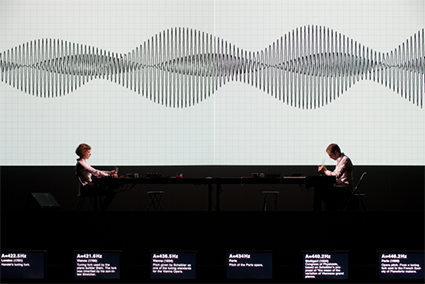
Superposition, Ryoji Ikeda
photo: Kazuo Fukunaga, courtesy: Kyoto Experiment
Superposition, Ryoji Ikeda
Ryoji Ikeda
“We’re really excited,” says Havilah, “to be bringing Ryoji Ikeda back for his first-ever live performance, Superposition (see p3), an Australian premiere in partnership with Adelaide’s OzAsia festival. You’ll enter a one and a half hour live performance in the huge Bay 17 with two performers onstage who do the live video mixing for, I think, about 40 screens with text, sound and Ryoji Ikeda ‘things.’ That’s in September.” Carriageworks presented Ikeda’s datamatics [ver 2.0] as part of ISEA2013 (go to ISEA2013 on the Features pages of www.realtimearts.net) drawing a huge audience onto the magnificent projected grid that mutated magically beneath their feet.
Ho Tzu Nyen, Ten Thousand Tigers
“We’ve partnered with The Esplanade in Singapore, the Asian Art Centre in Guangzhou and Vienna’s Wiener Festwochen,” says Havilah, “to bring this amazing new work, Ten Thousand Tigers, by Singaporean artist Ho Tzu Nyen to Australia. He’s created large-scale video works for the Venice Biennale and has also been in the Auckland Triennale, but this is a one-hour live work with performers, many screens and objects. “An ensemble of automated objects come to life and recount the tale of the Malayan Tiger’s numerous deaths and returns across a thousand years” (press release).
Zhang Huan, Sydney Buddha
Further connecting us with Asian culture, Carriageworks begins the year with Sydney Buddha, a work by Chinese artist Zhang Huan showing as part of the 2015 Sydney Festival. “It’s been shown in only three other places around the world,” says Havilah, “and continues our commitment to mounting large-scale visual art works. In the past we’ve hosted Brook Andrew, Song Dong and Christian Boltanski. Zhang Huan hasn’t had a major installation like this in Sydney. He just had a big survey show at Storm King Art Centre in the US, which was incredible.”
Michael Tuffery & The Royal Samoan Police Band
This new work, Siamani Samoa, is by Michael Tuffery a New Zealand-based printmaker, painter and sculptor of Samoan, Rarotongan and Tahitian heritage whom Havilah had worked with at Campbelltown Arts Centre. The work continues her commitment to bringing the art of the South Pacific to Australia, as she has done with the three productions of dance works by Lemi Ponifasio’s Mau over as many years. “Tuffery is collaborating with the Royal Samoan Police Band who we’re bringing to Sydney on their first-ever international tour. The work will be a fully immersive projection installation work in Bay 17 and includes a series of four live performances by the band. ‘Siamani’ means ‘German’ and it’s about the centenary of the end of the German occupation of Samoa. Every day the police band marches down the main street of Apia playing traditional German music—so the German influence is still very strong. In Samoa it’s a very positive story of colonisation.”
Carriageworks residents
One of Carriageworks’ great strengths is its resident organisations—Performance Space, Erth, Force Majeure, Marrugeku and Stalker—now joined by Sydney Chamber Opera, Felix Media and the Aboriginal theatre company Moogahlin Performing Arts. Havilah says, “There’s more and more collaboration between Carriageworks and the resident companies in terms of commissioning new work and co-investing in major works, which you’ll see throughout the 2015 program. The amazing Sydney Chamber Opera will present with us the world premiere of an opera by composer Elliott Gyger and librettist Pierce Wilcox based on David Malouf’s classic novel Fly Away Peter, with Imara Savage directing.”
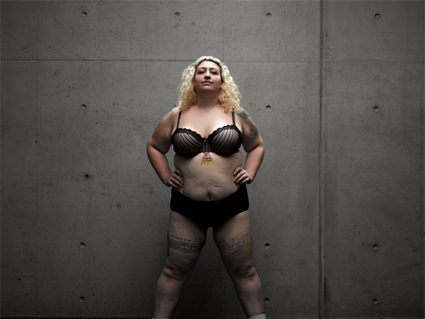
Force Majeure, Nothing to Lose
photo Toby Burrows
Force Majeure, Nothing to Lose
Force Majeure, Nothing to Lose
Havilah is proud to have co-commissioned with Sydney Festival Nothing to Lose, the final work for Force Majeure by artistic director Kate Champion. “We’ve been supporting this work through all of its development right up to presentation. I think it will be a festival highlight.” In a society preoccupied with ideal body shape, anorexia and obesity, there’s little room for a nuanced response to the stereotyping of ‘fat’ bodies as obese and ugly. Champion has collaborated with artist and “fat activist” Kelli Jean Drinkwater “to celebrate the sculptural splendour of the large dancing body.”
Performance Space
Carriageworks’ partnership with Performance Space continues with the co-commissioning of a Jonathan Jones installation and presentation of the performance event Day for Night in collaboration with the Gay and Lesbian Mardi Gras. “The first one last year was very successful. A new range of artists will be in the 2015 incarnation—Matthew Day, White Drummer Nell, Emma May, Técha Noble from the Kingpins and Bhenji Ra—curated by Jeff Khan and Emma Price.” Performance Space will soon launch its own 2015 program (see RT125).
Faithful to Redfern
With Redfern still a hub for Aboriginal culture, despite impinging development, Havilah is resolute: “We’ve tried to stay as true as possible to the whole vision that we started with in terms of reflecting the social and cultural demographic of the place in which we’re located, Redfern. We’re investing more in our Aboriginal arts strategy and in new contemporary Indigenous work. With Moogahlin we’ll present the second Yellamundie National Aboriginal Playwriting Festival, continue our three-year relationship with NAISDA and present Stephen Page’s re-imagining of Ochres (1995) for Bangarra on the work’s 21st anniversary as well as Jonathan Jones’ new installation. This will be the first time we’ve worked with Bangarra. Each year we sponsor an Aboriginal artist at our Park Road Studios in Alexandria. This year it’s dancer Ghenoa Gela. And next year it will be Microwave Jenny and the year after, Tony Albert.”
New Music
Louis Garrick, formerly of Sydney Chamber Opera, is Carriageworks’ new music curator. Havilah says, “He’s established a relationship with Brisbane-based Lawrence English’s Room 40. For their 15th anniversary, we’ll be presenting Open Frame, a two-day program” featuring potent composer-musician-visual artists Grouper (Liz Harris & Paul Clipson,(US) and William Basinski (US) plus fellow looper and installation artist Austin Bucket (AUS).
Branch Nebula, Wade Marynowsky, Xavier le Roy
Havilah is pleased that Artwork commissioned by Carriageworks for Sydney performance company Branch Nebula is coming to fruition: “This is a really experimental work, employing people who have never been onstage before performing a series of tasks directed by Branch Nebula. There’s also the premiere of Prehistoric Aquarium, a new work from Erth and of Wade Marynowsky’s Robot Opera, which has been developed with Branch Nebula from the artist’s Nostalgia for Obsolete Futures. As well Carriageworks will have its first collaboration with Kaldor Public Art Projects, presenting French choreographer Xavier Le Roy’s Self Unfinished.”
In-Development 2015-16
Carriageworks’ In-Development 2015-16 program includes commissions for a major work by American artist Nick Cave, a dance work with Kristina Chan, composer James Brown and designer Clare Britton; a project about the history of the Redfern Block [for 2017] with commissioned artists Vernon Ah Kee, Kev Carmody, Romaine Moreton and Warwick Thornton; and we’re partnering Marrugeku’s Cut the Sky and supporting Milk Crate Theatre on the creation of a new work. We’re also a partner in the new Art and the Moving Image Commission, between Adelaide Film Festival, Samstag Museum and University of Western Australia with the first new media work [currently being filmed in Iran] by Hossein Valamanesh. The producer is Brigid Ikin of Felix Media, one of our new resident companies.”
Disability Arts Strategy
We conclude our meeting with Havilah telling me about the importance of Carriageworks’ Disability Arts Strategy coming into play in 2015: “We have a mission to commission 10 new works over five years from the Disability Arts sector. The first will be a new piece by Rosie Dennis called A Simple Infinity and then Phillip Channels from Dance Integrated Australia will create a new work with Force Majeure. It’s about having a structured program that provides pathways for artists with a disability into contemporary practice.”
Carriageworks has radically increased its audiences over several years and staged commercial events (Fashion Week, Sydney Contemporary) which financially benefit the overall program while not being culturally removed from the organisation’s ethos. It feels that maturation is coming fast, underpinned by a cogent vision, partnerships and collaborations that address a wide spectrum of contemporary art practices and, not least, needs—for artists and audiences who deserve the best. All praise to Lisa Havilah and her dedicated staff.
RealTime issue #124 Dec-Jan 2014 pg. 21
© Keith Gallasch; for permission to reproduce apply to realtime@realtimearts.net
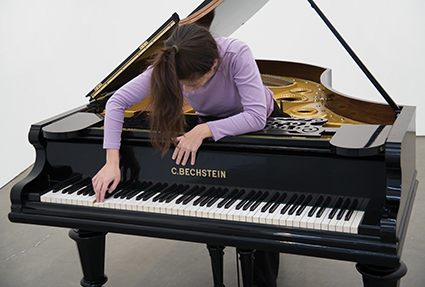
Allora & Calzadilla, Stop, Repair, Prepare: Variations on Ode to Joy, No.1 2008, modified Bechstein, installation View: Gladstone Gallery, New York
David Regen © Allora & Calzadilla, courtesy Gladstone Gallery, New York and Brussels
Allora & Calzadilla, Stop, Repair, Prepare: Variations on Ode to Joy, No.1 2008, modified Bechstein, installation View: Gladstone Gallery, New York
NO BREEZING THROUGH THIS SHOW. YOU’LL NEED HOURS, MAYBE DAYS. IN PERFORMANCE NOW, A COLLECTION OF SIGNIFICANT WORKS WILL BE SIMULTANEOUSLY EXHIBITED ON SCREEN IN THE MUSEUM. THEY COMPRISE VARIOUSLY BRISK, EPISODIC AND DURATIONAL CREATIONS—SERIOUS, WITTY AND PROVOCATIVE—BY PERFORMANCE ARTISTS, VISUAL ARTISTS WITH AN INCLINATION TO PERFORM (OR HAVE OTHERS DO IT FOR THEM) AND FILM, VIDEO, THEATRE AND DANCE MAKERS, EXPANDING OUR SENSE OF WHAT COMPRISES PERFORMANCE TODAY.
While some films and videos document significant performance art works, others are stand-alone exemplars of inventive interplay between performance and video art/filmmaking. Most have been made since 2000. The show is co-organized by Independent Curators International, New York, and Performa, the influential biennial of performance art organized by performance art scholar and curator RoseLee Goldberg. Goldberg, author of Performance Art: From Futurism to the Present (1979) is a former director of the Royal College of Art (RCA) Gallery in London, curator at The Kitchen in New York and teaches at New York University. Performance Now is the logical extension of her many years of staging exhibitions and symposia and encouraging extensive archiving. Above all, this widely travelled show is evidence of growing interest in performance art and in new kinds of art performance that overlap with a diversity of live art practices.
Performance Art itself made a comeback in the 2000s, with Marina Abramovic centrestage, training a new generation of artists and wielding commercial clout. A limited edition video of her 1977 work Imponderabilia, with partner Ulay, sold to galleries and private collectors for 180,000 euros a copy at the 2012 Art Basel. Gallerist Sean Kelly promotionally re-staged the work at the narrow entrance to his booth, requiring those entering to squeeze, as in the original, between two still, naked performers.
In Sydney in 2013 The Kaldor Project’s 13 Rooms (RT115, p5-7) excited the public imagination and angered others who felt performance art had been turned into a sideshow with live art entertainments and overly managed durational works. In the same year, Mike Parr in Daydream Island kept his body and its tortured durability centrestage but added a surprising theatricality (RT120, p5). Performance art is mutating—Parr was an early venturer in transmitting his work Malevich online in real time from Artspace where he was performing in 2002 (RT52, p28).
Just where the internet will take performance art has yet to be seen, but it will doubtless be partly judged in the same terms that screen documentation used to be: that it devalues the primacy of the body and the liveness of the performance by favouring the screen itself. Performance Now, with its mix of documentation and works that can only exist as film (like William Kentridge’s animations) will challenge doubters. Of course, as some performances become screenworks, they also become collaborative, with performers relying on the skills of others. The original, highly individualistic impulse of performance art—rejecting the commercialisation of art and the dominance of galleries by turning to the authenticity of the body—is still with us, but the forms it can take have been extended, as has its reach. Tino Sehgal is certainly keeping to the spirit of the pioneers—even as he rakes in the dollars (sales figures not disclosed)—accepting only verbal contracts for his works which are driven by spoken instructions and must not be documented, thus retaining immediacy and still highly-prized ephemerality.
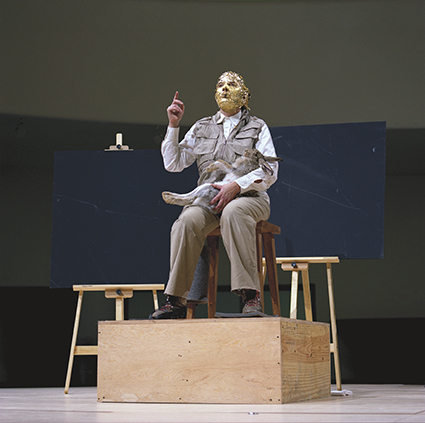
Marina Abramovic performing Joseph Beuys, How to Explain Pictures to a Dead Hare (1965) performance; 7 Easy Pieces, Solomon R. Guggenheim Museum, New York, 2005
Attilio Maranzano courtesy Marina Abramovic and Sean Kelly Gallery, New York
Marina Abramovic performing Joseph Beuys, How to Explain Pictures to a Dead Hare (1965) performance; 7 Easy Pieces, Solomon R. Guggenheim Museum, New York, 2005
At the centre of Performance Now, certainly in terms of viewing hours as well as influence, is Marina Abramovic, soon to visit Australia again. She appears in the documentation of her Guggenheim Museum seven-day, seven hours per day Seven Easy Pieces (2005) in which she “channelled” performance art greats in classic works: Bruce Nauman (Body Pressure, 1974), Vito Acconci (Seedbed, 1972), Valie Export (Action Pants: Genital Panic, 1969), Gina Pane (The Conditioning, 1973), and Joseph Beuys (How to Explain Pictures to a Dead Hare, 1965). These are shown alongside Entering the Other Side (2005) and Lips of Thomas (1975) in which the ingredients are the artist naked, red wine and honey (to be consumed), flagellation (self-applied), cutting (a pentagram into the stomach) and an ice cross. These works are shown unedited, simultaneously and the screens arranged in a circle—an interesting way to deal with focusing and switching attention with onscreen durational works.
Among video works is the laidback, sitcom-ish (pay attention to the dialogue) activism of Stealing Beauty (2007) by Guy Ben-Ner whose fun critique of consumerism and the nuclear family features the artist, his wife and children illicitly inhabiting IKEA display rooms in various countries. Stealing Beauty resonates nicely with the family in Kevin Wilson’s very funny novel The Family Fang (Picador, 2011) in which children are trapped in their artist parents’ interventions. The Ben-Ner kids however seem fine, but you do wonder.
In Christian Jankowski’s Rooftop Routine (2007), citizens of New York’s Chinatown happily hula-hoop on rooftops—so can you with the hula-hoops provided in the gallery.
In darker territory, choreographer Jérôme Bel’s Véronique Doisneau (2009) features a corp de ballet Paris Opera ballerina who simply talks about her career and the torturous conditions in which she works. In Ryan Trecartin’s acclaimed video A Family Finds Entertainment (2004) “a black-toothed kid named Skippy (played by Trecartin) borrows money from his parents, is filmed by a documentary filmmaker, is hit by a car, then filmed again as he lies in the road…his soul seems to rise from his body when it hears the sounds of a rocking house party” (program note).
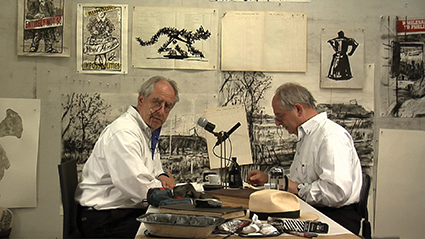
William Kentridge, Drawing Lesson 47 (Interview for New York Studio School) 2010, Single-channel video, colour, sound, 4 min., 48 sec.
Courtesy of the artist
William Kentridge, Drawing Lesson 47 (Interview for New York Studio School) 2010, Single-channel video, colour, sound, 4 min., 48 sec.
Elsewhere in Performance Now, William Kentridge stages an interview between his ‘good’ and ‘bad’ selves in Drawing Lesson 47 (Interview for New York Studio School) (2010) deploying his virtuosic animation skills in which the world constantly reconfigures. Another South African artist, Nandipha Mntambo, reflects darkly on colonial violence by playing a male Mozambiquean bullfighter preparing to fight in an abandoned Portuguese arena in the brief film Ukungenisa (2008).
These are just a few indicative examples of the range of art making involved in Performance Now, a show that demands pilgrimage from across Australia and all the durational immersion you can gladly muster.
Queensland University of Technology (QUT) Art Museum, Performance Now, 6 Dec 2014-1 March 2015, Brisbane
RealTime issue #124 Dec-Jan 2014 pg. 22-23
© Keith Gallasch; for permission to reproduce apply to realtime@realtimearts.net
I TELL DAVID SEFTON THAT I THINK HIS 2015 ADELAIDE FESTIVAL PROGRAM HAS MORE THAN A TOUCH OF THE LATERAL ABOUT IT, INCLUDING OSAKA’S OPERATIC NOISE, STRINGS, PIANOS AND VOCALS BAND VAMPILLIA. HE LAUGHS, “I THINK I’VE GOT ALL POINTS COVERED THIS YEAR.”
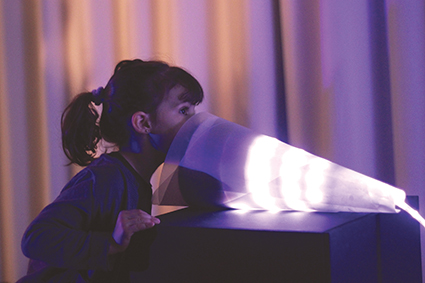
Chevalvert, 2Roqs, Splank & Polygraphik, Murmur, BLINC
photo courtesy Adelaide Festival
Chevalvert, 2Roqs, Splank & Polygraphik, Murmur, BLINC
Blinc
“Actually, you took the words right out of my mouth! Blinc, for example, is a massive, free, digital art expo we’re doing on the river and surrounding areas. It’s not just ephemera or ‘look at the shiny lights;’ this is a curated exhibition, an A-list of digital artists that just happens to be outdoors. It’s like a survey show of the latest in digital art—artists like Tony Oursler, who’s just had a major gallery show in London and whose work will be on Pinky Flat next to the Adelaide Oval here. It will be on free every night of the festival alongside the broadest ever showing in Australia of the work of Bill Viola, arguably the world’s greatest video artist.” Including Oursler, the Blinc contingent numbers 20 artists from Europe, the USA and Japan with works that range from laser projection to intimate interactives. Although Australian artists, so strong in this field, are strangely, and disappointingly, absent, it’s good to see electronic arts centre-stage in an arts festival.
Bill Viola
In contrast with last year’s epics—John Zorn and The Roman Tragedies—Sefton declares, “we’ve taken a different definition of ‘spectacular,’” as programming Blinc indicates. Bill Viola will be showing in three spaces: “in a gallery, in the cathedral and in a theatre space—because it was the only venue with a ceiling tall enough to fit the nine-metre high video screens. I’ve just seen his latest work in St Paul’s Cathedral in London. Because spirituality is so much a part of what he does, churches tend to be good places to see the work. I’m doing a platform discussion with Viola over the opening weekend.”
Cedar Lake Contemporary Ballet
On the dance front, Sefton has focused on one company with two large-scale programs. “Cedar Lake Contemporary Ballet from New York is an extraordinary entity insofar as they are a fully funded American dance company. That’s almost a contradiction now in that culture. They have one patron who enables them to cherry pick the best dancers in America and the world’s greatest choreographers as well. They’re a company I’d worked with in the US and we’ve been in discussion for a couple of years. They’re quite a young company in the scheme of things. We’re doing two major projects with them: one is a triple-bill with Jiri Kylian, Crystal Pite and Hofesh Shechter works made for the company. The other project is a whole evening’s work made for them by Sidi Larbi Cherkaoui. So it’s a huge commitment from us to one company in their first and exclusive Australian appearance.”
Gavin Bryars
Music is one of David Sefton’s great passions. I ask him where it’s taken him for his 2015 program. After the magnificent John Zorn tribute in 2014 (RT120, p20), Sefton has this time secured the presence of another great artist—UK bassist, improviser and post-minimalist composer Gavin Bryars—in a sizeable program of his works. “It’s not that he’s never been to Australia before but his ensemble hasn’t and the breadth of his work has never really been seen and heard here. He’ll be a kind of composer-in-residence for the festival. The symphonic Jesus’ Blood Never Failed Me Yet is obviously a signature work with Bryars conducting the Adelaide Symphony Orchestra.
“His ensemble will do a concert on their own and then one with guests including Song Company from Sydney, whom he’s worked with before—he’s a big fan. That concert will feature for the first time in Australia the suite of Tom Waits’ songs Bryars arranged at Waits’ invitation. We’ll also stage one of his operas—Marilyn Forever—another important aspect of Bryars’ work. It’s a chamber opera based on the life of Marilyn Monroe that’s only ever been seen in Canada where it was commissioned. Again, these works will be staged across a range of venues—the Town Hall, Elder Hall for his Ensemble concerts and ABC Studio 520 for the opera.
Unsound Adelaide
A challenging but popular dimension of Sefton’s Adelaide Festivals has been the international Unsound music program. Sefton says, “If it ain’t broke don’t fix it. I do like to change the look of the festival but in this case it’s such a rich seam of places to go with the electronic music world, there’s absolutely no reason not to continue it. Even though I was inordinately happy with the first two I feel like this is the strongest one. The program includes Forest Swords (UK), Shackleton (UK), Lawrence English (AUS), Vatican Shadow (US) and a work from Robin Fox (AUS) and Atom™ (Germany), which is a commission between us and the Polish branch of Unsound. We were able to get Fushitsusha (JAPAN) to come, led by rock experimentalist Keiji Heino—that’s a huge deal in the new music world. And there’s The Bug from the UK. We’ve ventured more into slightly clubbier territory for the first time. Basically the best way to describe a group like Model 500 is Detroit Kraftwerk.”
Tommy
Oddly for an international arts festival, there are two musicals, of a kind, in the 2015 program. Sefton admits, “I’m on record as saying I’m not a person that likes musicals and now, ironically I end up with two in the festival.” One is the re-imagining of The Who’s Tommy with producer Hal Willner at the helm—the other is Fela!, the concert version of the Broadway show featuring the work of Afrobeat master Fela Kuti. “The conversation about programming Tommy has been going on for something like six years. Eric Mingus came to me when I was still in Los Angeles and said, ‘Look, I wasn’t quite sure where to take this idea so I thought I’d come to you.’ Turns out for the best part of the previous decade he had been in communication with Pete Townshend about creating his version of Tommy. It seemed such an unlikely proposition but Pete Townshend has been 100% behind the idea from the start and has been working on it with Eric remotely. It never happened in Los Angeles and we got lucky because it is the 50th anniversary of The Who next year.
“It’s along the lines of an elaborate semi-staged concert with multiple guests. Hal Willner is known for that—the Leonard Cohen Came So Far For Beauty concert and so on. Eric is a much under-rated composer and arranger in his own right. He’s completely re-scoring Tommy for a jazz band—but with quite unconventional forces. He’s the musical director of the project. He’ll also take some of the singing roles because he’s got a fantastic voice. And, like his father [the great jazz bassist and composer Charles Mingus], his instrument is the bass. So he’ll be performing, arranging and singing. There are about half a dozen guest-singers.”
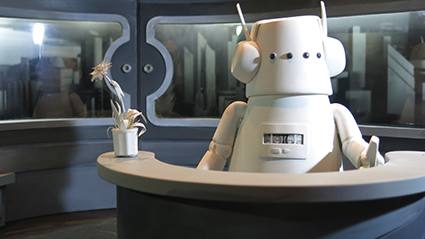
Kid Koala, Nufonia Must Fall
photo K K Barrett
Kid Koala, Nufonia Must Fall
Kid Koala, Nufonia Must Fall
Fans of Montreal’s Kid Koala will be ecstatic; the virtuoso scratch DJ, music producer and graphic comic book artist will be presenting an onstage version of his book Nufonia Must Fall. Sefton tells me, “There’ll be a dozen small puppetry stages projected onto a large screen over the artists and performed to a score—played by Kid Koala and the Alfara String Quartet—which I’ve heard and which is beautiful. He’s on the road as a turntablist in Australia in the month before the festival.” The production is directed by KK Barrett, the designer for Spike Jonze’s feature film Her (RT120, p28).
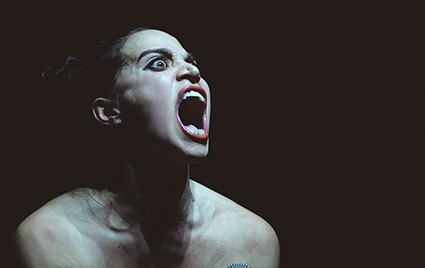
Silvia Gallerano, La Merda
photo Valeria Tomasulo
Silvia Gallerano, La Merda
La Merda
A work on the 2015 program I’d not heard of was La Merda. I ask Sefton where he found it. “I saw the show in Edinburgh three years ago and it completely knocked me sideways. Silvia Gallerano tours the world with it and has won a string of awards. It’s unlike anything I’ve ever seen.” I ask if it’s a confessional monologue. “Its like somebody allowing you to take the top of her head off to get a glimpse of a terrifying mind.”
Other monologues include the State Theatre Company’s Beckett Triptych (Footfalls with Pamela Rabe, Eh Joe with Paul Blackwell, Krapp’s Last Tape with Peter Carroll), Riverrun, from Ireland, which features the writing of James Joyce and Big Mouth’s SmallWaR (Belgium) about the nature of war, in a live/digital mix. “At the other end of the spectrum,” says Sefton, “we have Dylan Thomas—Return Journey(UK), another extraordinary performance. It’s the official Dylan Thomas centenary show remounted at the request of the estate. So the program’s ended up exploring the range of things that can be monologue.”
David Chisholm’s The Experiment
Australian composer David Chisholm’s The Experiment to a script by UK playwright Mark Ravenhill is a Major Festivals co-commission with the Sydney Festival and a work, Sefton thinks, “the Unsound audience should really come to.” There’s an electric guitarist—Chilean Mauricio Carrasco—centre-stage, performers, images by Emmanuel Berndoux and media art by Australian Matthew Gingold: “It’s very much a cohesive multimedia piece, and unsettling. It’s unquestionably a total theatre piece.” The work asks if we’d experiment on a child at the risk of their life if we thought it would save thousands more.
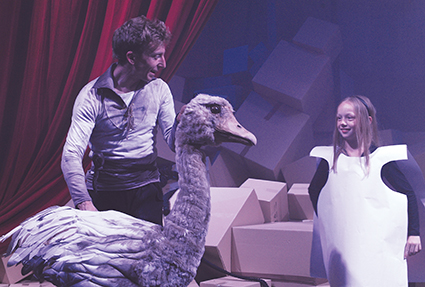
Chiara Guidi & collaborators, Jack & the Beanstalk
photo Heidrun Löhr
Chiara Guidi & collaborators, Jack & the Beanstalk
Chiara Guidi, Jack and the Beanstalk
In another work involving Australians in an international collaboration, Chiara Guidi of Italy’s Societas Raffaello Sanzio has created Jack and the Beanstalk with Australia’s Jeff Stein, Erth Visual and Physical Theatre and Insite Arts from a commission by Campbelltown Arts Centre and Adelaide Festival. This vivid work for and about children, who participate directly in it, visit the ogre’s incredible, towering cardboard home, encounter “slinky worm creatures,” a golden goose and the ogre himself—“a chilling apparition shrieking the kind of blackness you just might find in nightmares.” Bryoni Trezise concluded her appreciative review with the observation that “The children in the room…seem[ed] unnervingly content with this bleak but complex image of themselves” (RT 122, p42).
There’s a final recommendation from David Sefton: “When I got this job I did tell the powers that be here that there wasn’t any way I saw myself putting on anything in the Entertainment Centre because that’s not what I do. And then Danny Elfman’s Music from the Films of Tim Burton appeared on my radar and I thought well, never say never. The composer will be conducting but he also actually sings. Not many shows can claim that. There aren’t many things I’d consider cool enough to put into a 6,000-seat venue but I think in this case I’m prepared to make an exception.”
Adelaide Festival, 2015, 27 Feb-15 March
RealTime issue #124 Dec-Jan 2014 pg. 24-25
© Keith Gallasch; for permission to reproduce apply to realtime@realtimearts.net
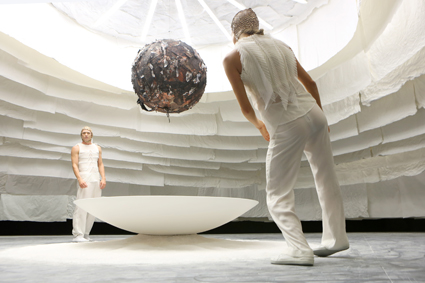
Inside There Falls
photo Prudence Upton
Inside There Falls
BY WAY OF EXPLAINING THE SOUND/UNSOUND COMPONENT OF HIS 2015 SYDNEY FESTIVAL AT CARRIAGEWORKS, ARTISTIC DIRECTOR LIEVEN BERTELS FILLS ME IN ON HIS BACKGROUND IN AND PASSION FOR MUSIC AND SOUND ART, WHICH IS EVIDENT IN OTHER WORKS IN THE PROGRAM: THE KITCHEN, PUNCTURE, ATOMIC BOMB, ON THE HARMFUL EFFECTS OF TOBACCO AND DARKNESS AND LIGHT. BUT IT’S MORE THAN MUSIC: IT’S MUSIC IN THE MIX OF INSTALLATION, THEATRE, SCREEN AND DANCE.
Bertels comes from a background of classical music and sound art, having trained in the late 80s, early 90s as a musicologist and composer at the University of Durham where there was a state of the art electro-acoustic studio at the time of the transition from analogue to digital. After graduating with his second master’s degree in 1994 he abandoned the notion of pursuing a career in composition, “but it gave me insight into sound art and a love of the manual labour, the craftsmanship of composing.” The same period was rich with postmodern diversity, opening Bertels’ listening, confirmed and expanded by the invention of “the democratising MP3”—often surprising himself with things he has stored and plays randomly.
Sound/On Sound
Bertels kindly offers me a copy of Recovery/Discovery, 40 Years of Surround Electronic Music in the UK (2008), a CD he conceived and produced featuring composers Jonathan Harvey, Harrison Birtwistle, Javier Alvarez and Mira Calix. Calix is a key guest in the 2015 Sydney Festival with an installation at Carriageworks as part of Bertels’ Sound/On Sound program. He notes, “It’s not the first time it’s happened but the convergence between theatre, installation art, music making in its concert form and electronic music consumption is significant. There are people in the visual arts who essentially make sound art installations, like Janet Cardiff. Others come from DJing and hip hop.”
Mira Calix
“Mira Calix started as a sound artist musician on WARP,” says Bertels, “a very important label in the early 90s in electronica and still the label for people like Aphex Twin and Squarepusher. She was the only woman on that label. I got to know her when I was at the Brugge Concertgebouw and I co-commissioned a work which combined the music of Steve Reich and Phillip Glass with Squarepusher, Aphex Twin and Mira Calix—real name Chantal Passamonte—who did a piece for the string players of London Sinfonietta and 100 live crickets, which we had to source—nice challenge! So we had a terrarium full of crickets and we needed to give her control over it because she knew the crickets would sing at a different speed depending on the temperature. She could then orchestrate the sound of the crickets and the speed of their ‘beating’ (or whatever you call it) to the music, which was beautiful.” It was then that Bertels invited Calix to be part of Recovery/Discovery and, subsequently, she expressed an interest in coming to Australia to do an installation, having been taken with a novella by Australian journalist and editor Brett Clegg—“a kind of stream-of-consciousness text called Inside There Falls. Clegg listens to a lot of electronic music and is a fan of Mira Calix and had managed to trace her email and sent her this text. She was fascinated by it, and wrote to him asking ‘what do you want me to do with this because I love it? Can we do something together?’ Then it was a matter of what they wanted—a big space to build an installation that would research these boundaries of concert performance, dance, installation and sound art. It is, of course, a leap of faith. This is the kind of risk you want to take in a festival.” Calix also wanted a live physical dimension for the installation so she approached Rafael Bonachela, inspired by what he had done in the Kaldor Project’s 13 Rooms.
“There’s an antechamber where you wait until there’s a group of about 20 and then enter as a group into Bay 17—the big space which will be transformed into a giant paper labyrinth you wander through, discovering elements of sound and text as well as encountering dance interventions.” Access to the work is free and there’s a tactile tour for the blind on 17 January.
Tamara Saulwick, Endings
There are two other commissions. Endings, commissioned by Sydney Festival, Arts House and Performance Space, is Melbourne performer Tamara Saulwick’s new work. By way of background Bertels recalls that when Edison patented the phonograph he didn’t foresee its future as delivering music: “The first two uses he listed were to record the words of famous people and of dying people as mementos. And now, 125 years later, how many people would feel comfortable about [recording] their dying relatives? It’s very confronting because the voice is way more personal than an image. It’s fascinating because at the same time it’s intangible. Sound memory is not very precise. If I try and remember the voice of my father it’s very hard. I can recognise it, just like a smell, but you can’t bring it back, you can’t recreate it. So that’s what Tamara Saulwick is working with—all kinds of sound recordings that have to do with endings. She’s cutting her own acetates and pressing the LPs she will use onstage in quite a ritualistic, theatrical kind of way.”
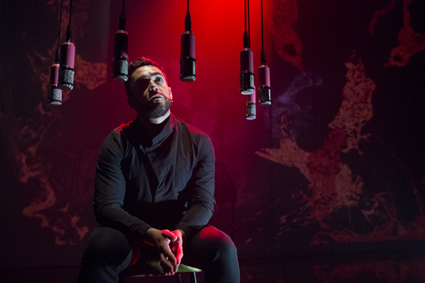
Mauricio Carrasco, The Experiment
photo Jamie Williams
Mauricio Carrasco, The Experiment
David Chisholm, The Experiment
The other commission—from Sydney, Adelaide and Melbourne Festivals through the Major Festivals Initiative—is The Experiment by Melbourne composer David Chisholm, founder and director of the Bendigo International Festival of Exploratory Music. Bertels says, “He’s a composer who’s very dear to me and should be heard way more often. I tried to get him to the Holland Festival before I came here. He’s a 21st century version of an Australian larrikin: witty, funny, outspoken. He’s also got an amazing sense for drama. The subject matter in The Experiment is essentially ethical: if you were close to solving a massive medical issue but you knew you had to kill a child, would you do it? He’s chosen a 19th century musical theatre form called monodrama—essentially spoken word and instrumental music. A guitarist performs in an installation with electronic sound. It’s a performative work with a beginning and an end but inside an installation as if we were part of the experiment.”
Greg Barrett, SpongeBob SquareTimes
“This is a very funny little work, also quite melancholic and very beautiful. It’s a bit of an experiment.” It’s the work of well-known Australian dance photographer Greg Barrett who lives between Melbourne, Palm Beach in Sydney and New York where “he had a fancy new camera which caught on video one of those sad buskers, like those who impersonate Disney characters. This was a SpongeBob character—and not engaging at all successfully. And that’s what he filmed for 48 minutes—a guy unsuccessfully trying to make some money until finally a family engages with him and gives him a few dollars. When Greg saw this footage he said he felt this was something he wanted to present as an installation with music that reflects loneliness for him—one of the seminal minimalist music pieces from Europe, Canto Ostinato by Simeon ten Holt, a piece for anything from two to eight pianos. So Greg chose to present it as two player pianos, two pianolas, to reflect that loneliness. I’ve just received from the Simeon ten Holt estate a MIDI version played for us by two people to be programmed onto massive Yamaha Disklaviers, the modern player pianos. The installation will be two lonely pianos playing with the video.”
Bernard Foccroulle, Lynette Wallworth, Darkness and Light
Darkness and Light, another work connecting Australian and European artists (and commissioning partners), is a double projection screen work by Lynette Wallworth with music by Sofia Gubaidalina (the show’s title comes from a work of the composer who proudly describes her self as half-Tartar, half-Slav”), Bach, Buxtehude, Messiaen and rising star Toshio Hosokawa played by Belgian organ virtuoso, Bernard Foccroulle, the director of the Aix en Provence Opera Festival. “In this collaboration,” says Bertels, “the challenge has been to balance music and video because “your brain needs 85% of its capacity to decode the image [which means] you’re not listening any more. The artists presented the work for the re-inauguration of the organ at Royal Festival Hall in London and then took it to Brussels.” Wallworth’s expansive projections, drawing on the Australian landscape and NASA astronomical film footage, will doubtless resonate powerfully, if subtly, with the Sydney Town Hall organ.
Theatre Des Bouffes du Nord, On the Harmful Effects of Tobacco
Another of Bertels’ other music-oriented recommendations is Theatre Des Bouffes du Nord (the Peter Brook company) with its On the Harmful Effects of Tobacco, adapted from the Chekhov story to music by Bach, Tchaikovsky and Luciano Berio. It’s smaller than previous festival works Semele Walk (2012) and Dido and Aeneas (2014), says Bertels, but in line with his commitment to blending live music with theatre. “This is a good example because it’s part Chekhov monologue and part concert on a very high level and there is a very funny, classy actor in it, Michel Robin, who is 83 years old who, in daily life, walks with a walking frame but onstage suddenly shakes off 20 years.” I ask how the music is integrated with the monologue. “As little interventions by three schoolgirls in ornate 19th century frocks designed by Christian Lacroix. They sing, they play piano and violin and interact with the man.” Chekov’s subject should be delivering a talk to us about the evils of tobacco but finds himself ranting about his domestic situation.
Atomic Bomb, The Music of William Onyeabor
“Another show with music we’re very proud of is Atomic Bomb,” says Bertels. “On his record label Luaka Bop, David Byrne released a compilation of the surviving albums of a really enigmatic and slightly odd Nigerian musician from the 80s called William Onyeabor. He’s still alive, a newborn Christian now, and doesn’t necessarily want to perform his own music any more. But Byrne did, with NY-based African musician Sinkane, Onyeabor’s original backing vocalists and guests. It transferred to London where Byrne’s MC role was taken by Damon Albarn from Gorillaz. We wondered who would be right in Australia and we approached Gotye, who is between albums and working on new material and was very keen to perform.”
Vicki Van Hout, Long Grass
A likely highlight in this year’s About an Hour program at the Seymour Centre will be Indigenous choreographer Vicki Van Hout’s Long Grass. An idiosyncratic artist who draws on Aboriginal and modern dance traditions and has an acute theatrical sensibility and design eye, Van Hout engages in this new work with the lives and culture of Indigenous people who live on the streets and in the parks of a modern city, Darwin, where they are perceived to be homeless, without character and are labelled “Long Grassers.” Bertels says, “the work looked very promising from the first workshop version. At the end of this festival, [we’ll have presented] 30 new Australian works over these three years—as presenting partners, or commissioning or co-commissioning. We didn’t commission Long Grass but it’s a very important work for us because of its Indigenous elements but also that kind of small-scale experimental dance doesn’t have a lot of outlets.”
More in About an Hour
Other shows in About an Hour include the hyper-physical theatre work The Long Pigs (RT120, p42; from Melbourne), featuring a trio of nasty clowns in search of a lost nose with bloody consequences; Perth-based The Last Great Hunt’s Falling Through Clouds; and shows from the USA—Adrienne Truscott’s Asking for It, a scathing exploration of rape language in the everyday and especially in comedy—and from Ireland, Have I No Mouth, in which a family and their real-life therapist deal with a death.
Also on at the Seymour Centre will be Australian Theatre Forum, curated by David Williams, featuring conversations and provocations on the role theatre has in shaping our culture.
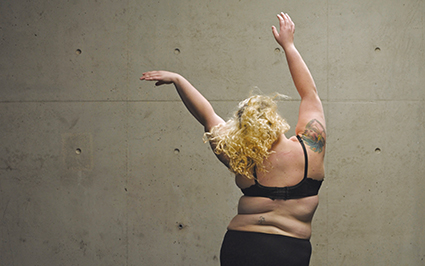
Force Majeure, Nothing to Lose
photo Toby Burrows
Force Majeure, Nothing to Lose
Force Majeure, Nothing to Lose
Another Australian dance work is Force Majeure’s Nothing to Lose—a Carriageworks and Sydney Festival co-commission and the last of the exiting artistic director Kate Champion’s productions for her company. It focuses on body weight, body aesthetics and dance. Local artist and “fat activist” Kelli Jean Drinkwater is Champion’s collaborator and Torres Strait Islander dancer Ghenoa Gela is providing additional choreography. Bertels tells me, “Champion workshopped with a number of people with very large bodies and explored all the language around being fat—‘obese,’ ‘oversize’ etc—and the work taps into the meanings quite beautifully. Kate’s strength is she’s good at making ensemble dance pieces that also tell important stories.” Like Long Grass, Nothing to Lose should be a ‘must see.’
Legs on the Wall, FORM and VOX Choir: Puncture
Puncture is set on a dance floor—in the broadest sense—as the site for masked ball, tango, fox trot, mosh pit, classical and pop dancing—on a monumental scale with 12 dancers (led by Kristina Chan and Joshua Thomson to choreography by Kathryn Puie) with the Sydney Philharmonia Vox Youth Choir and percussionist Bree van Reyk performing a score composed and arranged by Stefan Gregory that ranges from Monteverdi to Madonna. As well, there’ll be the physical theatre you’d expect from Legs, electronics by Bob Scott and video by Mic Gruchy. Pina Bausch’s dance-hall Kontaktoff it won’t be but a work with something to say on its own terms about the social and ritualistic nature of dance, dramatically puncturing formal dancing with the styles that have constantly challenged and sometimes corrupted it.
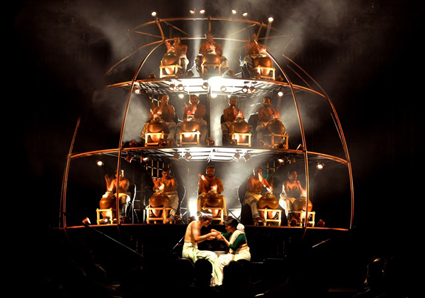
The Kitchen
photo courtesy Sydney Festival
The Kitchen
Roysten Abel, The Kitchen
In the footsteps of the sold-out The Manganiya Seduction in 2010 with its wall of Indian musicians comes The Kitchen. “Again, it’s a work with a simple dramaturgical arc,” says Bertels, “building energy through music. What’s new here is that there’s a story. A couple are cooking a temple sweet from Kerala, the region where Roysten Abel, the director, comes from, which will be served to the audience at the end. The idea is that you need to be ‘cooked’ to get ready for life. The aromas of the cooking will waft out over the audience as it takes in wonderful music from 12 drummers.” Also in the festival’s 2015 program is ancient Kandyan dance from Sri Lanka in Dancing for the Gods.
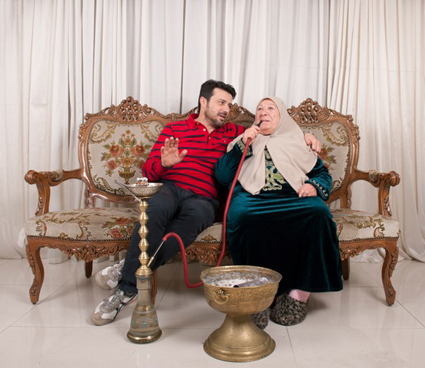
Michael & Samira, Bankstown Live
photo Joanne Saad
Michael & Samira, Bankstown Live
Urban Theatre Projects, Bankstown
For Campbelltown Arts Centre and the 2011 Sydney Festival Rosie Dennis created MINTO:LIVE (RT101, p16) in suburban outer Sydney. In 2014 Karen Therese created FUNPARK (RT119, p15) in Bidwell, Western Sydney. These works effectively brought together local and visiting artists and communities. For the 2015 festival, Dennis, now artistic director of Urban Theatre Projects, presents Bankstown: Live, a four-hour, four-day event featuring nine new works created in collaboration with local residents who have offered their homes as the sites for performance, screen and audio works or the telling of their own family histories.
Alwin Reamillo and locals will build a bamboo house that will be carried through the streets “in homage to Bayanihan, a Filipino tradition of the community helping to re-locate people from one village to another” (press release). Michael Mohammed Ahmad’s novel The Tribe about three generations of a local refugee Lebanese Muslim sect and their difficult place in the community has been adapted for performance by Janice Muller. Rosie Dennis’ documentary film Bre & Back focuses on Indigenous motherhood and cultural leadership. Emma Saunders is leading The Bankstown Dancing Project, working weekly with locals to prepare for dancing publicly on Northam Street and singer Sofia Brous and some great UK musicians will perform an array of local lullabies in Lullaby Movement. And there’s much more in what will doubtless be a revealing and embracing event.
As this mere sampling of a huge program indicates, Lieven Bertels’ third Sydney Festival is rich in cultural diversity and experiments in form and collaboration where adventurous Australian artists figure prominently.
Sydney Festival 2015, 8-26 Jan
RealTime issue #124 Dec-Jan 2014 pg. 26-27
© Keith Gallasch; for permission to reproduce apply to realtime@realtimearts.net
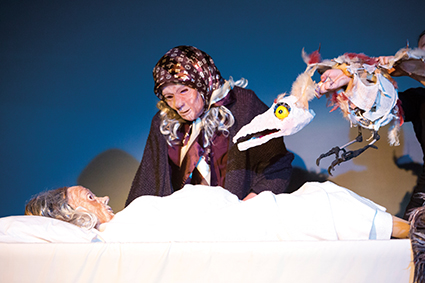
The Package
photo Steven Pearce
The Package
FOR OVER A DECADE NOW THE ALICE SPRINGS DESERT FESTIVAL HAS GATHERED ARTISTS AND PERFORMERS FROM AUSTRALIA AND ABROAD FOR A FIVE-DAY SHOWCASE IN THE RED CENTRE. IT’S A SMALL AND INTIMATE AFFAIR WITH A LOT OF INTERACTION BETWEEN PERFORMERS AND THEIR AUDIENCES. IT IS ALSO A CHANCE FOR NEW AND LOCAL ARTISTS TO PRESENT WORK ALONGSIDE MORE ESTABLISHED ACTS.
As with a lot of art from this part of the world the desert landscape played a role in some of this year’s offerings and one performance in particular explored the human interaction with the dry river that runs through town.
Out Hear in Alice Springs
For thousands of years the Todd River and its underground aquifers have given life to the various people and animals that inhabit Central Australia. For most of the year, however, the Todd is a dry sandy riverbed, devoid of surface water. It is a silent but often neglected reminder of how life in this part of the world is inextricably linked to this precious resource. In a series of performances called Out Hear in Alice, artist-musician Dale Gorfinkel and performer Fina Po used the dry river as both a stage and a medium to create an audio and visual experience that evoked the gurgling and bubbling soundscape of water and of the indifferent human interactions with the river.
Audiences walk along the river on a wordless tour of a series of sound and performance stations. At some of these stations Gorfinkel has assembled a scrappy looking collection of rubber hoses, bits of wire and empty bottles to create a water-themed soundscape. We listen to the bubbling sounds of ping-pong balls bouncing up and down inside discarded plastic bottles with tiny electric motors attached to them. The gentle bubbling and humming mesh beautifully with the melodic pulsing of the birds in the trees above. At another station we find Po walking frantically in a tight circle as she mesmerically recites a series of simple phone conversations. While this mindless melodrama unfolds Gorfinkel uses a simple foot pump to push sound through a kind of pipe organ he has buried in the sand. The rubber hoses capped with tin horns and empty wine bottles at first emit a grating, choking sound but as Gorfinkel adjusts the valves he transforms the cacophony into a deep and resonant pulse that drowns out the actor with the phone.
Walking between stations Gorfinkel keeps up a steady gurgling hum by blowing sound out through a brass horn that he has attached to an extended rubber nozzle. Approaching the penultimate station we watch Po’s character talk herself to death in a shallow grave and Gorfinkel literally burying her with sound by using the end of his horn to cover her body in sand. The Saturday performance of Out Hear ended with a wonderfully unplanned exchange as Gorfinkel’s soft sounds were drowned out by an aggressive white cockatoo who screeched from a tree in his part of the river.
The Package
Part of the Desert Festival’s mission is to showcase local talent. This year audiences were treated to a touching tribute to life and memory with the premiere of The Package. This hybrid of mask work and puppetry is the creation of Alice Springs artist Katlend Griffin, the 2014 recipient of the Arts Incubator Award, a grant designed especially to foster the work of local artists for presentation at the festival.
Through music, dance and puppetry The Package illuminates the final moments and the lifetime of memories of a dying woman. The action starts with the sorrowful sounds of an accordion as a frail elderly woman lifts herself onto a hospital bed at the centre of the stage. After a seemingly grim diagnosis from her doctor a puppet bird arrives and urges the dying woman to open up one of the cardboard boxes that have started to pile up around her bed.
From the first box the woman removes a doll and her demeanour begins to brighten. A red-haired girl puppet appears, plays with the doll and grows older in a series of memory-vignettes staged by two performers alternating roles as actor and puppeteer. At one point the girl emerges from the box with a young man beside her. They are naked and both display ridiculously large genitalia. In the old woman’s mind features like these seem to bear enormous significance; later when the puppet of the pregnant young woman gives birth to a ridiculously large baby we witness a similar effect in the memory’s ability to distort. In the end, the elderly lady lifts an old and nearly lifeless puppet from the boxes—she is holding herself and is ready to say goodbye.
Griffin’s The Package is a both sorrowful and playful musing on life’s transitions and the retention and manipulation of memory. Its positive reception affirms the value of fostering such homegrown productions and sets a standard for similar projects in years to come.
Alice Springs Desert Festival: The Package, creator Katlend Griffin, Red Hot Arts Incubator Program, Totem Theatre, 11 Sept; Out Hear in Alice Springs, artist, musician Dale Gorfinkel, performer Fina Po, Alice Springs, 13, 14 Sept
RealTime issue #124 Dec-Jan 2014 pg. 28
© Mike Bodnar; for permission to reproduce apply to realtime@realtimearts.net
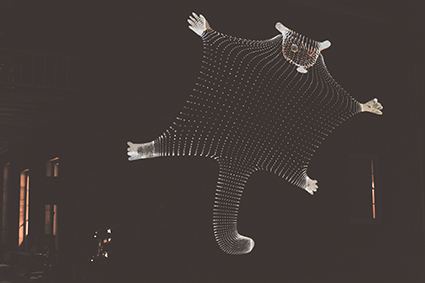
Stalker Theatre projection creature
photo Heidrun Löhr, courtesy of Bundanon Trust
Stalker Theatre projection creature
“IMAGINE YOUR SOUL, THEN, AS TIMBER; YOUR MIND META-MORPHOSED TO MYRTLE; YOUR LIFE A FOREST OF THESIS AND CHANT. WALKING HERE, AMONG ELDERS, MAKES A GARDEN OF ME; I AM CURATED, TENDED AND CONSERVED.”
These words from poet Mark Tredinnick capture the essence of this year’s Siteworks at Bundanon, and are displayed in the Singleman’s Hut by artist Janet Laurence as part of her long-term major project Treelines Track. The work is a new commission in partnership with Landcare Australia that “tells stories” through the planting of trees (once there, but no longer) in a new conversation with their native surrounds.
Reflecting on Tredinnick’s thought meditation, I see it as one response to activist Naomi Klein’s request that “we need to think differently, radically differently” if we are to effect some kind of change in the face of a worsening, potentially irrecuperable environmental crisis. For Klein it is necessary to address the failings of capitalism; for the scientists, ecologists and artists that gathered in the kangaroo and wombat-clad hills of beautiful Bundanon, the need is to look to imagination, our capacity for empathy toward earth and other species and the evocation of deeper perceptual structures, where we watch, listen and feel differently.
From curated discussions, disciplinary exchanges, creative collaborations in situ and immersive bush and river walks, the weekend’s cliffhanger for me was the dilemma of individually ‘knowing how’ to change, but ‘not knowing how’ to change collectively, as a global community. Both science and everyday experience evidence a heating planet, rising sea levels, natural disasters and loss of biodiversity. We are at a point where, as climate change ecologist Brendan Mackey soberly announced, “all the numbers have been crunched.” Whether we believe in some variation of the ‘holocene’ age where humanity and its damaging effects are understood as a ‘mere blip’ in this particular epoch of earth’s history (it’s only a matter of time until the land asks us to leave), or we invest in the virtues of the ‘anthropocene’ where human impact is all pervading, entailing responsibility, the promise of solutions, and more sinisterly, control, the commitment to change comes not from defending a position, but from allowing ourselves to feel, think and reflect differently. Siteworks continues to be a unique forum that gently reminds the most converted of us to do so.
Art is a way to blur conceptual boundaries. Rosemary Laing’s The Paper (exhibited as stills) reflects both epochal views in her carpeting of the bush floor with “truckloads” of newspaper pulp: human impact is everywhere and effaced by bush regeneration.
The Earth Law conference co-convened by Michelle Maloney and Jules Livingstone of Australian Earth Law Alliance, Tess De Quincey and Tom Rivard took place on Friday. The brainstorming session involved experts from the fields of science, arts, the law, education and finance who distilled topics for Siteworks attendees (1,100 registered for 2014) to discuss in small rotating groups during Saturday’s main conversation “Finding our Place in the Anthropocene”, hosted with wit by science journalist Robyn Williams. The main panel with Dr Shane Norrish (Landcare Australia), Michelle Maloney and Mindjingbal man Clarence Slockee (Education Officer, Sydney Botanic Gardens, who appears on Gardening Australia) was lively and informative. Each reflected on what a “sense of place” means to them, localising recognition and the effects of the anthropocene and the reimagining of our laws to support a deeper connectivity with the plants, animals and land through “earth jurisprudence.”
On the performance trail we first gather under the hovering drone used in Leon Cmielewski and Josephine Starrs’ site-specific work Dancing with Drones. Performer Alison Plevey reproduces, with slight delay, the movement we see projected onto a screen, shot overhead by the same drone in various locations at Bundanon. The footage is composited as a split image, juxtaposed with black and white footage of Plevey taken from a human standpoint. Here, the colour footage taken by the craft sensitively records nuanced movements of the dancer in a vertical duet, reconstituting the role of the drone as filmmaker, rather than as an instrument surveilling a target.
De Quincey Co’s Mountain and Water draws us to the banks of the pond between Henry’s Bridge and the Jetty. A hunched, squatting figure (Victoria Hunt) emerges from the inky black heaped in a robe of colours, intensifying the beginnings of vertical ascension and layering of ancestors. From within the cacophony of frogs, we hear Amanda Stewart’s voice, a word here a phrase there and sound from musicians Jim Denley and Dale Garfinkel. I think of the absurd logics of consumption: an ugly mountain of incoherency. The slamming of words together provokes normative thoughts: how should we live? From across the water, a leaking angel (Peter Fraser) floats towards us arcing and flooded with light. Boundaries, borders and membranes are transcended.
From the banks we return to the homestead to the projected 3D-structural drawings of Creature (Stalker Theatre and UTS Creativity & Cognition Studios). Water birds, wombats and sugar gliders swell and swirl into being, dissolving from their edges. Fixated we anticipate emerging forms in gasps of delight. A live dancer disturbs the particles with large sweeping extensions. Creatures disappear. Audience are invited to interact, make their impact; the anthropocene felt.
Black Nectar (Keith Armstrong, Lawrence English, Luke Lickfold) asks us to deepen our perceptual listening and seeing in the darkness of Bundanon’s Amphitheatre. Minimising the thick, noisy content of everyday experience, our attentiveness to the life of the bush is sharpened. In procession we are led to await the appearance of fibre optic lights in a subtle choreography drawing on the complex flowering patterns of the Eucalypt nectar that affects the migratory trails of the Grey Headed Flying Bat (mapped by Peggy Eby). Sonically the sounds of the bush are thickened. Only to the local ear, or one who listens carefully, can the layering of amplified and introduced birdcalls and insects be detected in vibratory channels of momentary electronic noise. Black Nectar exposes the perceptual tunnels we seek comfort in and with which we veil our ignorance.
The evening ends with Nigel Kellaway on piano viewed through the window of the homestead (15 Short Scenes on the Dichterliebe) and swaying with red wine in plastic cups to the convivial tunes of Olive and Concetta (Annette Tesoriero and Cathie Travers) under a marquee. Then it’s off to the Biopod for one lucky person who floats the night away in Nigel Helyer’s “micro-architectural structure.” Tiny spaces have an interesting effect on the senses: expanding, shrinking, amplifying or confusing. Helyer emphasises the aural experience in this “overnight acoustic vigil for a single person” who adds their narrative to the “capsule’s log” in a digital archive. Here the imaginary re-flavours reality: Who are we? Where are we?
Sunday culminates with a number of Bioblitz walks, activities focused on Citizen Science whereby amateurs collectively look, find and record an array of flora and fauna local to the property, adding this documentation to the Atlas of Living Australia. By Sunday afternoon with the city’s grip on my senses loosened, I was able to listen intently and capture the unique movement and colour of feathery creatures bouncing from tree to tree; and closely inspect, taste, touch and learn of the historical and cultural uses of plants, flowers and fruits with Clive Freeman on the Indigenous Plant Use Walk.
Siteworks is an event where one can imagine the soul as timber, and feel sensuously engaged with the surroundings within an expertly framed conversation. If only all Australians could be given the opportunity to reprioritise their energies and be opened by such experiences, we might begin to sustain the earth in return.
Siteworks 2014, Bundanon Homestead and Grounds, NSW, 26-28 Sept
RealTime issue #124 Dec-Jan 2014 pg. 29
© Jodie McNeilly; for permission to reproduce apply to realtime@realtimearts.net
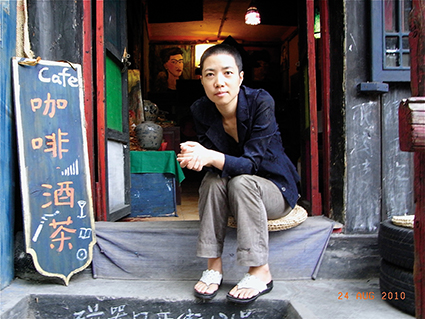
Zhang Lei at home, film still from China’s 3 Dreams
CHINA: FAVOURED DESTINATION OF TRADE DELEGATIONS, THE FOCUS OF OUR HARDEST FOUGHT FREE TRADE DEAL AND THE BEDROCK OF THE ASIAN CENTURY. THE CLICHÉS GO ON. YET FOR ALL THE POLITICAL RHETORIC AND ACRES OF PRINT PRODUCED ABOUT THE PEOPLE’S REPUBLIC, IT’S CLEAR THAT MOST AUSTRALIANS—OUR POLITICIANS INCLUDED—KNOW VERY LITTLE ABOUT THE PLACE, ITS HISTORY OR ITS CULTURE. AND WITH ONE EXCEPTION, NO AUSTRALIAN DOCUMENTARY MAKER HAS PRODUCED A SUSTAINED BODY OF WORK FOCUSED ON CHINA. THAT EXCEPTION IS NICK TORRENS.
Torrens’ fourth and latest China-focused work, China’s 3 Dreams, is also his most ambitious, adopting a deep-focus historical take on the country’s contemporary situation. The main thread follows the attempts of Zhang Lei, a troubled young café owner and single mother in Chongqing, central China, to unravel her family’s traumatic history. Her tale is contrasted with another Chongqing couple as they struggle to buy an apartment and achieve their material ambitions on minimal wages.
For anyone who has spent time in China, the vacuum of historical knowledge among the younger generations is striking. At one level history is everywhere, as the state trumpets “5,000 years of civilisation” on a daily basis and Japanese wartime atrocities are replayed nightly on television. But ask anyone under 40 what happened during Mao’s reign or in the 1980s, and you’re unlikely to receive more than the sketchiest of answers.
“I wondered what the impact of that lack of historical knowledge might be on the future for all of us, not just China,” muses Torrens. “What effect will that have on China and on the West when the current generation become leaders?”
A millennium-old community in Chongqing known as Ciqikou seemed to offer the possibility of finding a way into answering these questions, but it took Torrens two years to find a local who could help with his quest. It took the same time again to gain her trust. “Zhang Lei wasn’t going to open up right at the beginning,” explains the director. “She felt different from her contemporaries. She felt alone, unhappy, and thought love had been devalued by contemporary developments. The story became her gradually understanding that the way she felt was based on the problems of China’s past—the Anti-Rightist Movement of the 1950s that put her Grandfather away for 22 years, and the Cultural Revolution that was responsible for the ‘bad parenting,’ as she put it, that she experienced. Then she realised the whole of China has this story. So maybe it’s a national problem.”
Although several independent Chinese documentaries have delved into similar issues, it’s rare for a film by an outsider to tackle the complex historical questions posed by China’s 3 Dreams. The film could perhaps have benefitted from more time unpicking Zhang Lei’s story and less time on the parallel tale of the house-seeking young couple. The rather superficial treatment of the couple’s dreams makes them appear somewhat facile next to Zhang’s troubled ruminations, which is possibly a disservice to their struggles and aspirations.
Nonetheless, Torrens’ film is far more nuanced and complex than much of the simplistic documentary work on China produced in the West—a result of the many years Torrens spent on the project, and the three China-related films he made before this one.
Hong Kong as a bridgehead
“It was Hong Kong that started my interest in China,” explains Torrens, recalling his first film made in what was then a British colony in 1984. “I was learning every second of every day about a whole new culture,” he says of his first weeks there. “Then I couldn’t leave it alone.”
Torrens’ initial time in Hong Kong produced Running From the Ghost, an observational work about poor Chinese struggling in the cracks of the colony’s burgeoning economy of the 1980s. Viewed today, the film provides a fascinating snapshot of a time when sprawling shantytowns occupied land on Hong Kong Island now worth millions. The film is also a reminder that many of the urbanisation problems presently being experienced on the mainland were evident in British Hong Kong during earlier decades.
Torrens’ friendship with a local Hong Kong businessman, Vincent Lee, provided the focus of his next film, and a bridge into the vast land over Hong Kong’s border. As the territory approached its handover to China in 1997, Lee and his Canadian business partner Mart Bakal began looking for ways to grab a piece of the Chinese economy, already in the midst of a boom. Torrens traced their efforts across two films, the hour-long To Get Rich is Glorious (1998) and the feature-length The Men Who Would Conquer China (2004).
Through Vincent Lee, these documentaries provide a rare glimpse into the inner workings of one of the mega-rich families that dominate Hong Kong, and the often contradictory ways in which they view mainland China. Even more eye-opening for a Western audience is the naivety of Mart Bakal, a North American businessman who seems to regard it as his mission to bend China to Western capitalism. The lack of reflection underlying Bakal’s actions and comments in the films is breathtaking, but it’s a testament to Torrens’ skill that he got these businessmen to open up so unselfconsciously for his camera.
The end of a documentary tradition?
Torrens’ work, in both its style and prolonged attention on a particular place, sits in a tradition of independent Australian documentary making established by directors like Dennis O’Rourke and the partnership of Bob Connolly and Robin Anderson in the 1970s and 80s. Across a series of films, these filmmakers probed the cultures of our neighbours in Papua New Guinea and the Pacific and the complexities of our relationship with these societies. Despite this illustrious heritage, and the fact that China’s 3 Dreams is Torrens’ strongest and most insightful China work, it’s also the film that he has had most difficulty getting to audiences.
“I went too long past the time television wanted these films,” Torrens comments ruefully. “When I started on this project [in the late 1990s] these kinds of films were very viable, but broadcasters no longer want open-ended, layered documentaries. They want factual entertainment with a formula and narrator.”
Although the two premiere screenings of China’s 3 Dreams at the 2014 Sydney Film Festival sold out within days, no local broadcaster has purchased the film. Torrens claims that current commissioning and purchasing practises at the ABC and SBS mean a whole tradition of Australian documentary making is in danger of being strangled—or at least being cut off from much of its audience. “With the public broadcasters’ embrace of commercial imperatives, a whole approach to open-minded filmmaking is really forever lost,” he claims.
If we are serious about so-called “Asian literacy,” then films like China’s 3 Dream should be the mainstay of Australian television documentary. At the very least, films like this provide welcome relief from the endless cooking programs that now pass for serious engagement with other cultures on SBS. More importantly for our local documentary sector, committed filmmakers like Nick Torrens should be recognised and supported as the leading cultural figures they are. Unfortunately, they are more often made to feel like pallbearers for our incredibly rich independent documentary tradition.
China’s 3 Dreams, director, producer, writer Nick Torrens; 2014; www.nicktorrensfilms.com.au
The Men Who Would Conquer China can be viewed at TheAge.tv: www.theage.com.au/tv/Documentary/The-Men-Who-Would-Conquer-China-4280103.html
To Get Rich is Glorious can be viewed at CultureUnplugged.com: www.cultureunplugged.com/play/297/To-Get-Rich-is-Glorious—Deng-Xiaoping
RealTime issue #124 Dec-Jan 2014 pg. 30
© Dan Edwards; for permission to reproduce apply to realtime@realtimearts.net
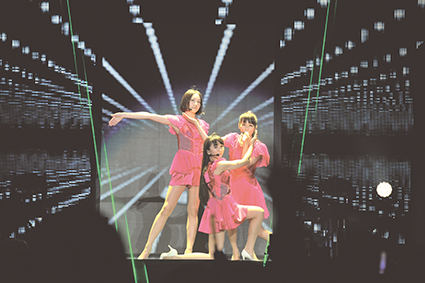
Perfume, Love Japan Night, National Stadium Tokyo, 29 May, TB broadcast 10 Aug
ZAHA HADID ARCHITECTS’ NEW NATIONAL STADIUM FOR THE 2020 TOKYO OLYMPICS IS DECLARED TO BE “A PIECE OF THE CITY’S FABRIC, AND URBAN CONNECTOR WHICH ENHANCES AND MODULATES PEOPLE MOVING THROUGH THE SITE FROM DIFFERENT DIRECTIONS AND POINTS OF ACCESS.” TOKYOITES ARE MORE CONCERNED ABOUT THE BULLDOZING OF ONE OF JAPAN’S MOST IMPORTANT PSYCHO-CULTURAL EDIFICES OF THE POST-WAR RECONSTRUCTION.
The original National Stadium is the ground zero of Japan’s rebirth for the 1964 Tokyo Olympics. It’s where Katsuhiro Otomo sites Neo-Tokyo 31 years after the Third Nuclear War in his anime allegory for Japan’s mid-Showa era of advanced industrialisation, Akira (serialised 1982-1990). He famously compared the stadium’s concave black hole to a convex white detonation, suggesting that Bubble-era Japan was doomed to karmic cycles of decimation.
In this sense, the National Stadium is a sacred site. ZHA’s New National Stadium misses this point: instead of accepting negative space as form, it negates space to construct form. It tolls the bell for a diminishing spatial respect for which Japan is renowned. A wake of sorts was held at the original National Stadium. But it wasn’t organised by city planners or architects, or even sports people. Over two days and nights, a stellar array of Japanese pop and rock artists staged a festival to honour one of the major venues for live music in Japan. Broadcast by BS-SPTV and NHK World, the stand-out performance was by Perfume: a trio of Idol singers from Hiroshima who in the later 2000s became Japan’s most successful ‘Techno-Pop’ band, crossing over from being a pure Idol invention into a group produced by Yasutaka Nakata (originally from one of the key Shibuya Pop groups of the late 90s, Capsule). For Love Japan Night, Perfume performed a selection of their hits in modified presentation from their earlier tours, which cannily resonated with the significance of the event and its site.
Prior to the band’s entrance, three giant screens stand spread across the stage. On the side screens, a circle is drawn in phosphorescent lines. It quickly becomes a pair of cross-hairs, rotating and tilting, transforming into a portal from which a teeming waterfall of light shoots upwards. Typical of anime physics, everything is reversed, as a zillion particles form an energy beam which distorts gravity. From this reconstructed zone, six stiletto shoes appear. The audience screams in delight; Perfume are in the house. Neither live nor living just yet, they’re being invented and constructed before our ears and eyes. In a vertically rising reverse strip-tease, the stilettos grow feet, calves, thighs. The light intensifies, as does the cheering crowd. At crotch-height, a cloud of blinding light particles rises, then morphs into the glowing upper-body silhouettes of the three members of Perfume: Nocchi, Kashiyuka and A~chan. There they now stand, thin waifs of vaporous wire-frame form, each with hair resembling a perfect wig: short, medium, long. Molecular transporting in Star Trek was never this erotic.
The glow of the three formed bodies is reduced as they stand, silent and faceless. They’re transparent cellular creatures from fathomless oceanic digitalia, born of light, now rendered as exo-shapes. Then, a red heart beats in each of them, recalling the red beating orb of Neo-Tokyo in Akira. In perfect synch to their joint pulse, a battalion of glow-sticks in the audience throbs red (itself an amazing technical feat of wireless convergence). Everything glows red for flashing seconds with each heart beat. This isn’t just Perfume as a band: this is symbolic of life being created, stimulating the audience as part of the ritual. Their life forms fade into black, leaving only the three red hearts.
After a second of silence, the side screens blast us with giant close-ups of the faces of Perfume. Head and shoulders like an ad for hair conditioner. Faces bleached and glowing white like the creation of the fake Maria in Fritz Lang’s Metropolis (1925). In vocoded tones they chime: “Welcome To The New Arrival.” The audience knows the track well: “Edge” from their 2009 album Triangle. It was claimed to be their 80s- inspired album, but like all such projects, it’s completely of its own era. A phalanx of bass-synths percolating in a mix of pseudo-analogue warbling and sharp digital grunting straddles three decades of synth programming in a recombinant DNA effect of what in Japan is called “Techno Pop.”
To this instrumental opening, the three screens create a wide panorama of tilting neon-tubes, like a Dan Flavin exhibition shot through a kaleidoscope. This is Perfume’s music visualised appropriately as a network of patterns—interlaced, braided, convolved, matrixed. It sounds like Kraftwerk put through an aural kaleidoscope. Then in the centre stage, three six-metre tall light boxes are pushed out from the centre screen. They each show a life-size video image of Nocchi, Kashiyuka and A~chan, beautiful cyborgs striking a sassy but casual pose with arms folded. The music continues its dramatic ascent as their bodies slowly rise upwards, engulfed in a series of pulsing halos, again referencing Metropolis. From within these boxes, the three girls of Perfume emerge from rising platforms, perfectly synched to their projected images. The virtual becomes real; Perfume is now in the house. They launch into their Autotuned vocals with low-key synchronised movement, somewhere between calisthenics, synchronised swimming, postmodern anti-dance and plain preening in front of the mirror. Indeed, it’s the hybrid of these forms of movement which constitutes Perfume’s choreographed charm. And they pull it off effortlessly, like glacial catwalk models liquefied into a series of poses as if they’re waiting to be served at a department store.
Beyonce’s amazing projection-mapped performance of Run The World at the 2011 Billboard Awards is a landmark for this type of integrated body-staging. The prowess of her integrated corporeality defines her stage presence as she literally controls the screenic space. Conversely, Perfume are ciphers, vessels, figurines that meld with the screenic space. They become indistinguishable from it. While Beyonce quotes military multiplication and self-empowerment, Perfume quote figurative phantasm and self-sublimation. Throughout their set, their physical bodies are treated as miniature figurines engulfed by their own supra-images and meta-forms. At one point, they even sit on the floor with their backs to the audience and sing along with their giant projected faces. Calmly, they ponder their own existence within the vortex of simulated data all around them. It’s like they’re not even there. Within the context of a celebratory mourning of a site about to be destroyed, they become sacrificial maidens offering up their audiovisual selves to the sacred site of the National Stadium. I hope their spirits haunt the New National Stadium.
–
RealTime issue #124 Dec-Jan 2014 pg. 31
© Philip Brophy; for permission to reproduce apply to realtime@realtimearts.net
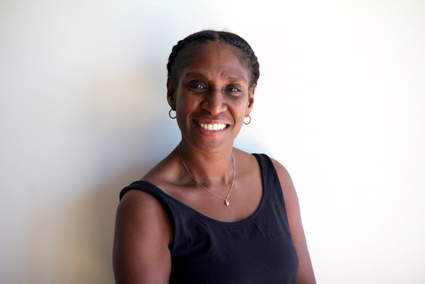
Elma Kris
photo Tiffany Parker
Elma Kris
ELMA KRIS WAS RAISED ON THURSDAY ISLAND AND IS A DESCENDENT OF THE PEOPLE OF THE WESTERN AND CENTRAL ISLANDS OF THE TORRES STRAIT. SHE IS ONE OF BANGARRA DANCE THEATRE’S LONGEST SERVING PERFORMERS AND CHOREOGRAPHERS. KRIS’ LEADING ROLE IN MATHINNA (2008, 2010) GAINED HER SIGNIFICANT RECOGNITION AS A PERFORMER, MARKING A PIVOTAL SHIFT IN HER CAREER.
The company, under the leadership of Stephen Page, has been responsible for the development of many Indigenous performers and choreographers. Page recognised Elma Kris’ capacity and empowered her to make the transition from performer to choreographer.
When we talked in April 2014, Kris provided a deeper insight into the relationship between culture and dance from a Torres Strait Islander perspective. Her use of language to describe the importance of story and closeness to country in this relationship is simple but evocative and poetic. We discussed her training as a dancer, her second choreographic work for Bangarra, About (2011), and a current project that she is still in the process of developing.
Kris is grateful for her five years of training at the National Aboriginal Islander Skill Development Association Dance College (NAISDA), which provided vital stepping stones to her career with Bangarra. This training provided her with opportunities to “grab onto” cultural knowledge and traditional teachings of dance through cultural tutors who are drawn from specific communities around Australia and who engage the dance students in immersive workshops. Her experience with NAISDA allowed Kris to “nurture myself for my culture.”
Growing up, Kris only ever observed cultural events such as song and dance being performed by her parents or elders of neighbouring islands as she was not called upon to participate. Through the cultural tutors, NAISDA enabled Kris to experience the diversity of the Torres Strait dances and their link with musical patterns and rhythms through the study of both music and dance. “I think coming to NAISDA and seeing similar dances performed… [I was] able to connect with our culture… not only that, it was my first time to actually pick up an instrument and learn how to play it,” she says. Among these instruments were the Warup drum and Kulap rattle, which are both used to accompany dance in the Torres Strait Islands.
Kris is a powerful dancer who is able to evoke strong emotions directly through movement. In About, the first segment of Bangarra’s 2011 production Belong, Kris recreated the visceral experience of the four Torres Strait winds named Zey, Kuki, Naygay and Sager. This was inspired by her parents’ perspective: “This is what mum and dad used to talk about—the winds… their moods, what they do and how we respond and how they paint the sky and land, and how they can make the sea very calm.” She describes how the foam on the beach indicates the violence of the wind and “how the wind will rattle the sea a little bit to make different type of winds.” As a choreographer, coming directly from the rich heritage of Thursday Island, Kris is able to combine her deep cultural knowledge with contemporary artistic expression to create evocative dance theatre in the Bangarra style.
She explains that her choreography is inspired “by something way back home,” which usually emerges from stories passed down to her as a child. “A lot of stories are told that constantly remind us about the spirituality of land, the sea and the sky… and how we’re connected with the environment. They can’t speak but they can show signs and colours, whether it’s aggressive weather or whether it’s good weather.”
In About, there is a profound spiritual resonance in the way Kris is able to recreate the feeling of the Torres Strait winds embodied in the dancers’ movements and supported by David Page’s score. She enacts an extension of traditional cultural transmission by engaging with Indigenous knowledge and customs through the mode of contemporary dance theatre. Kris’ stories invite spectators to engage with and understand the value systems of Indigenous Australian cultures that are presented in ways both evocative and direct. She hopes this gives Indigenous Australians the inspiration to connect back to their culture. At the same time, there is a large emphasis on the importance for non-indigenous Australians “to understand as well… because they’re in darkness without any way of knowing how to connect.” So, Kris’ work reflects Bangarra’s vision to preserve culture through sharing it.
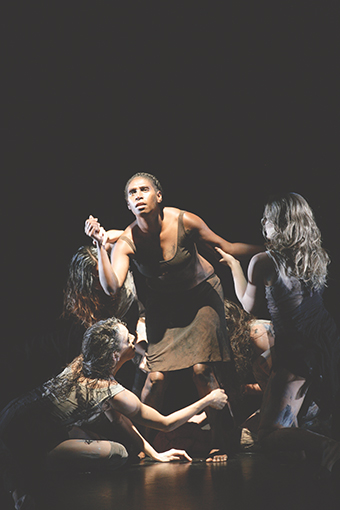
Mathinna, Elma Kris and the Women’s Ensemble, Bangarra Dance Theatre
photo Jeff Busby
Mathinna, Elma Kris and the Women’s Ensemble, Bangarra Dance Theatre
In 2012, Kris was given the opportunity to affirm this vision when she was invited to become a part of the “Engaging Objects: Indigenous Communities, Museum Collections and the representation of Indigenous Histories” project. Consequently she has been involved in extensive research over several years which will culminate in an exhibition in 2015, part of the Encounters project, a collaboration between ANU and the British Museum. Kris will be one of the Australian National University ‘fellows’ who have been asked to engage with key objects from the British Museum’s Australian Indigenous Collection dating back to the 1800s. The resulting contemporary responses and experiences will be a part of the final exhibition. Kris is the sole Torres Strait Islander performing artist working on the project and sees her role as an opportunity to use dance as a vehicle to re-awaken these objects.
At the foundation of the deep spirituality of Elma Kris’ life and creative work is her ability to connect past with present—in Engaging Objects, she tells people about significant objects that have appeared in dreams: “Do you know when you dream and something comes to you in another way and it actually wakens you and it awakens itself to you… and then you ask: What was that? What was I woken by? What was its purpose? Why? So it’s this spiritual thing that comes through your dream and it gives you the ability to waken these other [objects].”
Nonetheless, Kris acknowledges the necessary restrictions of culture, such that only people of a culture are able to access specific knowledge: “there are certain things that we are allowed to awaken or we can’t awaken unless we have gathered protocol[s] to be able to tell it in the deep ways of it… [and] there are things you don’t want to exploit. It’s more about engaging with it and being able to tell a story.” This has prompted Kris to focus on the “awaken[ing] of things that are intrinsic to the woman…” throughout the life of the project. “I wanted to actually engage with a lot of the women’s stuff: to actually express how in our society it’s so important to be able to engage with these objects that have been taken away and how we can preserve them and bring them back… So that way, we are still able to practise things such as weaving baskets because we still need to [continue these] practices.”
Elma Kris has chosen four culturally significant objects that hold intrinsic feminine importance to traditional Torres Strait Islander practice from the British Museum collection. Her contemporary narrative response to these objects will be expressed in a short film featuring Bangarra dancers in an exhibition at the National Museum of Australia in Canberra, November 2015.
For more about Elma Kris visit: http://bangarra.com.au/people/dancers/elma-kris.
RealTime issue #124 Dec-Jan 2014 pg. 32
© Rianna Tatana; for permission to reproduce apply to realtime@realtimearts.net
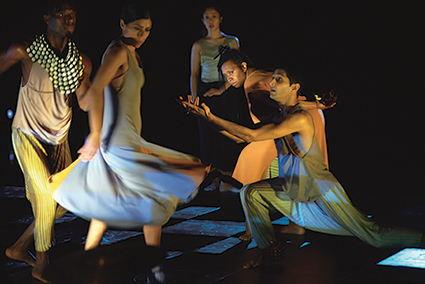
Mother Tongue
photo Shane Rozario
Mother Tongue
SIX DANCERS, NATIONS AND CULTURAL STORIES STAND SIDE BY SIDE DOWNSTAGE, LOOKING AT US, US LOOKING AT THEM. WE SEE THEIR WORLDS OF DIFFERENCE. SPACE HELD EQUIDISTANT BETWEEN. THE FRIEZE IS A STRIKING EMBLEM, MARKING CHOREOGRAPHER ANNALOUISE PAUL’S COLLABORATIVE APPROACH TO INTERCULTURAL DANCE, MUSIC AND ART MAKING.
Tellingly from this first image (returned to in the closing moments) the individual cultures, dances and rhythms are authentically retained. As intercultural dance goes, this approach is in ‘collision’ with new forms, not a blurring or leaking inbetweeness or hybridity—though Western training is clearly in these bodies too. Paul is well defined in her aim. The questions are what and where are these “new futures” she sees emerging as “world cultures collide”? Are they choreographic, or more deeply human? Are their “sacred geometries,” as Paul puts it, universals that transcend uncompromised cultural specificities?
Pivoting at right angles, each dancer breaks free of the line. Clapping begins. Bodies as percussive instruments: skin on skin, thudding, slapping, cupping air in palms, scraping, pausing, sonic codes of communication. Many tongues speak at once, sometimes listening, sometimes responding and initiating. The structure and nuance of clapping is as varied as the body and intentions of the person who claps. Played hard and soft in relative degrees we see how dialogue of any nature might be possible.
A chequered grid is projected centre stage in ‘Atari’ neon green, drawn over in chalk then mysteriously numbered. Costumed in same fabric and styled to suggest their traditional dress, dancers Andrea Adidi, Geraldine Balcazar, Aletta Fauzi, Patrick ‘Lucky’ Lartey, Gregory Lorenzutti and Govind Pillai assume positions in the grid, taking turns to posit or provoke a gesture, spin or leap. Like jazz musicians they solo, challenge for space and movement intensity in competitive jams or move together in isolable, individuated frames—a spectacular aviary of limbs flicking, pounding, arching, reaching and bobbing.
Kinetically, Mother Tongue is a sculpture park of rich, exotic forms coming from Torres Strait, Chile, Indonesia, West Africa, Brazil and India. A distinct difference between genders exists in the dancers’ use of space, weight, gesture and focus. The relationship of pelvis to the ground: shifting high and low for the men, contained and horizontal for the women. All styles sprout an ornamental display of head, arms and legs floating or flung from a chest buoyant and open toward nature and the heavens, face alive, engaged for interaction.
Clapping with vocal percussion becomes a careful conversation. Sitting in a semi-circle, flesh and floor become prime surfaces for polyrhythmic play forming on tongues, deeply in throats and on hands. Percussionist Tim Foley roams the globe to join the assorted chatter of nation leaders articulating their individuated timbre, tempo and tone in a united score.
With indubitable enjoyment we share in the exciting motion, shapes, forces and textures of these places embodied by these dancers. Since Paul does not innovate from appropriation, strict fusion or exploding traditions, and maintains the integrity of colliding cultural forms, her seeking “new choreographic futures” for intercultural dance proves an admirable challenge. There are moments in Mother Tongue when movement and gesture founded on the primordial geometries of collective motion and sound sublimely commune towards a unique horizon.
Mother Tongue, choreographer Annalouise Paul, performers Andrea Adidi, Geraldine Balcazar, Aletta Fauzi, Lucky Lartey, Gregory Lorenzutti, Govind Pillai, music Tim Foley, Greg Sheehan, lighting Toby Knyvett, costumes Tobhiyah Feller, Art Saranjit Bird, Bangarra Dance Theatre, Sydney, 3-5 Sept
RealTime issue #124 Dec-Jan 2014 pg. 33
© Jodie McNeilly; for permission to reproduce apply to realtime@realtimearts.net










































































